

Travel regulations for foreigners in Xinjiang
Xinjiang, the Far West of China is an incredibly beautiful land. Yet it is not a famous tourist destination, but rather an off the beaten path area. Although the tourist invasion is slowly increasing, by visiting it is too far from places like Paris, London, Venice, Taj Mahal, New York, and even the Great Wall of China. There are many reasons for that, and one of them is the travel regulations in Xinjiang, or at least what the foreigners have heard or imagine about it. And indeed, it is not as simple to travel there as in the other provinces of China. But it doesn’t mean that it is impossible or extremely complicated. Let’s learn more about it.
Table of Contents
Travel experience in Xinjiang
Xinjiang has attracted me for many years, as soon as I learned about what this land has to offer. I wanted to cross it from west to east, on some of the Silk Road routes. I also wanted to explore it in details. But I have heard that it is not so simple and there are a lot of restrictions. I didn’t know is it safe, or is it easy to be caught by the police for something that I could be unaware, or just to be not allowed to travel here or there.
Checking in the airport
The first time I visited Xinjiang was when we back to China from Kyrgyzstan by plane. We landed in the capital Urumqi at noon, and we had several hours to our train to Changsha in the eastern part of China. Initially, we wanted to use these hours to walk around Urumqi and visit at least 1-2 tourist sites.
So, when we arrived in Urumqi Airport, we had more than an hour to go out, because I had to pass through at least two checks in and registration points. Finally, we went out of the airport and took a taxi to the railway station, because we wanted to leave our luggage there while walking around the city. But again, before arriving there, we were stopped by the police for another checking- again at least for 15 mins. And to enter the railway station itself, passing through a few more checkings, took us another 30 mins. So finally we just gave up and decided to rest inside.
Checking in the railway station
Then, one year later (July’2019) we were in Xinjiang again. This time we built our own itinerary, aiming at some of the most important and popular places there. Our first stop was Turpan , where we arrived by train, at Turpan North Railway Station.
At the exit, two local Uyghur policemen stopped us, and one of them told me to follow him to the nearby police station. He took our passports and gave them to a third Uyghur policeman who entered in his room and we had to wait outside. After 15 mins waiting he appeared again and tried to ask some questions- the reason why we come to Turpan, where will we sleep, when will we leave and where will we go next. These few questions took another 15 mins, because he couldn’t speak English, and his Chinese was very poor too. Anyway, they all were very polite and smiling, and finally, let us go.

More checkings
Later, during our trip in Xinjiang, we had such checking whenever we enter a city and get on or off a train. There were checkings on all highways and lesser roads, so when we traveled by car, we had to stop in every checking and wait for the policemen to input all our passport information. Which was every time slowly, because it was always difficult for them to read something different than Chinese or Uyghur language.
Travel in the „normal” Xinjiang
So, what we knew is that most of Xinjiang, maybe around 80% of its area was under strong control, stronger than in the other parts of China. But that was all. Everything else was free for travel, and no matter how do you travel- by plane, by train, by bus, by car or by horse, just have to show your passport in a checking point and be patient. It is good to tell them your clear plan- when will you sleep, when will you leave, what is your next destination. But even if you can’t, that’s no problem, just it is possible to wait a long time.
When we passed through one of the checking points, a policeman there was very helpful, and he explained to us that there is a way to shorten our waiting in the other checking points. Just have to go to Urumqi and obtain something like a travel certificate. Then, when we show it in every checking point, we can wait only a few mins, instead of 15-20 mins. We were not in a hurry, so we didn’t try it.
However, there are some areas in Xinjiang which are not such easy to travel…
Special areas in Xinjiang
Fortunately, these areas are much smaller than the „free” travel area of Xinjiang. But at the same time, unfortunately, these areas are established in some of the most beautiful and breathtaking places of the province, which means: you can’t just go and enjoy this beauty freely!
Border areas of Xinjiang
Shortly, this is the whole strip of territory along the border between Xinjiang and all the other neighboring countries, out of China. In general, this territory has a special, strengthened regime of visiting and traveling.
But at least for now, it is not the same everywhere. Some border areas are more restricted than others. Especially those who border countries like India, Pakistan, Afghanistan, Tajikistan, and Kyrgyzstan, which are considered „riskier”.
Karakoram Highway in China
And one of the most beautiful areas in Xinjiang- the Karakoram Highway in Pamir, is located in such area. Until the last year, foreigners could travel there freely. But not now. From 2019 foreigners can travel there only by a licensed travel company. Yes, for many it can be sad and disappointing, but that’s the reality, at least for now.
The travel center in Kashgar
If you want to travel from Kashgar to Tashkurgan, you have to visit the travel center in Kashgar and apply for a travel company there, which can help you to obtain the necessary travel permit. You can’t obtain this permit by yourself. And they will tell you that you must apply for it at least 3 days before your trip to Tashkurgan!
However, usually, there are always some travel companies’ representatives who can reach you and tell you that they can arrange it for you faster, so you can go on a trip right on the next day. And they say the truth actually because this is how we traveled to Tashkurgan- we applied for this trip and on the next day, we were on the bus on the Karakoram Highway. And in general, their service was really satisfying.
But the price for foreigners is much more expensive than for the Chinese. The Chinese had to pay something around 550 CNY per person, and I as a foreigner had to pay 1300 CNY! Our children who have a foreign passport paid half of the price. And this was one of the cheapest companies, there were even more expensive offers!

Include a travel insurance as a part of your trip preparation by pressing the button below:
Our trip to Tashkurgan
Then, following the travel group in our minibus, we made our 2-days trip to Tashkurgan. There are 3 checkpoints from Kashgar to Tashkurgan. The first is still in the lowland, the second is in the middle of the gorge of Gaizi River, and the third is just several kilometers before Tashkurgan. And the most serious check was at the second one (and our guide especially told us to not take photos there). But, since we were following the travel company, everything was normal, just like any other normal checking in the rest of Xinjiang.
Book a trip on the Karakoram Highway!
Other beautiful places, located in the border area are Shipton’s Arch near Kashgar, Xiate Ancient Trail, Sayram Lake, and Kanas Lake. The situation about the Shipton’s Arch is the same. A foreign couple tried to reach it independently but were stopped and let them back to Kashgar.
Book a trip to the Shipton's Arch!
As far as I heard, currently, in 2019, foreigners still can go freely to Sayram Lake and Kanas Lake. But not to Xiate Ancient Trail- even for Chinese, it is closed to hike independently, but only by a licensed company. They say that it is due to „safety precautions” because they claim that the trail is dangerous. But in fact, it is not more dangerous than the other famous trails in Tianshan, in the interior of Xinjiang.
Crossing the border to or from Xinjiang in China
There are some border crossings to the neighboring countries, as follows:
To Mongolia
For foreigners, there is only one border crossing between Mongolia and Xinjiang. This is Bulgan-Takashiken. There are three more border crossings, but two of them are only for Chinese and Mongols, and the third is only for freight.
No border crossing from Xinjiang. Although there is a short border section between China and Russia on the Altay Mountains, nobody can cross it.
To Kazakhstan
There are 4 border crossings which can be used by foreign travelers too, in both directions. And there are 3 more border crossings but restricted only for locals, or currently not in operation.
To Kyrgyzstan
There are 2 border crossings between China and Kyrgyzstan: These are Irkeshtam and Torugart. Torugart is a famous pass, a dream for many travelers. But until now it remains very difficult to pass. Irkeshtam is a little bit easier but still complicated.
To Tajikistan
There is only one border crossing- Qolma Pass. It is opened for foreigners just recently and is complicated for crossing.
To Afghanistan
No border crossings for foreigners. There is one crossing- Wakhjir Pass, but currently completely closed for everybody.
To Pakistan
There is only one border crossing to Pakistan. This is the famous Khunjerab Pass, on the Karakoram Highway. From 2 years ago it is highly restricted for crossing or just visiting.
Actually, this is Kashmir. Since Kashmir, bordering with Xinjiang is a disputed area between India and Pakistan, there is no border crossing.
Obviously, to reach the border crossings, you have to pass through the border areas. Various border crossings have various levels of restriction. We met a couple of foreigners who have entered China (Xinjiang) from Kazakhstan by train through Khorgos, without a problem.
Difficult border crossings
But some border crossings are really difficult. I mentioned Torugart between Kyrgyzstan and China. In 2018 we tried to cross it from Kyrgyzstan. But we were told that first, we had to obtain a permit in Kyrgyzstan side (which was easy). Then we had to contact a travel company (we found Silk Road Tours) in China, which can arrange another travel permit for Xinjiang side, and an expensive private car with a driver to wait for us on the border. It was too complicated so we gave up.
However, many foreigners have tried to cross it and were stopped and sent back. And as I know, now the situation is quite similar to Khunjerab between Pakistan and China. Until recently, it was possible to just reach the border and make a photo at this notorious mountain pass. Now you can’t unless you are preparing to cross it (with all the necessary documents and other travel details).
Besides, most of the border crossing are often closed, especially in winter. Their working time is highly limited, and the closures often happen without warning. Here you can see the map of all border crossings of Xinjiang.
Special autonomous areas
Yes, there is an area in the interior of Xinjiang, far from the border, which is not as the other „normal” areas. This is Hejing (和静), a Mongol Autonomous County, known as the „most bordered county in the world”. And some of the most spectacular destinations in Xinjiang are located within it- Bayan Buluk on Du Ku Highway, Tekes, and a part of Wusun Ancient Trail.
I have a Chinese driving license, so I can drive a car in China (including Xinjiang). After our trip on Du Ku Highway, I have read an article in a website which says that foreigners, even with a driving license can’t drive there freely, but must obtain a travel permit for the area.

Our experience on Du Ku Highway
At that time I didn’t know it and we traveled on the whole Du Ku Highway, from Kuqa to Dushanzi without any problem. Nobody stopped us. In fact, there is only one checking point near Narati Grassland. The policemen saw me, the driving foreigner, and didn’t even stop me for registration, just said to everybody to pass quickly, to avoid traffic jam.
No independent foreigners in the tourist sites
Yes, there was another problem in this area. We arrived in Bayan Buluk and wanted to visit the Bayan Buluk Grassland and Swan Lake. The people at the entrance told us that we have to go to the travel center and buy tickets from there. So we found this travel center, in the other part of Bayan Buluk town, and I entered inside for tickets.
But a policeman there told me that this area is not opened for foreigners. The only way to visit Bayan Buluk Grassland is to go to the travel center in Urumqi and obtain a travel permit there. Not only that, but he said that we must leave the town within 30 mins, otherwise he has to call the other policemen and to ask me a lot of questions. He apologized that it was not him who created these regulations, but we all haven’t a choice and have to obey.
So, we went outside of Bayan Buluk town, just a km outside. There we found a nice grassland with horses, sheep, and cows, and enjoyed the stunning landscape for almost 2 hours. No checkpoints around, nobody came to check me, we were completely free.
No hotels for independent foreigners
Before we traveled on Du Ku Highway, we were looking for a hotel in Bayan Buluk. There wasn’t any hotel there which could accept foreigners. We felt strange about it, and when we met the policeman, we understood why. Anyway, since the road was temporarily damaged by a small landslide, we spent the night in the car, waiting for the dawn to proceed.
So, to conclude- foreigners CAN travel on Du Ku Highway, Tekes and Wusun Ancient Trail (if not closed for other reasons), but CAN’T sleep in hotels there, CAN’T visit Swan Lake of Bayan Buluk Grassland (and maybe can’t visit other travel sites with entrance ticket too) independently, and are required just to move quickly. But since there is only one checking point, and normally no policemen check people randomly, foreigners can sleep in cars, in tents, even in some local yurts without problem (although technically it is not allowed).
Other travel limits in the „normal” part of Xinjiang
We faced such limits when we drove a car from Kashgar to Maigaiti N39 area of Taklamakan Desert. Basically, this area is free. There are 2-3 checking points, but they are just normal. Initially, our goal was not Maigaiti, but Karsu- another place at the edge of Taklamakan Desert near Kargilik (Yecheng).
But when we arrived at the last checking point before Karsu, the policemen politely explained that just that day there was a „special activity” in Kargilik, so foreigners are not allowed to proceed further. If I really want to visit Karsu, I was welcomed to come again several days later. But now I had to leave, and they advised us to visit Maigaiti N39, which was free to travel.
So we visited Maigaiti N39 instead. The road passes through a nice and beautifully decorated town, and we wanted to take some photos of the houses. Then, at that moment, a policewoman called us and warned us to NOT make any photos in the area, but only in the desert. There was another small checking point and the local Uyghur policemen didn’t register me, but also told us to not take photos.

Forbidden areas in Xinjiang
There are such areas too. You will not see them marked on any map, but they exist. Usually, these are military areas or secret areas of other kinds. Initially, we planned to visit an ancient village at the edge of Taklamakan Desert, called Luoburen (or Luobu Man), not far from Korla. But when I mentioned it to the Chinese girls of our Kashgar hostel’s personnel, they told me to forget to go there. It is completely forbidden for foreigners. They said that they indeed were there, but only by a travel company, and were not allowed to take any photos.
As I know, there are other forbidden areas in Xinjiang, mainly in the border areas, or near Lop Nur area. And since it is difficult to find any information which are these places and where you can reach to their entrance and be stopped by the local police. They will not arrest you, but just politely will tell you that it is closed and you have to back. That’s not a serious problem, unless you may lose precious time and waste money to reach the place.
The area at the border with the Tibetan Autonomous Region
It is another difficult area. You can see southern Silk Road highway from Kashgar through Hotan, Qiemo, and Ruoqiang to Xining. This road is opened for foreigners. But only several kilometers south of the road, and south of these cities, foreigners are not allowed to travel free. Although the Tibetan Autonomous Region (TAR) is not another country, but a part of China, this area has even more strengthened regulations than the other border areas.
This area is, in fact, the wildest part of Xinjiang. Only one road crosses it, in direction to Lhasa in Tibet- this is the „heavenly road” G219, starting from Kargilik (Yecheng). There are only a few other roads which enter in the area, but not go too far and end in the mountain wilderness before even approach closely to Tibet.
If foreigners want to travel there, it could be possible only by a travel company, obtaining the necessary travel permit. But since these places are not a popular tourist destination like Tashkurgan, it would be much more difficult to find such a travel company. And it would be much more expensive. And that’s not all…
Special natural areas
There are also some special natural areas, which require more travel permits, and some hired personnel with you.
High mountain peaks
Every mountaineer and most mountain hikers know that. It is not only in Xinjiang, but everywhere in the world- the high mountain peaks are expensive. There is a mountain climbing tax which you must pay if you want to climb it. The higher is the peak, the price is more expensive and can reach even tens of thousands of dollars.
Muztagh Ata (7509 m) is well known as the easiest 7000-er, as it doesn’t require mountaineering skills and gear. You can just walk to the top, being aware only of the high altitude sickness and the harsh weather conditions. But again, apart from the fact that it is located within the border area of Tashkurgan, you must also obtain a climbing permit (which fortunately is not too expensive).

Natural reserves
Most of the area right beside the border with the Tibetan Autonomous Region is not only restricted for foreigners like a „border area”, but also is a part of a natural reserve zone. So it also requires a special (and extremely difficult to obtain) permit, which is also very expensive.
If you want to climb Ulugh Muztagh, be ready for at least 3 travel permits. The first one is the border permit. The second- the natural reserve permit. And the third- the climbing permit. In total it may cost you more than 10 000 USD (as far as I know) if you can get all these permits at all. Then, you have to pay also for mandatory guides with you- for their salary and all other daily expenses. And since this peak is extremely difficult to reach, you can imagine what are you going to prepare for…
Aksai Chin is a small area, which is not completely forbidden, but is very complicated (and expensive) for foreigners to enter. That’s because it is a disputed area between China and India. It also borders the Tibetan Autonomous Region.
Since the „heavenly road” G219 from Kashgar (Kargilik) to Lhasa crosses Aksai Chin, this is the only way to enter this area. When you are inside, everything on your left and your right of the road is completely forbidden for foreigners. So it is possible to cross it only if you join an organized tour from Xinjiang to Lhasa.
Unclear and changeable at any time
Yes, that’s what I found when I traveled in Xinjiang. Normally, we foreigners would not be happy with these restrictions, and it is obvious. But at least we would like to know clear, in advance- where can we go freely, where we can go only under certain restrictions, permits, and other requirements, and where we can’t go at all.
Unfortunately, you can’t find any website or any other source of information, presenting all these regulations clearly. There is no such full information even in Chinese. Not only that, but most of the policemen, even the officials don’t know everything!
“Maybe” and “I think”
When we were in Xinjiang, we asked everywhere, every day various people- the personnel in the hostels, the policemen, drivers, even travel companies, questions like „Can we go there? Can we rent a car? Can we visit this or that place?”. And the answers were usually: „I think you can.” or „Maybe you can’t”. But „I think” and „maybe” doesn’t work for me, I still can’t plan a clear travel itinerary, based only on such proposals.
Even the officials not always know
Only when we went to the travel center in Kashgar, we were told for 100% certainty that foreigners can visit Tashkurgan ONLY by a travel company. And even there not everybody knew it!
Yes, I tried to apply for a travel permit independently, waited 10 mins on a queue and when arrived at the counter, the man said: „ok, give me your passport.” I was happy that seemed like I can obtain a travel permit to Tashkurgan and can travel there independently. He took my passport, started to input the data on his computer and when he found difficult to input some English words, he asked his colleague. He was almost ready with the permit. And then his colleague stopped him and said: „but he is a foreigner, you can’t give him a travel permit, he must apply for a travel company!” Yes, two officials working in this travel department, and even not all of them knew the regulations!
More ideas and proposals
I also talked with a guy from a travel company, asking him about various travel routes outside of the „normal” part of Xinjiang. I asked him about traveling from Xinjiang to Lhasa on route G219. And he told me something very strange. He said: „You can’t go there independently by self-driving. You can’t even go there by rental car with a local driver. But you can go there…by bike, by horse or on foot only! Because cars have to be registered, while bikes and horses- no.” And he was really serious.
He also said that if you just pass through this area transit, while traveling from Kyrgyzstan to Nepal via Xinjiang and Tibet, by foreign car, it is possible too! Of course, I strongly doubt what he told me, anyway, still kept it in my mind. Because I already knew that it is hard to find someone who knows the regulations 100%.
And not only that, but these regulations can be changed without notice at any time, unfortunately, toward more strengthening! Maybe this is the reason (or at least one of the reasons) why many people which is supposed to know the regulations, actually, don’t know.

Yes, why we foreigners can’t just travel freely and enjoy the stunning nature everywhere without limits? Just like in Western Europe or America? What wrong are we doing? We are just travelers, we would not harm anyone. We just want to explore this beautiful land, then leave without being involved in anything inside.
I had such questions when I was in Kashgar and wanted to make a trip to Tashkurgan. And maybe many foreigners have the same questions too. So I tried to ask the local Chinese- „why, for what reason?” If it has been free for us to visit Tashkurgan, why they changed it and created this new regulation for us?
And it was very difficult, almost impossible to get an answer. I live in China for many years already, and I know the Chinese traditional way of thinking. They don’t ask questions too much and don’t think too much (and no, it is not from recent years, it is a part of their culture since many centuries). If „someone from above” orders something, they just accept it.
Just accept it
So, why we foreigners can’t travel freely to Tashkurgan? „You just can’t, that’s it.” Is the normal answer. If I insist asking, they keep answering: „Just accept it, it is useless to ask.” In fact, they also don’t know, and don’t care „why”.
Anyway, after many attempts to get some answer, finally one of the policemen said something like this: „It is for your safety. Because foreigners walking free around Tashkurgan don’t know where is the border exactly. There were accidents in which foreigners have been caught on the border because they were lost.” I don’t know whether it is the real reason, but anyway, I couldn’t get more explanations from anybody.
What if…
No, don’t think about it! Yes, some „rebel thoughts” passed in my head. „Can I secretly go around the checking point and silently appear at the other side?” or „The mountains are so big and wild, what if I just „crawl” to the restricted zone behind the checking point? Nobody could see me. I am not doing anything wrong, after all!”
But no, that’s not what we may think. It is the same as you try to cross illegally through a border between two countries, without passport and visa, and not through a normal border crossing. And if they catch you, you will have serious troubles, like staying in jail or be accused as a „foreign spy”.
Understand the regulations
Yes, we are „not doing anything wrong”. But it is like you drive a car and cross on the red light „very carefully”, and pass successfully without an accident. Not only in China but everywhere in the world, although „you didn’t do anything wrong and didn’t harm anyone”, you will still be punished.
Because these regulations are designed for precaution. You may not do anything wrong, and many other foreigners too. But as it is well known, Xinjiang is a place with some tensions. I would not comment on who is right and who is wrong, because nobody is 100% white or black in Xinjiang. If 9 foreigners don’t do anything wrong, the 10th may do, trying to involve in these tensions. And if you can go freely in the restricted areas, why the 10th one can’t?
So, the best we can do is just to accept the reality in Xinjiang as a basic foundation of our trip. Then having them in mind, we still can enjoy all that this incredibly beautiful place can reveal!
Let’s get some more impressions of Xinjiang!
Check out some travel books about Xinjiang!

Disclaimer: Journey Beyond the Horizon is a participant in the Amazon Services LLC Associates Program, an affiliate advertising program designed to provide a means for us to earn fees by linking to Amazon and affiliated sites at no additional cost to you.
Like it? Pin it here⇓! Follow us in Facebook , Twitter and Instagram !

Hi, we are Krasen and Ying Ying. Krasen is from Bulgaria, and Ying Ying is from China. We are passionate about geography and history, and we believe that the best way to experience it is by exploring the Earth in reality, not in a school, and not virtually.
So, we created this blog Journey Beyond the Horizon, where we share geographical knowledge, travel guides and tips how to experience it when you explore our planet, and a lot of inspiration.
And we wish you a happy journey, not just virtually, but most of all- in reality.
You may also like

There are some roads, called "heavenly roads" by travelers. If you see a road map,…

In today’s world, people are travelling more than ever before. Travel is the most accessible…

Disclaimer: Journey Beyond the Horizon is a participant in the Amazon Services LLC Associates Program,…
Related Posts

TREKKING IN CHUANDIDING, GUANGDONG PROVINCE

EASTERN TIBET ROUTE ULTIMATE GUIDE- Part 1
19 thoughts on “travel regulations for foreigners in xinjiang”.
Dear both, thanks for the lot’s of efforts , writing this article . I’m living since nearly 30 years in Shanghai, got the Chinese drivers licence and even a greencard ( Chinese passport) but even with this I’m not allowed to drive myself in Tibet Reading your article, Xinjiang seems also too restricted. A roundtrip Shanghai- Kashgar- Lhasa- Sha by car was one my dreams but impossible . Can you tell me if entry by car from Qinghai is possible? Furthermore, when would be the best time for a visit outside the Chinese summer holidays ? Thanks in advance Eberhard

Hi Eberhard! Yes, Xinjiang and Tibet are some of the most beautiful and exciting regions in China. Xinjiang is opened for foreign drivers with Chinese driving license, I (Krasen) myself have drived around Xinjiang without problems, at least in these parts that are not restricted. There are only multiple checkpoints where you have to register, but this is not a problem. On the other hand, Tibet is different. It is not allowed for foreigners to travel there independently. Probably, it is possible for you to drive in Tibet, but only with a local licensed tour guide who can arrange travel permit and should be with you in the car- probably, this would be expensive, you have to check which licensed travel company can offer such service. This is no matter where would you enter Tibet from. Kashgar-Lhasa-Chengdu is my dream too, and I recently heard that the section Lhasa-Chengdu (passing through Chamdo) is finally open for foreigners (it was completely forbidden, even with an organized tour, but seems now it is open for organized tours) which is a good news. But again you still can do it only by organized tour (you drive or they drive). I think the best time to visit Tibet, outside of the Chinese summer holidays is May or September. Yes, it is not so green at that time, but at least not too cold and with much less tourists. Wish you enjoy the best of Tibet and Xinjiang!
This article on checks and restrictions is way way way out of date. I suggest you rewrite the whole thing, it is giving a very misleading impression.
Yes, this was the situation in 2019. Now is the end of 2023. If you know some new useful information about Xinjiang that I don’t know, feel free to share in the comments, or write email to me personally. Every new information would be welcome.
Hi Krasen, I really enjoyed read your blog. I’ve plan to go to Xinjiang, but I want to use the local travel company. And I saw in the comment, you have a friend that have travel company in Kashgar, could you give me his/her contact? Thanks!
Hi Anabella! Yes, actually, I know two travel companies in Xinjiang, and I know some people from these companies. The better one is Silk Road Tours. They organize trips not only in Xinjiang, but also in other parts of China. Currently, the situation there is unstable, you don’t know when a destination can be unexpectedly locked due to Covid, but I advise you to contact them. This is their website with contact: http://www.silkroadtravel.com . Wish you a wonderfull trip in the beautiful Xinjiang!
hello, may I ask how old is this article? my wife (Chinese) and I want to go to Xinjiang in the first 2 weeks of August … best regards, Franz 🙂
Hi Franz, this article is from 2019. As I heard from other travelers recently (in 2021), the things haven’t changed much, except some new closures due to the Covid pandemic. In general, the capital Urumqi, some other cities like Turpan, Aksu, Kashgar should be open for foreigners who are currently living in China. For your wife everything will be easier, unfortunately, the fact that she is Chinese can’t help you much (as it was in our case), but at least she can communicate with the local authorities in various situations (at checkpoints, etc.). Anyway, we still have some Chinese friends in Xinjiang and we will try to ask them these days and I will write in the comments again. 🙂
Hi again Franz, I just contacted a friend from a travel company in Kashgar. He confirmed that foreigners can travel freely around Xinjiang, except in the restricted areas (border areas, Tashkurgan KKH, etc.). In other words, seems the situation described in this article is almost the same as in 2019 (if there are some minor changes, they are temporary closures due to the Covid pandemic, unfortunately this is unpredictable).
thanx a lot for double checking! I think with our itinerary we should be fine, as long as Duku is not overcrowded with cars, what I heard just is the case recently … do you have a more detailed description of what “special areas” are? many thanx and much love, Franz
Hi Franz, by “special areas” we mean places with more restrictions than normal. For example, unfortunatelly, Duku Highway is in such “special area”- they don’t allow foreigners to sleep in hotels there, or to visit the official tourist attractions. They only allow foreigners to pass through Bayan Bulak, the main city on this route, and foreigners can’t stay there more than 30 min. But, technically, you should not have a problem to sleep in a yurt (ger) on the way, out of this city, at least nobody will check. When we were there, we traveled on Duku for 2 days and spent the night just in the car (but for other reason- there was a mudslide and we had to wait the workers to repair it, so we couldn’t proceed further), but we heard about other foreigners that spent the night in a yurt. Wish you a great journey in Xinjiang, and we will be glad if you share in the comments about your experience after the trip! 🙂
I see, thanx for the heads up, yeah I will let you know how it all went <3
Hi we decided to cancel our trip to Xinjiang, due to the reason that it is super hot even in the north and if we cannot get a hotel, to sleep in the car when it s too hot or not knowing whereas to sleep we don’t think it’s a good idea. Another reason is that at the moment it takes 9 hours to ride 100km on Duku highway. All of that made us change our plans. Will just go to my wife’s hometown in Hunan and maybe nearby provinces (Hubei). Best regards, Franz <3
Hi Franz, sorry to hear that, you would really love Xinjiang, but hope you can find another opportunity to explore it. Hunan and Hubei are beautiful too, just with a different beauty, and a lot of interesting places to see. Eastern Tibet (Western Sichuan) would be a great choice too, because it is in high altitude and the weather is pleasantly cool there (and the landscape is incredibly beautiful). Wherever you choose to travel, wish you a nice and exciting journey! Best regards, Krasen and Ying Ying 🙂
Useful information. Lucky me I discovered your site by chance, and I’m surprised why this twist of fate didn’t came about in advance! I bookmarked it.
I’m travelling to Xinjiang soon and have searched high and low for some good info – particularly Xinjiang’s restricted areas for foreigners. This post is soooo informative THANK YOU so much for sharing your experiences :)
Hi Rachel! I am glad that you find it useful and hope you would not have problems in your trip to Xinjiang. I hope the restrictions there are not hardened (they would use the pandemic as a reason), so you can travel there smoothly. Although this is a bit unpredictable, at least until now I haven’t heard about significant changes. Wish you a happy trip to the beautiful Xinjiang!
Pingback: How to visit Taklamakan Desert- one of the deadliest deserts on the Earth
Pingback: Traveling on the Karakoram Highway in Xinjiang, China
Leave a Comment Cancel Reply
Your email address will not be published. Required fields are marked *
Far West China

Is Xinjiang Safe for Travelers? Security & Threats in 2024
January 13 | No Comments
The most commonly asked question from people who are planning a trip to China’s western region is this: Is Xinjiang safe for travelers (especially now in 2024)?
It’s a legitimate question, particularly since most of what you’ve probably read in the news or heard from friends seems to indicate that you’re putting your life in danger by making a journey to Xinjiang. But is that really the case? Is all of this overblown?
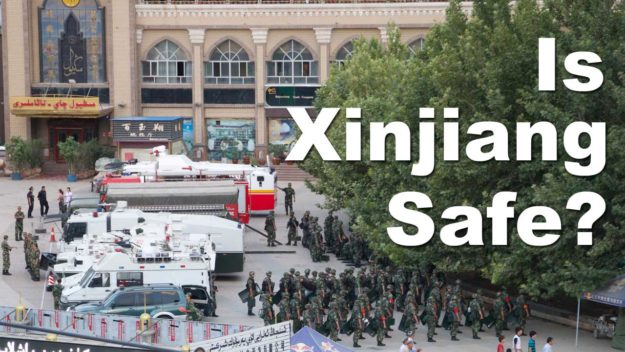
Below, I’m going to walk you through a brief history of what has given this region such a bad reputation, tell you what you can do to keep yourself safe .
Finally, I want to let you hear from other travelers who either live here or who have traveled here.
My hope is that by the end, you’ll be better informed about the situation in Xinjiang and confident in planning your trip to my favorite corner of the world. It IS safe to travel to Xinjiang…and here is how you know.
Are you planning to travel to Xinjiang?
You should grab a copy of my FarWestChina Xinjiang Travel Guide , the most comprehensive, up-to-date guide on the entire Xinjiang region. I’m so sure you’ll find it useful that I’ll even offer you a money-back guarantee if it doesn’t meet your expectations!
Why Does Xinjiang Get Such Bad Press?
When I first arrived in Xinjiang during the summer of 2006, the question of safety and security wasn’t even an issue. Little incidents had occurred here and there but the region didn’t carry the same reputation that it does now.
So what happened that initiated such a change?
My wife and I never felt directly threatened or unsafe
It first started in August of 2008, just five days before the Beijing Olympics were set to start, with an attack on police officers in Kashgar . Security around the region started to intensify but the situation really took a turn for the worse in 2009 with the riots in Urumqi . In both incidents, it’s still not entirely clear exactly what happened or how many people were hurt.
A month after the Urumqi incident, I wrote a short article detailing the changes that were happening around me thanks to heightened security. The trust divide between the Uyghur and Han had widened to the point that many of my Han Chinese friends were scared to travel to southern Xinjiang or even to the Uyghur neighborhoods nearby.
Lately, you’ve probably been reading stories about Xinjiang’s re-education camps . It’s a horrific tragedy for the Uyghur people and I condemn their existence as wrong, but again – it hasn’t posed any threats to foreign tourists. So far, the worst that has happened is questioning at a police checkpoint.
Over the past decade I have not read or heard of one report where a tourist has been directly or indirectly harmed in any incident around Xinjiang.
Is it Safe to Travel to Xinjiang?
So now that you understand better why this question is even asked, take a moment to watch this video to hear my response to the question of safety and security in Xinjiang.
So is it safe to travel here?
The short answer: Yes.
Obviously you need to use common sense like you would anywhere else in the world, but there’s no reason to be looking over your shoulder in every city you visit. The Uyghur people are some of the most friendly you’ll ever come across.
The same goes for solo travelers (even the solo women) and those ethnic Chinese tourists. The best tool at your disposal is a simple smile – it has a disarming effect with most everybody you meet.
WARNING : Having said that, I do want you to understand that what is happening to the Uyghur people is horrific. The result of this cultural genocide is annoying police checkpoints and restrictions on movement. Many travelers have noted that this heightened security put a damper on their travels and if you’re not expecting it, it could ruin it.
So why do I still promote travel to Xinjiang if it seems to support all the Chinese government is doing?
The simple reason is because I believe that the more people who personally witness what is happening and develop a personal connection to the Uyghur people, the better.
Fall in love with the people.
Share what China is doing with others.

Tips to Staying Safe in Xinjiang
Because of all the changes that have happened in Xinjiang, there are a number of things you’ll notice are different when traveling here as opposed to the rest of China. Thankfully, you still don’t need a special permit to enter Xinjiang like you do Tibet, but take note of these tips before you make your journey.
- Ignore the Military & Security Forces : A big difference you’ll notice in Xinjiang is the heavy presence of military and security forces. For those most part, this won’t have much affect on your trip…as long as you ignore them. Pointing a camera and taking a picture is a surefire way to get your camera confiscated or your memory card wiped.
- Expect a lot of Security Checks Everywhere : Whether you’re entering an airport or a mall, there’s a good chance you’ll have to walk through a metal detector and/or open your bag for a check. You’ll have a hard time getting that new Uyghur knife souvenir you bought through many of these checks, though, so make sure you keep those in your hotel.
- Always Have Your Passport : I’ve known some people who leave their passport in the hotel safe while they’re traveling but in Xinjiang, you should have it with you at all times. In fact, I recommend keeping a physical copy of your passport and your China visa in a separate bag just in case you lose your original. While traveling – especially in southern Xinjiang – you might come across a number of security checkpoints where they will require you to show your passport ID and visa.
- Arrive Early for Transportation : Because of all the new security measures, it’s a good idea to arrive even earlier for your flight/train. As an example, before you even enter the Urumqi International Airport , everybody has to scan their bags and go through a pat-down…not to mention the thorough security check before you enter the gate area. Same goes for the train station, so give yourself some extra time so you’re not running to catch your flight or train.
- Expect Delays and Possible Restrictions : Again, due to all the heightened security, it’s normal for travelers to get delayed for any number of reasons. I also get people who ask me whether such-and-such village is accessible to foreign tourists. My answer is always the same: it should be…but that doesn’t mean it will be. It’s all dependent on the mood or strictness of the security guard or local official that you meet.
In whatever circumstance you find yourself, the best way to stay safe in Xinjiang is to use common sense and to be flexible .
Traveler Feedback on Safety in Xinjiang
When it comes to safety in Xinjiang, you don’t have to take my word for it. I’ve received feedback from a number of travelers, including solo female travelers and those with families, who have been through Xinjiang. Here is what they have to say:

Chris Walker-Bush “I don’t think I’ve ever felt as welcome in China as I did while visiting Xinjiang. The farther west I went, the friendlier people became and the more excited to share their culture with me they became. My fondest memories of China were from my time in the far west.”

Ezma “I spent 4 weeks in this area in August 2014. My two children ages 6 and 8 loved every minute. A trip to the heavenly mountain, night markets for kebabs, fishing trips and lots of playing with local children. As a woman with two young children we felt very safe.”

Eric Johnson “We (two families of six Americans) spent a week hoofing it across Xinjiang from its northeast corner to a mountainous pass into Kyrgyzstan which required special permission to cross. We used train, plane, and rental car (sometimes with driver, sometimes self-drive). From vineyards to glaciers, scenery was gorgeous, culture interesting, people everywhere welcoming. We never felt threatened in the least.

Maxime Dossin “Xinjiang is definitely safe for foreigners. I travelled by bicycle in 2013 from Mongolia to Central Asia and had problems only with police, as it was during June-July, when it was complicated in Turfan and Hotan. Policemen erased pictures on my camera, put me in a bus between Balguntay and Yining…but the Uyghurs and Hans were lovely.”

Rod Poirier “I spent a couple of weeks traveling alone from Urumqi through to Kashgar and on to Kyrgyzstan. While out in the region I neither experienced problems nor felt unsafe at any time. Best experience was the Kashgar market.”
Final Thoughts on Safety in Xinjiang
Keep in mind : you will be stopped by police as you travel. You will likely be asked to show your passport hundreds of times while you’re walking around. You will get annoyed by the security state that is Xinjiang.
…it’s safe.
There are certain places you can go in the world where you are taking a sizable risk to physical safety in order to visit. Xinjiang is not one of those places.

Before you buy your tickets, check with your State Department to find out if there are any China travel advisories (not a bad idea no matter where you travel). If there aren’t, then hopefully we’ve been able to convince you here that you are perfectly safe to travel to Xinjiang!
Be safe and if you want more information on travel around Xinjiang, don’t forget to purchase a copy of the FarWestChina Xinjiang travel guide !
- About the Author
About Josh Summers
Continue reading:.
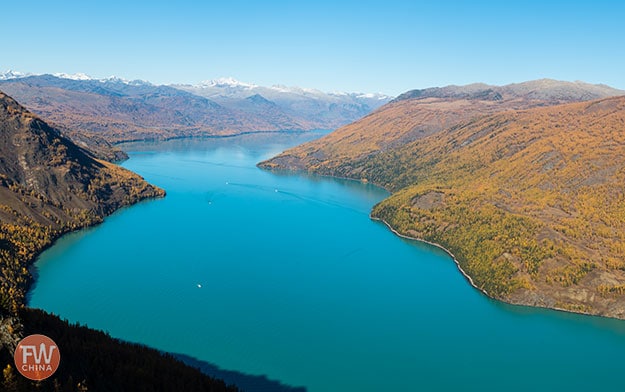
Everything You Need to Know
From city guides to souvenir guides. From maps to hotel recommendations. Everything you need to plan your Xinjiang travel is here.
Free Download “5 Things You Must Know Before Traveling to Xinjiang”!
Get Free Instant Access to this useful resource by entering your name and email below. You’ll also receive monthly travel updates, exclusive offers and travel tips.
©2024 Far West China | Resources | Contact | Privacy Policy

Travel to Xinjiang, China: A Guide for International Travelers
Xinjiang, located in northwest China, is a region renowned for its diverse cultural heritage, breathtaking landscapes, and vibrant ethnic traditions
If you’re planning to travel to Xinjiang you might be wondering how to obtain a China visa, which are the best tourist attractions, where to stay, if it’s safe for tourists, etc.
In this comprehensive guide, you will find essential information for international travellers planning to visit Xinjiang, including highlights of the region, and practical tips for a memorable journey.

Table of Contents
Understanding the China Visa Process
Before embarking on your trip to Xinjiang, it is crucial to obtain the necessary travel documentation, including a valid China visa. Here’s an overview of the visa application process for international travellers:
The most common visa types for tourists visiting Xinjiang are the tourist (L) visa and the group tourist (L) visa. The latter is applicable if you are travelling with a group organized by a Chinese travel agency, click here for more information.
Application Process
a . Complete the application form: Fill out the visa application form accurately and provide the required information about your travel itinerary, accommodations, and personal details.
b . Gather necessary documents: Prepare your valid passport (with at least six months validity remaining) and a recent passport-sized photograph.
c . Submit application: Submit the completed form along with the supporting documents to the Chinese embassy or consulate in your home country or the country of your residence.
d . Pay the visa fee: Pay the required visa application fee, which varies based on your nationality, visa type, and processing time.
Visa Processing Time
Visa processing times may vary, so it is advisable to apply well in advance of your intended travel dates. Expedited processing is available for an additional fee if you require a faster turnaround.
Entry Requirements
International travellers must present their valid passports, along with the approved China visa, upon arrival in Xinjiang.
It is also recommended to carry printed copies of your accommodation reservations, return flight tickets, and any other supporting documents.

Discovering the Best Xinjiang Tourist Attractions
Once you have obtained your China visa, get ready to immerse yourself in the wonders of Xinjiang. Here are some highlights to explore:
1 – Heavenly Lake (Tianchi)
Situated in the Tianshan Mountains, Heavenly Lake is a picturesque alpine lake renowned for its crystal-clear waters, stunning reflections, and surrounding snow-capped peaks. Enjoy boating, hiking, and the serene beauty of this natural wonder.
2 – The Silk Road
Xinjiang has a rich historical connection to the ancient Silk Road , which served as a vital trade route connecting East and West. Explore cities like Kashgar and Turpan, which boast well-preserved historical sites, bustling bazaars, and ancient architecture.
3 – Uyghur Culture and Cuisine
Xinjiang is home to the Uyghur ethnic group, known for its vibrant culture and delectable cuisine.
Experience the unique blend of Central Asian, Middle Eastern, and Chinese influences through traditional Uyghur music, dance, crafts, and mouthwatering dishes like hand-pulled noodles (Laghman) and lamb kebabs.
4 – Karakoram Highway
Embark on an unforgettable road trip along the legendary Karakoram Highway, one of the world’s highest international highways.
This epic journey takes you through breathtaking mountain vistas, deep valleys, and remote villages, offering a glimpse of Xinjiang’s raw natural beauty.

Practical Tips to Travel to Xinjiang
To ensure a smooth and enjoyable journey to Xinjiang, consider the following practical tips:
Weather and Clothing
Xinjiang experiences a wide range of climates, from scorching deserts to snowy mountains. Check the weather forecast before your trip and pack appropriate clothing and gear accordingly.
Transportation
Xinjiang has an extensive transportation network, including airports, trains, and buses.
You can fly directly to major cities in Xinjiang, such as Urumqi and Kashgar, or take a train or long-distance bus from neighbouring provinces.
Within the region, local buses, taxis, and car rentals are available for convenient transportation.
Accommodation
Xinjiang offers a variety of accommodation options, ranging from luxury hotels to budget guesthouses and traditional yurts in rural areas.
It is advisable to book your accommodation in advance, especially during peak travel seasons, to secure the best options that suit your preferences and budget.
Respect Local Customs
Xinjiang is a culturally diverse region, with various ethnic groups and religious beliefs. Respect local customs and traditions by dressing modestly, especially when visiting religious sites or conservative areas.
It is also essential to seek permission before taking photographs of individuals, especially those from minority groups.

Security and Safety
Xinjiang, like any other travel destination, has its own security considerations. Stay informed about the current situation and follow any travel advisories issued by your country’s government.
Keep your belongings secure, be cautious in crowded areas, and stay aware of your surroundings.
While Mandarin Chinese is the official language in China, many people in Xinjiang, particularly the Uyghur ethnic group, primarily speak Uyghur. Basic Mandarin phrases can be helpful, but consider carrying a phrasebook or translation app to facilitate communication.
Currency and Payment
The official currency in China is the Chinese Yuan (CNY). ATMs are widely available in major cities and tourist areas where you can withdraw cash.
Credit cards are accepted in some hotels, restaurants, and larger establishments, but it is advisable to carry some cash for smaller vendors and remote areas. If you do plan on using a credit card, click here to learn how you can maximize your credit card rewards.
Internet and Communication
Internet access and mobile coverage are generally available in urban areas of Xinjiang. However, some foreign social media platforms and websites may be restricted.
Consider using a Virtual Private Network (VPN) to access blocked content and stay connected with family and friends.
Health and Hygiene
It is advisable to check with your healthcare provider about any necessary vaccinations or precautions before travelling to Xinjiang.
Carry a basic medical kit, including essential medications, and drink bottled water or boiled water to ensure your well-being during the trip.
Cultural Sensitivity
Embrace the local customs and be sensitive to cultural differences during your stay in Xinjiang. Ask for permission before entering someone’s home, be respectful when visiting religious sites, and observe local customs, such as removing your shoes before entering certain establishments.

A journey to Xinjiang offers a captivating blend of natural wonders, historical sites, and diverse cultural experiences.
By obtaining a China visa, international travellers can embark on a remarkable adventure filled with the splendours of the Silk Road, the warmth of Uyghur hospitality, and the breathtaking landscapes of this enchanting region.
Remember to plan your trip well in advance, respect local customs and traditions, and make the most of your time exploring the unique treasures of Xinjiang.
Safe travels and have fun in China.
More posts that you may like:
- The Surreal Gardens by the Bay, Singapore
- Unmissable Places to Visit in Bali
- How to Plan a Visit to Inle Lake, Myanmar
- A Complete Guide to Koh Lipe, Thailand
- Where to Stay in Dubai: A Guide to the Best Places
- 7 Best Things to Do in Palawan, Philippines
I always recommend that you buy travel insurance! It can literally be your lifeline if something happens to you , or your luggage is lost or stolen.
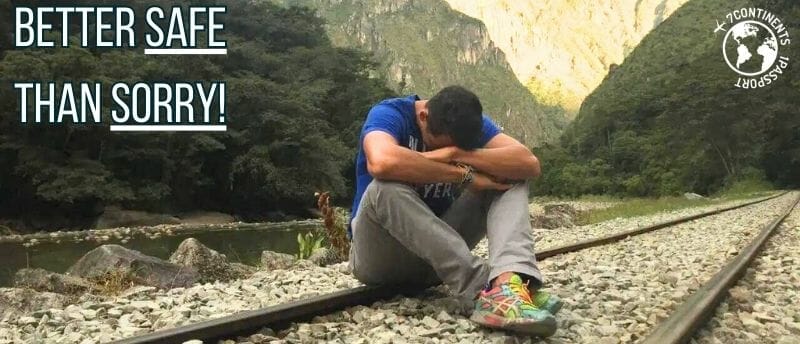
Play safe and get yours. Get a quote with World Nomads here or buy your travel insurance now with SafetyWing using the widget below.
- Book Your Flight Find deals on airlines on my favorite search engine: Skyscanner . Be sure to read my How to find cheap flights article.
- Rent A Car Rental Cars is a great site for comparing car prices to find the best deal.
- Book Accommodation Booking.com is my favorite hotel search engine. But Hotels.com and Hilton Hotels have very interesting reward programs.
- Protect Your Trip Don’t forget travel insurance! I always use World Nomads for short-term trips and SafetyWing for long-term ones. Find out why Travel Insurance: Much More Than a Precaution, a Necessity .
- Book Tours in Advance Book unforgettable experiences and skip-the-line tickets with GetYourGuide or Viator .
- Book Ground Transportation BookaWay offers a stress-free experience with secure payments and no hidden fees. You pay online and receive your itinerary by email.
- Luggage Solutions Rent your luggage with Cargo or if you need to drop off your own luggage and enjoy your time without dragging it all over a city, find a LuggageHero shop here.
- Get a Travel Card Revolut Card is a pre-paid debit card that enables cash machine withdrawals in 120 countries. I’ve been using my Revolut Card for over a year and never paid foreign-transaction fees again. Get your Revolut Card with free shipping here .
- Packing Guide Check out my How to Pack a Carry-on Luggage For a Five-month Trip to help you start packing for your trip. Don’t forget your camera, chargers and other useful travel accessories.
Leave a Comment Cancel reply
This site uses Akismet to reduce spam. Learn how your comment data is processed .
- Top 10 Things to Do
- Area Code & Zip Code
- Tour Operators in Xinjiang
- 6 Days Urumqi - Kashgar - Khunjerab Pass
- 7 Days Urumqi - Turpan - Kumtag Desert - Kashgar
- 12 Days Xinjiang Scenery
- 13 Days South Xinjiang
Xinjiang Travel Guide
Xinjiang facts:.
Cities in Xinjiang
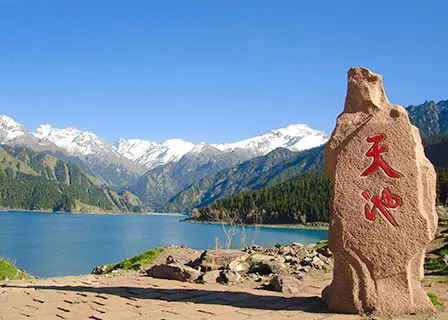
- Urumqi Tours
- Attractions
- Transportation
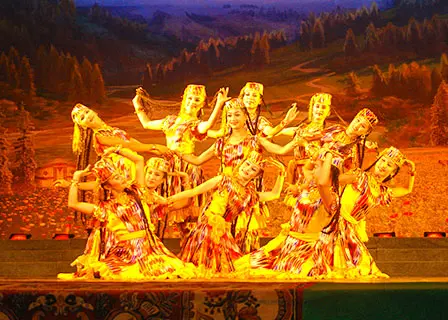
- Turpan Tour
- Travel Reviews
- Aksu
- Changji
Recommended Xinjiang Itineraries
- Gobi Desert Adventure : 7 Days Private Tour of Urumqi - Turpan - Kumtag Desert - Urumqi - Kashgar
- Classical Silk Road : 14 days of Beijing - Urumqi - Kashgar - Urumqi - Turpan - Dunhuang - Xi'an – Shanghai
Famous Attractions
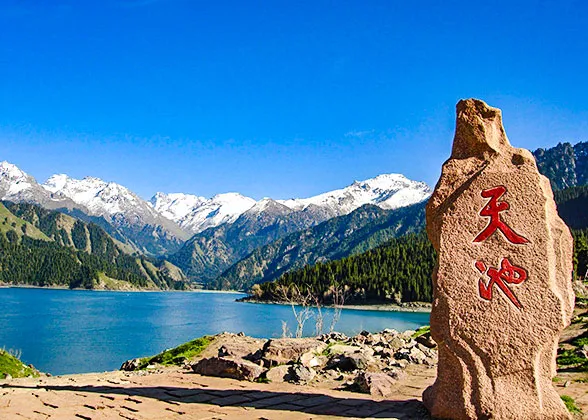
Xinjiang Introduction
Travel to Xinjiang: The Complete Guide
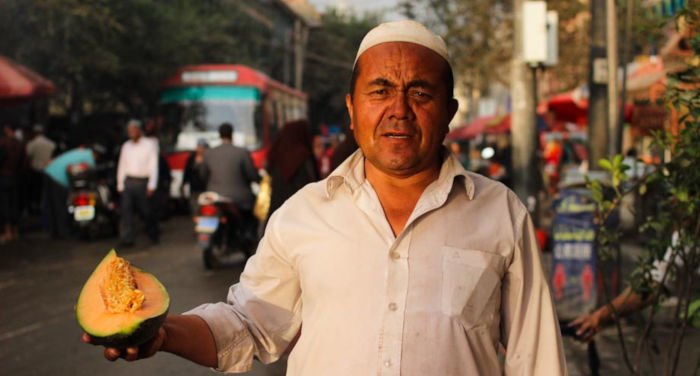
Travel to Xinjiang – Index
Key information, is it safe to travel to xinjiang, do i need a special travel permit to xinjiang, how to get to xinjiang, accommodations in xinjiang, what to see in xinjiang, food in xinjiang.
Xinjiang is one of the biggest provinces in China and located in the located in Northwestern parts, bordering to nine countries and three Chinese provinces. Being the home to many ethnic minorities, especially Uyghurs, Xinjiang has played an important role throughout China’s history, mainly as the Silk Road passes through the province.
The province is rich in mountains, lakes, deserts, and steppes, offering splendid sceneries to travelers. If you plan to travel to Xinjiang, don’t look any further. In this article, we explain all the details of how you can get there, which cities and sites you should visit, what to eat, and much more.
Chinese Name: 新疆 Location: Northwest of China Provincial capital: Urumqi Area: Around 1.66 million square km Population: Around 21 million and where 60% are ethnic minorities Ethnic groups: 47 (examples: Uygur, Han, Kazak, Hui, Mongolian, Russian) Famous Cities: Urumqi, Turpan, Kashgar Borders to: Tibet (province), Qinghai (province), Gansu (province), Mongolia, Russia, Kazakhstan, Kyrgyzstan, Tajikistan, Afganistan, Pakistan, India
Although there are many checkpoints around Xinjiang and travelers are often asked to show their passport for verification, as far as we know travelers generally don’t have any issues when visiting Xinjiang and interacting with the locals. The issue is mainly related to the stricter surveillance and controls that were implemented since 2009.
That said, you should be prepared to be stopped by police officers for questioning and to show your passport. It can be somewhat time-consuming and frustrating to some travelers, but generally not an issue if you really want to experience what Xinjiang has to offer.
Nevertheless, we still advise that you check the news or with your embassy to get the latest information about travel warnings and advisories for Xinjiang as things can change from time to time.
This question is asked by many foreigners who plan to travel to China and wish to visit Xinjiang. In short words, there’s no official special permit for foreign travelers to visit Xinjiang. But you should keep in mind that the “freedom of movement” is more restricted compared to most of the other provinces in China.
Thus, be careful to visit rural and off-the-beat areas. You should preferably contact a local travel agency and see what recommendations they have.
Another question asked is whether you should put Xinjiang in your travel itinerary when applying for a tourist visa, as it happens that foreigners get rejected a visa. With the increased surveillance in Xinjiang, some claim that it’s better to avoid including Xinjiang in the itinerary.
Yet, it’s not common that Chinese police officers asked why you didn’t include Xinjiang in your itinerary after arriving. Do what you think is the best and what makes you feel most safe.
Travelers often prefer to reach Xinjiang by plane or by train (if staying in China). Below you can find more information about your best travel option.
Going to Xinjiang by flight
Even if Xinjiang has international airports, travelers from overseas usually change flights in some of China’s biggest cities, such as Beijing or Guangzhou. It’s also far more common that travelers start in any other of China’s provinces and cities, like Beijing or Sichuan, before continuing to Xinjiang by domestic flights.
At the moment. there are only two international airports available in Xinjiang, one in the provincial capital Urumqi (Urumqi Diwopu International Airport) and one in Kashgar (Xinjiang Kashgar Airport), which is the second-largest airport.
Urumqi’s airport has developed much over the years and 40 airlines now have around 150 routes for persons traveling abroad or within Xinjiang.
There are 12 airports available (both domestic and international) located in the following in cities:
International
- Burqin Kanas
- Turpan Jiaohe
- Bole Alataw
As Xinjiang is located far away in the Northwestern parts of China, you better take a flight if you depart from China’s East Coast. If you’re traveling in provinces like Tibet, Sichuan, or Qinghai, going by train might be a more memorable experience, unless the travel distances are too long.
Going to Xinjiang by train
Traveling by train to and within Xinjiang will allow you to see some of Xinjiang’s most beautiful sceneries. On top of that, it’s cheap.
You’ll reach Xinjiang from Lanzhou (Gansu province) if you take the Lanzhou – Xinjiang High-Speed Railway, which connects Lanzhou with Urumqi. It costs around 550 RMB for a ticket and takes you 11 hours to reach Urumqi.
You can also take the train from major cities, such as Shanghai, all the way to Xinjiang. The price for a soft sleeper is around 150 USD and the ride will take you 40 to 44 hours.
In the past years, Xinjiang’s railway system has developed quickly and you can even find so-called “tourism trains” , offering entertainment, gyms, and bathrooms.
Just keep in mind that Xinjiang is one of the biggest provinces and the travel distances sometimes long. Below I’ve included a summary showing the travel-times for various destinations from Urumqi:
Kashgar: 20 to 23 hours Turpan: 1.5 hours Yining: 10 hours Hotan: 31 hours Kuqa: 11 hours Beitun: 12 hours Hami: 5 hours
Tickets cost between 23 RMB and 318 RMB, according to the distance and the class. If you think that some of the travel distances are too long, you better go for a domestic flight.
What’s the best time to visit Xinjiang Province?
The best time to visit Xinjiang is during the autumn, which normally stretches from August to September. At this time, the climate is cooler, the wind is not so strong, and the vegetation being fragrant and lively. Many local and foreign travelers go to Xinjiang during this time due to the many ripening fruits.
Temperatures fluctuate in Xinjiang and evenings can be cold, while the weather is comfortably warm in the daytime. During the winter, there’s a lot of snow in the region, while temperatures can reach up to 30 degrees over the summer.
The hottest period is from June to August with temperatures ranging between 20 to 25 degrees. Thus, the summers tend to be more comfortable compared to the Southern and Eastern parts of China.
Xinjiang is not short of hotels, but it can be a challenge to find a hotel that suits your budget, needs, location preferences, especially in smaller cities and remote areas. Truth be told, there aren’t as many options compared to the bigger cities.
Despite the many travel guides and online portals available, I recommend you to check Agoda, Trip, and Booking . They have plenty of options available and with great discounts.
Agoda provides the best offers for hotel-bookers in Asia . It has a wide hotel network in China, which is generally better than that of Booking. The only drawback of using Agoda is that the coverage can be scarce in some parts of China, especially in smaller cities and remote areas.
Booking is one of the biggest and most popular hotel-booking websites in the world . But, its coverage and hotel-network is smaller than that of Trip and Agoda. You should still have a look at the website as they offer great deals from time to time.
There are a bunch of hotel booking websites in China where Trip is regarded as one of the best . It’s also one of the few decent websites in English where you can manage payments with non-Chinese banks. Trip offers the best coverage in China among these three websites.
One of the drawbacks of using Trip is that you often see hotels that cannot cater to foreigners and they don’t display many international hostels.
Hotel prices in Xinjiang
Looking at prices, 3-star hotels will set you back 48 USD per night on average according to Booking.com. 4-star hotels are slightly more expensive at 51 USD per night. 5-star hotels aren’t that expensive and you can get a room for as little as 129 USD per night.
Xinjiang is famous for its spectacular views with lakes, nature reserves , deserts, wildlife, and mountains. These provide great opportunities for hiking and memorable photographs.
Below I’ve listed some places that you should consider visiting while in Xinjiang.
Urumqi is the provincial capital of Xinjiang and has an abundance of artifacts and history as it was one of the main stops on the Silk Road, which connects China with Central Asia and all the way to Europe.
Most travelers arrive in Urumqi and start from here, as it serves as the province’s “hub” and transportation center. You can reach Urumqi by international flights, domestic flights, buses, and trains.
Even if the majority of its people are Han Chinese, it’s a cultural melting pot with oriental flavors and a central-Asian culture. You’ll most likely spend your days absorbing this new atmosphere and indulging in its local cuisine, but there are also a few spots that you see before leaving Urumqi.
Grand Bazaar
The Xinjiang International Grand Bazaar is the biggest bazaar in the world, covering almost 40,000 square meters. Simply put, it’s a place that you must see when visiting Urumqi.
The bazaar has more than 3,000 booths selling oriental products such as nuts, fruits, garments, carpets, pots, jewelry, and instruments. Here, people cram to view the spectacular colors and enjoy the exotic smells, mixed with domes and arches.
There’s also a food square within the Bazaar, being more than 3,000 square meters big. Everything from local kitchens to franchise stores offer delicious food, including local noodles, sheep, and fruits.
Some claim that the area has become touristy over the years with high prices, but it’s a place worth visit.
Xinjiang Regional Museum
You cannot leave Urumqi before visiting the Xinjiang Regional Museum. You can find more than 50,000 items, including mummies, historical relics, and artifacts, created in the last millennia.
The museum covers 7,800 square meters, so be prepared to spend at least a couple of hours there. The opening hours are currently as follows:
Apr. 15 – Oct. 15: 10 AM – 6 PM Oct. 16 – Apr. 14: 10:30 AM – 6 PM
There’s no entry after 5 PM. Be sure to double-check the opening times before visiting, to assure that you won’t arrive when it’s closed.
Heavenly Lake of Tianshan (if you have the time)
Heavenly Lake of Tianshan is located around 110 km away from Urumqi, as such, it takes some time to get there. The lake is shaped like a half-moon, around 3 kilometers long, and 700 meters wide. It’s a great scenery as you’ll see the lake with its crystal-clear water being surrounded by mountains with snowy hill-tops.
Sadly, we’ve seen a great influx of Chinese tourists over the years, a reason why it has somewhat lost its reputation. It can be worthwhile visiting the lake if you walk away from the tourist groups, further down the lake, to more quiet areas.
Buses depart every 10 minutes until 8 PM Beijing time, taking you back to the main gate.
The entrance fee is 95 RMB for adults.
Altai Mountains (Kanas and Hemu)
Xinjiang has many tall mountains (K2 is one of them) where the Altai Mountains is one of the most popular destinations among travelers. It’s located 670 kilometers from Urumqi in the northern tip of Xinjiang and Kazakhstan, Mongolia, China, and Russia cross over the mountains.
The highest elevation is 4,506 meters, located in the Russian part of the mountains. The mountains offer spectacular views and should preferably be visited with a travel agency.
Turpan is a city located in the Eastern parts of Xinjiang , having around 630,000 people. It’s mainly famous for its unique Uyghur culture, great scenery, food, history, and old monuments.
Nowadays, you can visit the city within just one day thanks to the high-speed railway system.
If you visit Turpan, you should visit the local food and night markets, trying out dishes and drinks like local kebab, noodles, and tea. It offers a relaxed atmosphere with less tourists.
You should also pay a visit to the surrounding vineyards and the well-known Emin minaret. It’s the tallest minaret in China with a height of 44 meters.
Jiaohe and Gaochang, two ancient cities, are located 10 and 46 kilometers away from Turpan respectively and worth visiting. Jiaohe is smaller in Gaochang, but has more preserved ruins. Thus, Jiaohe should be your choice if you only plan to visit one of them.
Kashgar was an important stop on the Silk Road with a history that stretches back more than 2,000 years. Being a cultural epicenter, the city has become an important part of Xinjiang’s economic expansion.
One of its most famous attractions is the Live Stock market , one of the biggest and most colorful in Xinjiang. You should also pay a visit to the local mosques, where Id Kah with its yellow colors stands out the most. It’s the biggest in China and the third biggest in the middle of Asia. Thousands of visitors go to the mosque every day.
Visiting the night markets and old town should also be on your to-do list, which is a unique experience on its own.
Karamay is located in Northwestern Xinjiang and the richest city in China, thanks to its oil reserves. Yes, you heard that right. As a result, the streets are clean and wide, the sparkling neon and tidy parks also bring a feeling that it’s more well off.
Karamay has many spots worth visiting, including the Ghost Town, which is located around 100 kilometers away. The area covers 100,000 square meters with wind-erosion physiognomies, one of a few in the world. You can hear the wind howling over the landscape and it’s famous for the unique shapes.
You should also pay a visit to the Baiyang River Canyon, which has become a popular sightseeing spot.
Korla is located 200 kilometers Southwest of Urumqi and the second biggest city in Xinjiang. It has 800,000 inhabitants that mainly consists of Han nationals, Uyghurs, Mongolian nationals, and Hui nationals.
Korla offers spectacular views with vast forests, lakes, mountains, and hills. The climate is comfortable and the land fertile which makes it a good place to grow tomatoes, fruits, and cotton.
One of its most well-known fruit is the bergamot pear which has a strong flavor and fragrance, thus being called the king of fruits.
Some locations you should visit in Korla include the Iron Gate Pass, the Ancient City of Loulan, Bosten Lake, and Bayanbular Grasslands.
Hotan is located in Southwestern Xinjiang and with a population of 300,000 people. It’s a big oasis north of the Kunlun mountains. Hotan played a vital role in China’s trading industry and was one of the main stops on the Silk Road.
You can find many historical sites here, including the Ancient City of Mallikurwatur, Ancient City of Niya, and the Ancient City of Yoktan.
The food in Xinjiang is similar to the Turkish and central-Asian cuisine. A clear difference to the eastern parts of China is that locals eat more bread and dishes (such as noodles) are made of wheat instead of rice.
You’ll also find many fruits, such as grapes, peaches, melons, and figs. Common spices used when cooking include red pepper flakes, cumin seeds, raising, salt, and black pepper.
Some of the most characteristic dishes you should try are:
- Kawap (Roasted mutton kebabs)
- Da pan ji (chicken soup)
- Laghman (noodles)
- Liang Mian (Cold noodles)
- Mutton soup
- Polu (fried rice with mutton)
- Naan (flatbread)
If you want to read more about and see pictures, I recommend you to read our separate article that is dedicated to food in Xinjiang .
Photo Credits: Photos by Sapore di Cina
About The Author
Sergi Portolés
Related posts.

The Stone Forest and the legend of Ashima

From Lijiang to Lugu Lake: Chronicle of a Hectic Trip

Gubeikou: Hiking on the Wild Great Wall
3 thoughts on “travel to xinjiang: the complete guide”.
For going to lake karakol and White sand salke and tashkorghan near kashgar you need a permit. And you can get it in kashgar with the help of local agent there.
Thank you for your feedback
Now no check points if you are not traveling to border areas. Very tourist friendly.
Leave a Comment Cancel Reply
Your email address will not be published. Required fields are marked *
Save my name, email, and website in this browser for the next time I comment.
Privacy Overview
Get 3 Months FREE with EXPRESS VPN
+ Best VPN For China + 30-Day Money-Back Guarantee + 24/7 Live China Customer Support + 3 Months Free on 12 Months Package

Getty Images/View Stock RM
China's largest province, Xīnjiāng (新疆) is the homeland of the Muslim Uyghurs and a fast-changing region where ancient and modern clash against each other in surprising ways. High-speed railways cross the Martian landscapes linking cities in hours rather than days, and the regional capital Ürümqi is a forest of high-rise apartments and glass skyscrapers; while in parts of the Silk Road oases of Kashgar, Hotan and Turpan, life goes as it has for centuries, based around the mosque, the tea house and the bazaar.
Attractions
Must-see attractions.

Shipton’s Arch
This extraordinary natural rock arch (the rather prosaic Uyghur name means simply ‘mountain with a hole in it’) is one of the tallest on earth. The first…
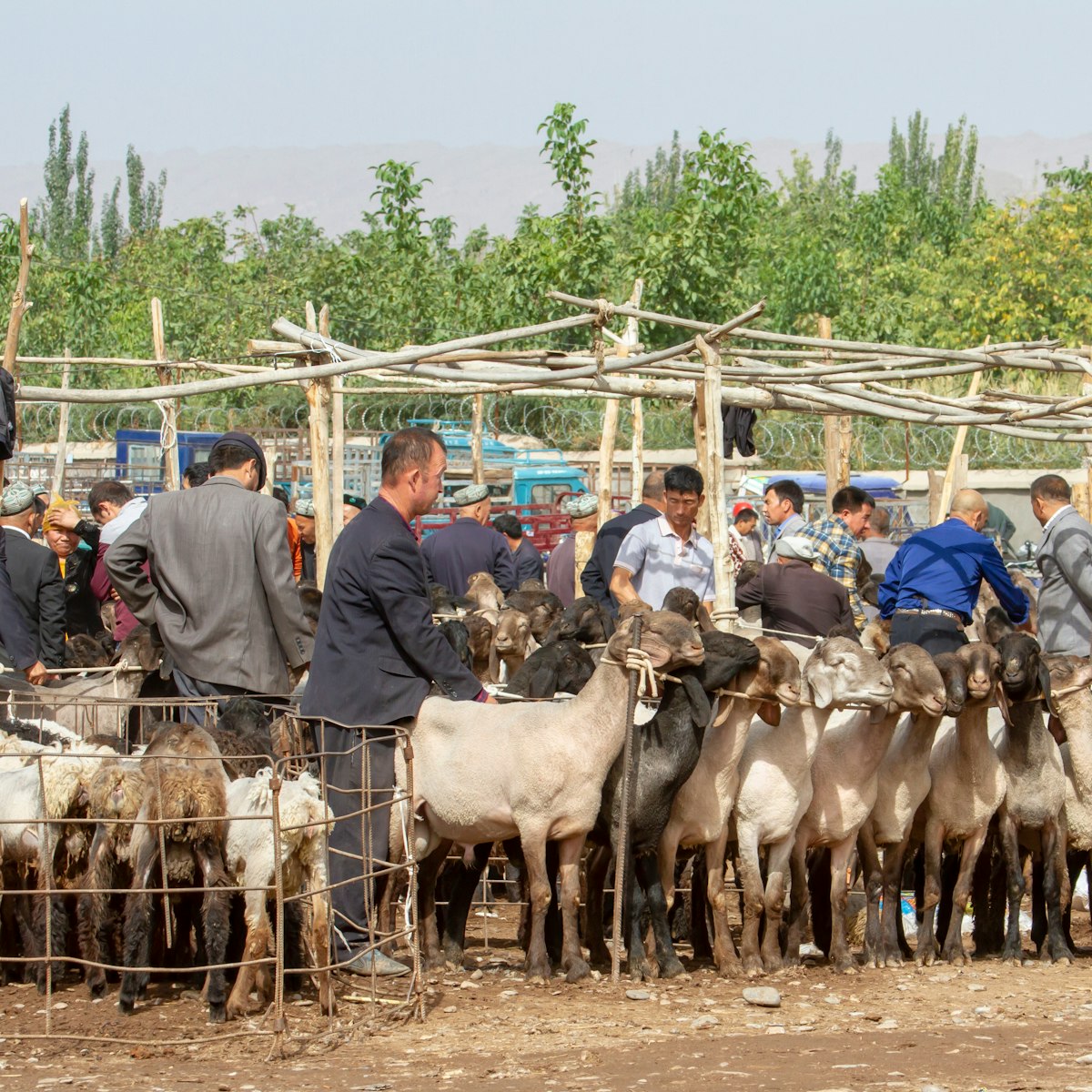
Sunday Livestock Market
No visit to Kashgar is complete without a trip to the Livestock Market, which takes place once a week on Sunday. The day begins with Uyghur farmers and…

Xinjiang Autonomous Region Museum
Xinjiang’s massive provincial museum is a must for Silk Road aficionados. The highlight is the locally famous ‘Loulan Beauty’, the first of half a dozen…

Jiaohe Ruins
Also called Yarkhoto, Jiaohe was established by the ancient Jushi kingdom as a garrison town in the 2nd century BC. It’s one of the world’s largest (6500…

Hotan Sunday Market
Hotan’s most popular attraction is its weekly Sunday market. The covered market bustles every day of the week, but on Sundays it swamps the northeast part…

Grand Sunday Bazaar
Kashgar’s main bazaar is open every day but really kicks it up a gear on Sunday. Step through the jam-packed entrance and allow your five senses to guide…

Bezeklik Cave Complex
This cave complex, which dates from the 6th to 14th centuries, is located in a mesmerising desert landscape. Bezeklik means ‘Place of Paintings’ in Uyghur…
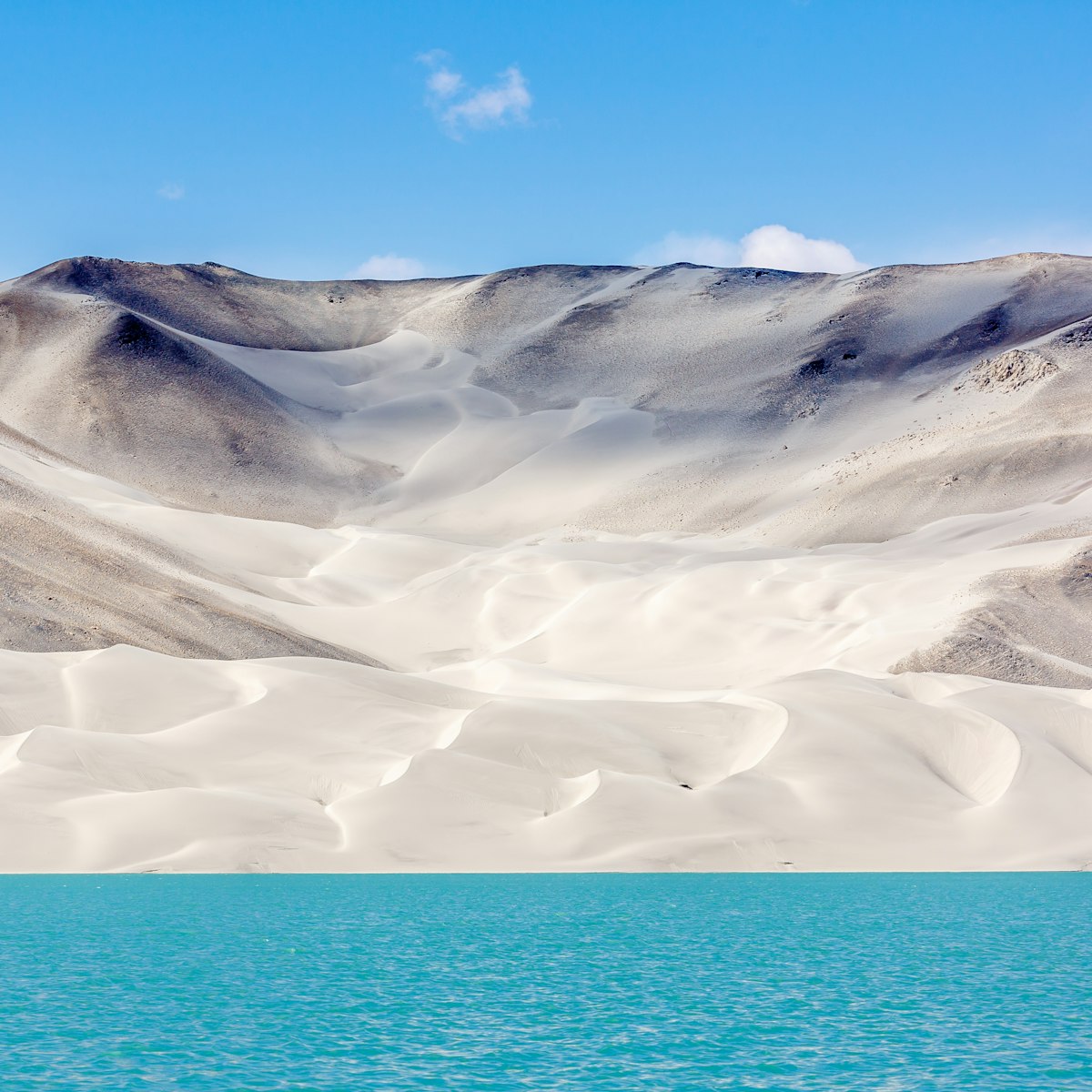
Bulunkou Lake
This absolute wonder of nature is the first of the big plate-glass lakes you meet as you head up to Tashkurgan on the Karakoram Hwy. Backed by sublime…
Latest stories from Xinjiang
Filter by interest:
- All Interests
- Adventure Travel
- Art & Culture
- Beaches, Coasts & Islands
- Food & Drink

Mar 22, 2019 • 8 min read
The Silk Road is well-known as being one of the world’s earliest trade routes, allowing the exchange of goods between China and Europe, via Central Asia…

Aug 24, 2017 • 7 min read

May 5, 2017 • 5 min read

Apr 18, 2017 • 6 min read
Xinjiang and beyond

National Geographic content straight to your inbox—sign up for our popular newsletters here

- INTELLIGENT TRAVEL
Traveler’s Guide to Xinjiang, Western China
Former Traveler staffer Ashley Thompson is in western China. We emailed her to learn what she’s up to.

Some of your status updates on Facebook mention seeing ram fights, Uyghur wrestling, and headless goat polo. Where are you and what are you doing there? My new roommate invited me along to watch traditional Nowruz (Central Asian New Year) activities about an hour outside of Kuqa city. Traditionally celebrated to ring in spring (March 21) on this day it was cold, windy, and dusty, as the sporting activities took place in the middle of the desert. But it was an incredibly memorable travel experience. Traditional sporting events included Uyghur boxing, ram-fighting, horse racing, and a wholly interesting spectacle in which horseback riders essentially play polo with a headless goat carcass. My friends and I ended up being a spectacle ourselves, as we were the only foreign faces among hundreds of Uyghurs.
How long have you been in western China? I have been in Xinjiang since early March studying Uyghur at a college in Urumqi.
Western China is not a “regular” travel destination like Tuscany or Paris. What is it like and what tips do you have for other intrepid travelers planning to head to western China, specifically, or a similar spot, off-the-tourist trail? It’s becoming incredibly easy to travel to–and throughout–the western reaches of China. And it’s only going to get easier, as China recently announced plans for rail connections between the provinces of Xinjiang, Qinghai, and Tibet. Currently, there are myriad bus routes–but bear in mind that most bus routes that cut through Xinjiang involve basically off-road desert driving. If you are wanting to go from the northern part of the province (Urumqi – the provincial capital and travel hub) and Kashgar (once the heart of the Silk Road)–it is a 24-hour bus ride or a 33-hour train ride. Consider breaking up long journeys if you have time, to get a little bit off the tourist radar. It’s usually pretty easy to find a reasonably priced shared taxi between smaller cities. Or, if you get motion sick, there are incredibly cheap flights connecting all the major towns now, typically only a few U.S. dollars more than train tickets if booked a month or so advance.
Keep in mind that English does not get you very far here. This is not Beijing or Shanghai. And in smaller cities (such as Yarkand, my favorite Xinjiang city thus far), even decent Chinese won’t prove useful for everyday interaction. Come with a Uyghur phrasebook in tow. If you’re going to linger a bit in Xinjiang Province, consider splurging on a Chinese-Uyghur-English electronic dictionary, which has thus far proved invaluable. They’re available at any of the Xin Hua foreign bookstores across the region.
For tourists, traveling in Xinjiang is a much different experience from the rest of China. As a fair-skinned, freckled brunette, I constantly stuck out as the foreigner while living in eastern China. That had its perks at times (I never got tired of doling out autographs), but it also was tiring and borderline creepy (I’ll never forget waking up from a pleasant nap in a park with a video camera in my face.) Here, though, if I dress with enough gold accessories and sport a fashionable headscarf, I can pass as Uyghur. Or Uzbek, Or Kazakh. Or Tajik. Ethnicities abound. I especially love soaking up the international atmosphere at the intoxicating bazaars. It’s fascinating, beautiful, and certainly at times, challenging.
How has your one-year stint at Traveler as a researcher affected (for good or ill) your subsequent travels? I’m definitely more mindful of my role as a tourist. I think more about the good or harm I can do while on the road. For example, while in Egypt last year I was constantly hounded for tips, from everyone from police officers to very young children. My friends and I came prepared with school supplies instead while traveling in more remote areas of the country.
Through my time at Traveler, I realized that the best travel stories, and the best travel experiences, don’t come from planning every little detail in advance. It comes from having an open mind and being up for anything. Spontaneity on the road makes me oh-so happy.
Since leaving Traveler , you’ve traveled a bunch (and no, I’m not envious ;). What have your favorite travel destinations been? I’ve talked a lot about China so I’ll choose other places:
Aswan, Egypt–It might have been because we were there during the off-season, but Aswan was so sleepy and charming. Elephantine Island, in the middle of the Nile, offered an amazing look at traditional Nubian culture, as well as the opportunity to interact with some of the warmest, nicest people I’ve ever encountered. I also strongly recommend taking a felucca (Egyptian wooden sailboat) up (yes, “up”) the Nile for a day or two. Nothing I’ve ever experienced in life compares to spending the night in a boat on the Nile river. I slept soundly, save for the occasional middle-of-the-night call to prayer in a distant town.
Triglav National Park, Slovenia–For an outdoor enthusiast, or a lover of cheese, Triglav National Park is a dream. It offers great rock-climbing routes, canyoning, challenging hikes through the Julian Alps, and, oh yeah, a tourist cheese route, which takes you to local farms for an opportunity to taste fresh cheese and watch it being made Slovenian-style. My savvy travel mates found us an incredibly modestly priced private mountain cabin through Vacation Rentals By Owner (VRBO.com).
- Nat Geo Expeditions
You spent time teaching English in China, too. Tell us some highs/lows that you experienced while traveling in China. Previous highs: Trekking (and boating along) the easternmost portion of the Great Wall, which today divides China and North Korea; biking along the canals in Old Town Suzhou; touring tiny towns near the Tibetan frontier in northwest Sichuan.
This time around: Without a doubt, watching traditional Uyghur sports during the Nowruz festival; subsisting entirely off street food for days at a time–Xinjiang is the BEST place to do so; learning traditional Uyghur usul (dance) at a Uyghur night club–which is entirely tame and features one large (and lively!) dance floor in the middle of a large perimeter of dinner tables, where patrons nosh on kebabs and juicy watermelon, washed down with hot tea, fresh juice, or perhaps the occasional red wine. Taking a horse-drawn carriage taxi along the highway in Kashgar, as semi-trucks zoomed by. Weaving my way around Kashgar’s Sunday Livestock Market, where Uyghurs from Kashgar and surrounding towns come to buy and sell cows, horses, sheep, goats, chickens, and even handmade knives. Spending the night in a Kyrgyz yurt at the foot of the lofty Karakorum mountains. Exploring Yarkand’s Old Town, still active with Uyghur blacksmiths and carpenters.
Lows: Naively getting into one of Urumqi’s “black taxis” (technically illegal but everyone uses them!) only to realize the driver was not a local and couldn’t read Chinese–resulting in an unwanted hour-long tour of the city; waking up each morning with a different view (sometimes I have a mountain view, sometimes not) due to Urumqi’s hellacious pollution problem, especially in winter.
Photos: Ashley Thompson (opener) and Brad Jackson /National Geographic My Shot, taken at Sunday market in Kashgar (in post).
Related Topics
Fuel their curiosity with your gift.
- Perpetual Planet
- Environment

History & Culture
- History Magazine
- History & Culture
- Race in America
- Mind, Body, Wonder
- Paid Content
- Adventures Everywhere
- Terms of Use
- Privacy Policy
- Your US State Privacy Rights
- Children's Online Privacy Policy
- Interest-Based Ads
- About Nielsen Measurement
- Do Not Sell or Share My Personal Information
- Nat Geo Home
- Attend a Live Event
- Book a Trip
- Inspire Your Kids
- Shop Nat Geo
- Visit the D.C. Museum
- Learn About Our Impact
- Support Our Mission
- Advertise With Us
- Customer Service
- Renew Subscription
- Manage Your Subscription
- Work at Nat Geo
- Sign Up for Our Newsletters
- Contribute to Protect the Planet
Copyright © 1996-2015 National Geographic Society Copyright © 2015-2024 National Geographic Partners, LLC. All rights reserved
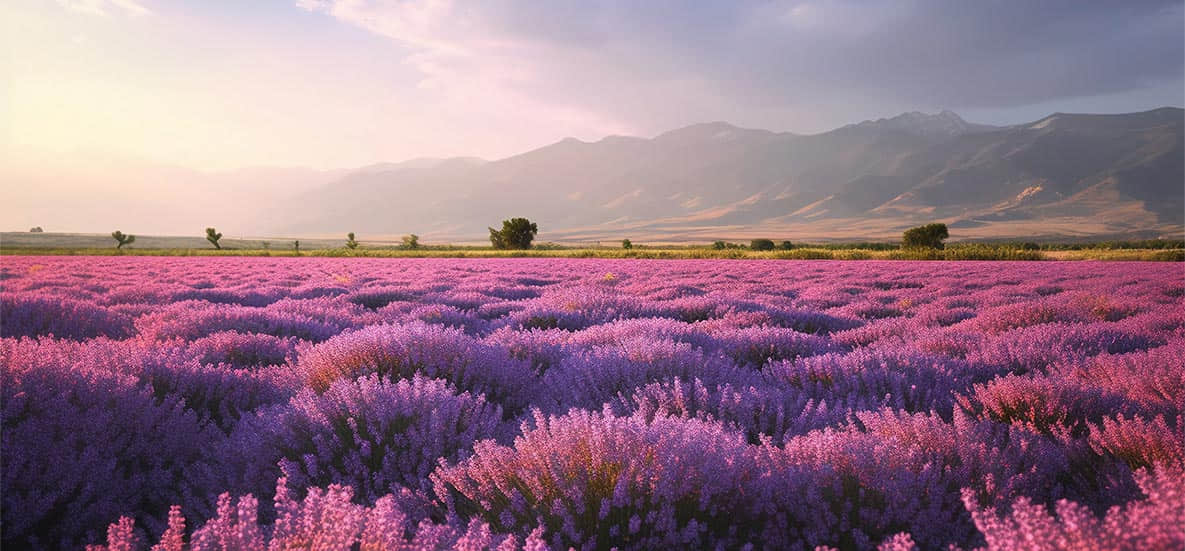
- Xinjiang Travel Guide
Xinjiang is an autonomous region in Northwest China, known for its diverse culture, stunning landscapes, and unique ethnic groups. Xinjiang is a diverse region with a blend of different ethnic groups, including Uighurs, Kazakhs, Tajiks, and Han Chinese. This cultural diversity creates a vibrant and unique atmosphere, allowing visitors to immerse themselves in various traditions, languages, and cuisines. Xinjiang is also famous for its awe-inspiring natural landscapes. From the vast deserts of the Taklamakan and Gobi to the majestic peaks of the Tian Shan and Pamir Mountains, the region offers diverse and breathtaking scenery. Whether it’s exploring the stunning Heavenly Lake or riding camels across the sand dunes, Xinjiang’s landscapes are a true visual feast. Xinjiang has played an important role in the history of the Silk Road, serving as a key trading route between China and Central Asia. This region is adorned with numerous historical sites, ancient cities, and archaeological treasures that reveal its rich past and connections to various civilizations. Here's a travel guide to help you explore Xinjiang:
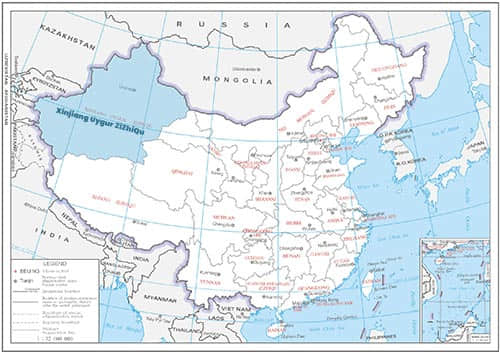
- Location: Northwest of China
- Provincial capital city: Urumqi
- Area: Around 1.66 million square km (640,000 square miles)
- Population: 25.8 million (as of 2022)
- Endemic Ethnic groups: 7
- Famous Cities: Urumqi, Turpan, Kashgar, Hami, Karamay and Hotan
- Borders to: Provinces within China: Xinjiang borders the following provinces: 1) Gansu to the east 2) Qinghai to the southeast 3) Tibet Autonomous Region to the south 4) Inner Mongolia Autonomous Region to the northeast 5) Ningxia Hui Autonomous Region to the east Countries: Internationally, Xinjiang shares borders with several countries: 1) Russian and Mongolia to the north 2) Kazakhstan and Kyrgyzstan to the west 3) Tajikistan, Afghanistan, Pakistan and India to the southwest
Best time to visit Xinjiang
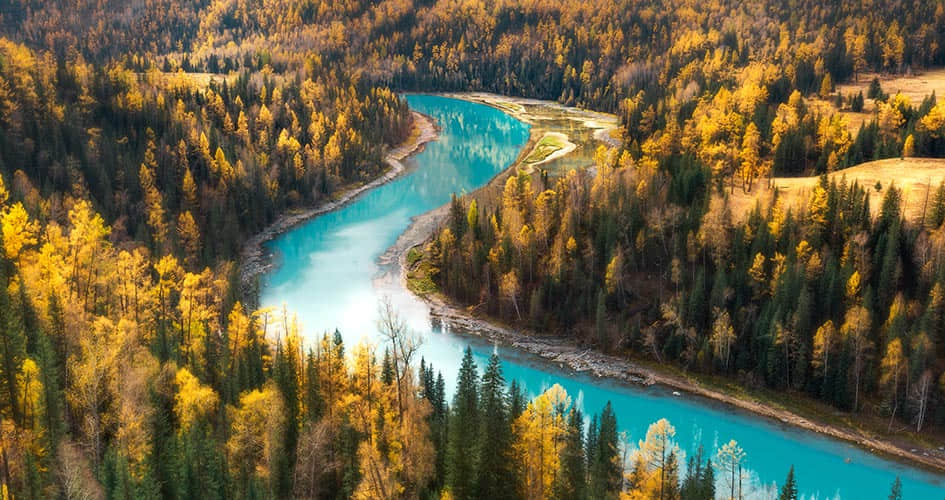
The best time to visit Xinjiang depends on your preferences. Spring (April to June) and autumn (September to October) offer mild temperatures and pleasant weather. Summers can be hot, especially in the desert regions, while winters can be extremely cold, particularly in the mountainous areas. But if you want to go skiing in Xinjiang, winter is the best season.
Getting there and travel around in Xinjiang
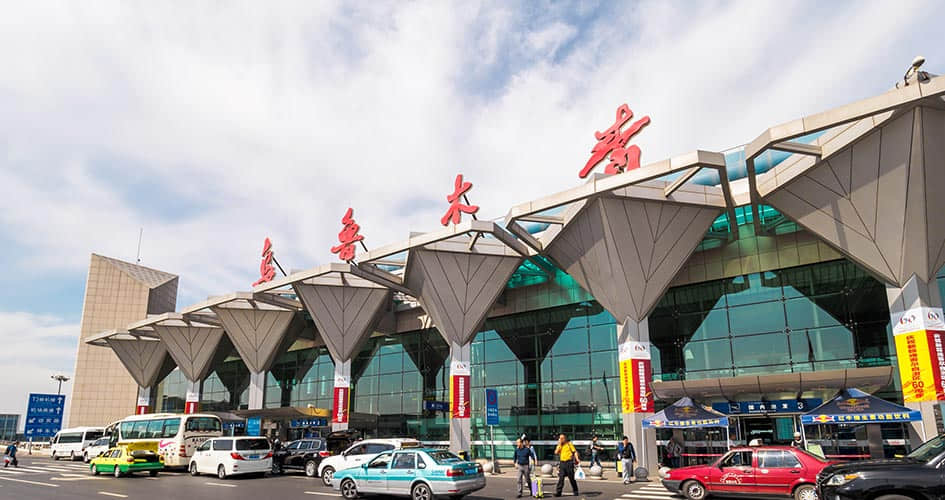
You can reach Xinjiang by air, with Urumqi being the main entry point. Urumqi Diwopu International Airport (IATA:URC) is well-connected with major cities in China and some international destinations. Alternatively, you can also travel by high speed train from other parts of China.
Once in Xinjiang, domestic flights, trains, and long-distance buses connect various cities within the region. It's also possible to travel by car, but be aware of long distances between destinations. Xinjiang is the largest administrative region in China, occupying an area of approximately 1.66 million square kilometers (640,000 square miles). It is slightly smaller than Alaska which spans around 1.72 million square kilometers (663,267 square miles). So it is no wonder that there are 21 airports in Xinjiang. Some of the major airports in the region include Urumqi Diwopu International Airport (URC), Kashgar Airport (KHG), Korla Airport (KRL), Turpan Jiaohe Airport (TLQ), and Hotan Airport (HTN).
Permits and Documentation
Travelers to Xinjiang may need to obtain a special travel permit, especially for certain areas close to the international borders. It is recommended to check the latest travel advisories and regulations before your trip to ensure compliance.
Highlights and Destinations
Visit the grand bazaar in urumqi.
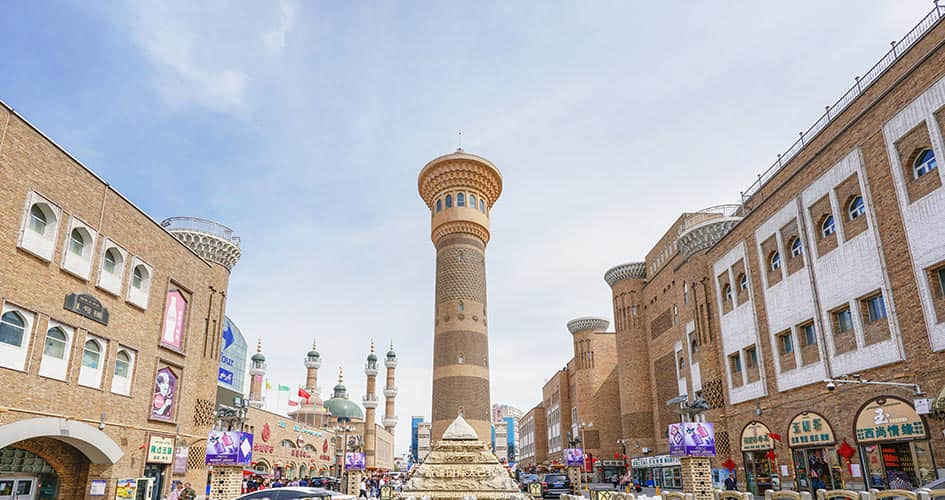
Explore the bustling market known for its vibrant atmosphere, traditional goods, and local specialties.
Encounter the Terracotta Army of Xinjiang
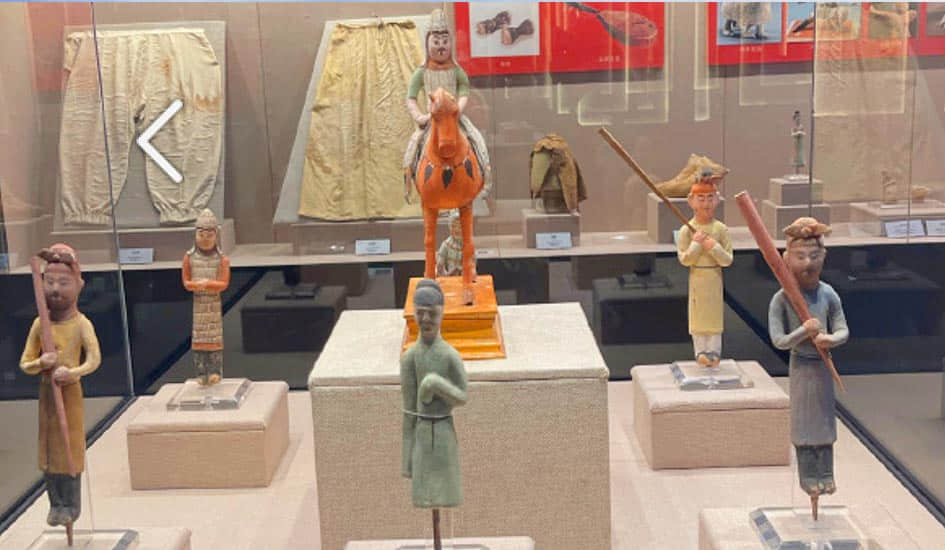
In the city of Ürümqi, you can find a unique collection of life-sized terracotta warriors and horses, similar to those found in Xi’an.
Explore the ancient city of Turpan
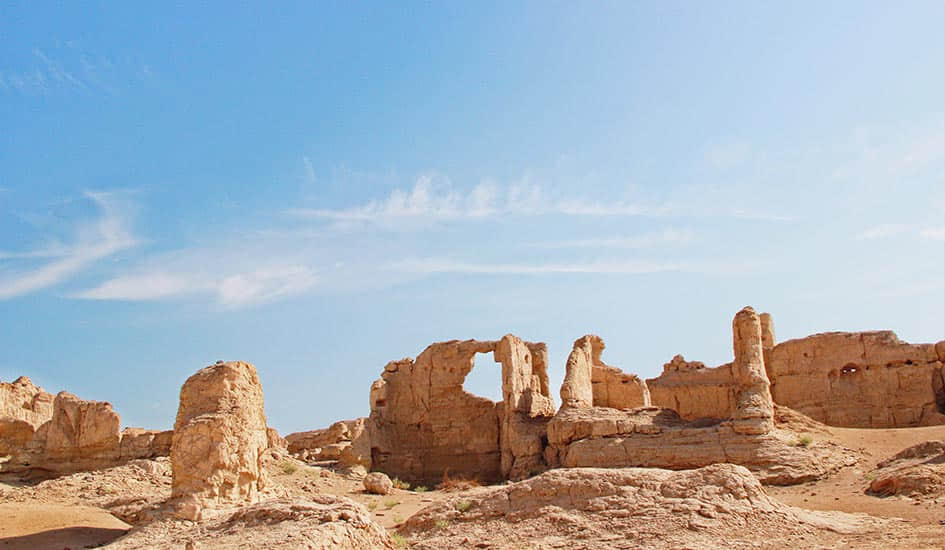
Visit historical sites such as the Jiaohe Ruins, Emin Minaret, and the Flaming Mountains. Turpan is also famous for its grape cultivation and unique irrigation systems.
Admire the Karez Water System
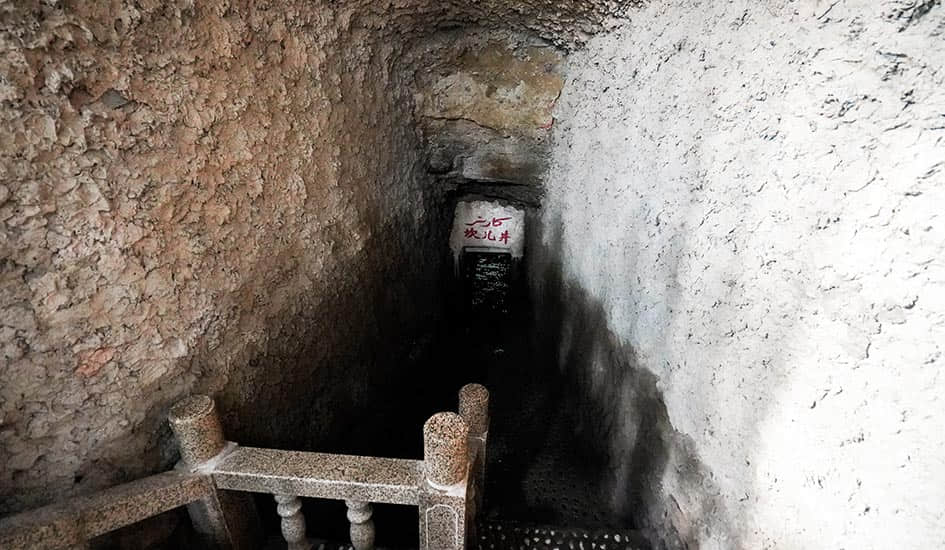
Witness the ingenuity of the ancient underground irrigation system that makes water accessible in the arid regions. You can even explore the tunnels that form a part of this system.
Experience the beauty of Heavenly Lake (Tianchi)
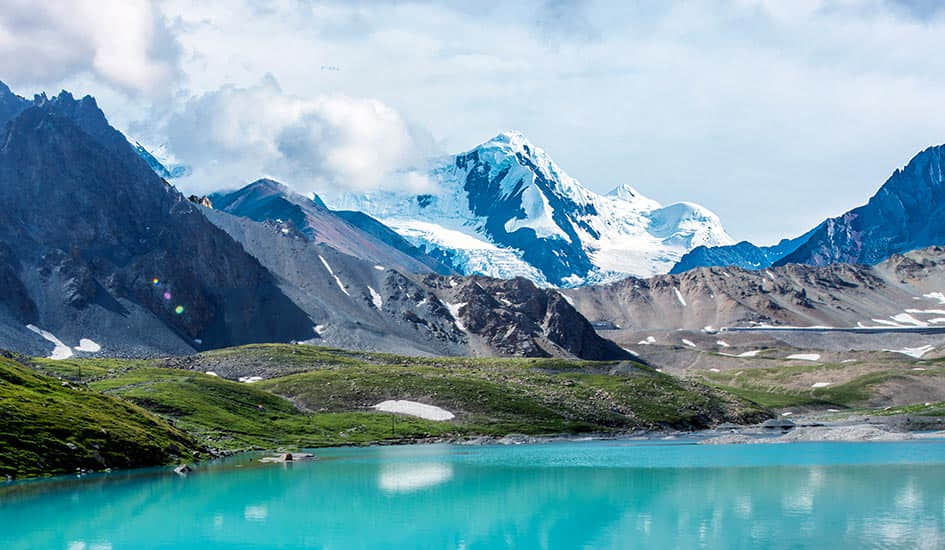
Take a trip to Tianchi, a stunning alpine lake surrounded by snow-capped mountains, and enjoy boating, hiking, and camping in the picturesque setting.
Venture into the Taklamakan Desert
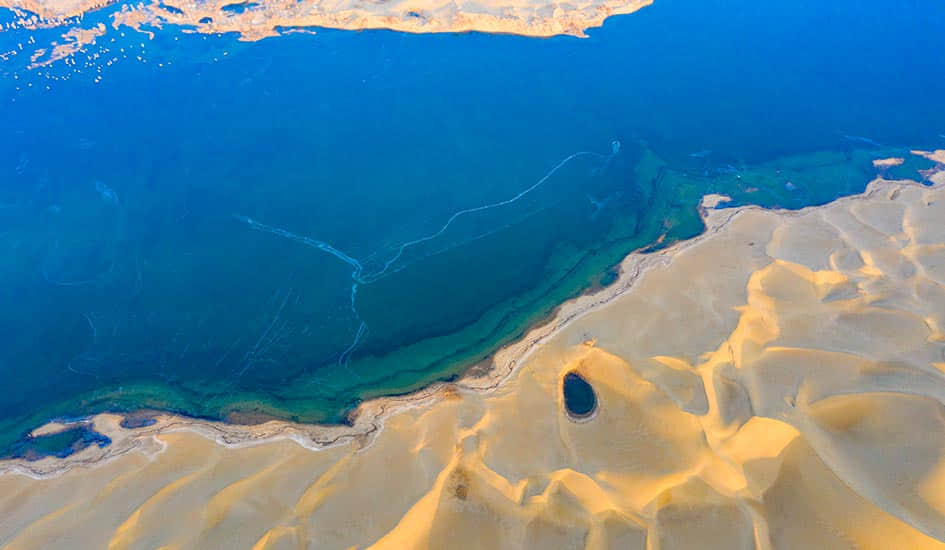
Opt for a desert excursion to witness the vastness of the desert, try sandboarding, and experience a camel ride. Overnight desert camping and stargazing can also be arranged.
Attend local festivals
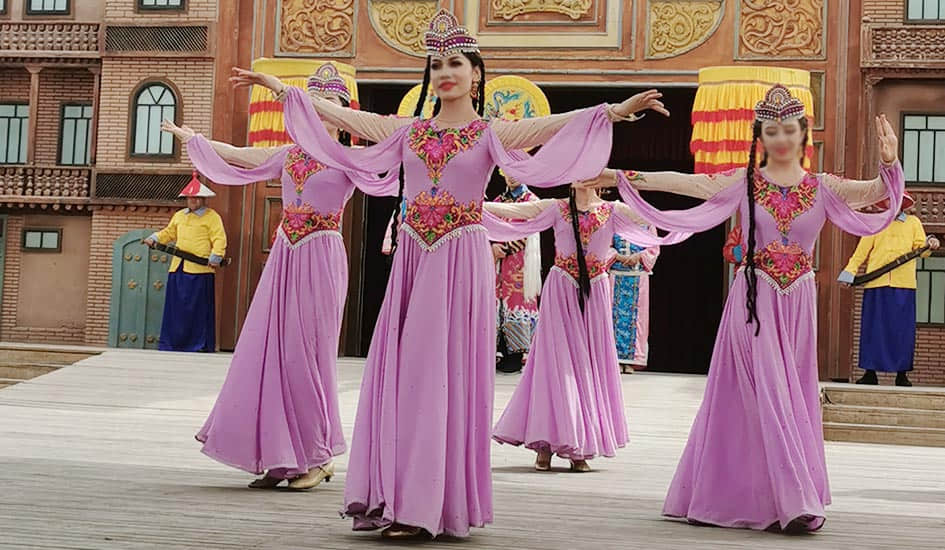
If your visit aligns with the local events, make sure to attend festivals like the Xinjiang Grape Festival or the Uyghur Meshrep to witness traditional performances, music, dance, and taste authentic food.
Explore the Kanas Nature Reserve
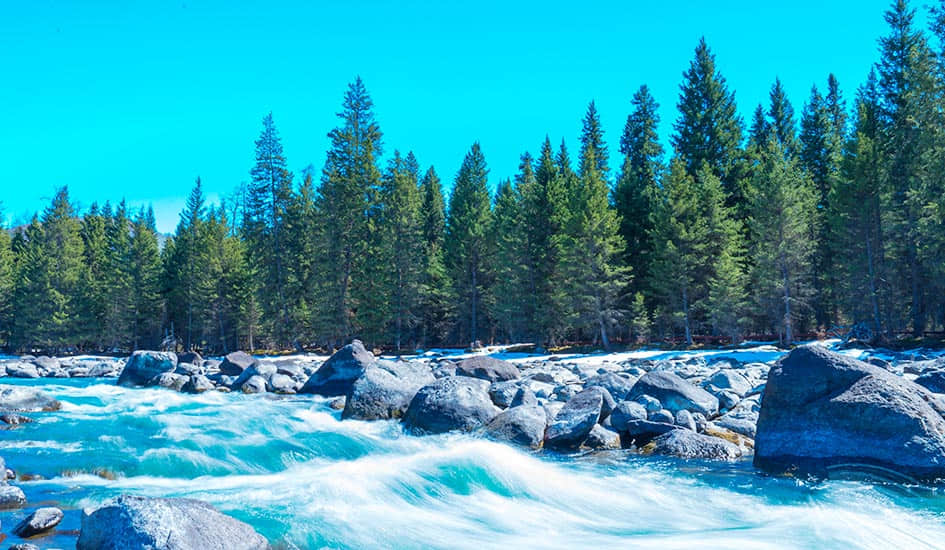
Head to the northern part of Xinjiang to visit the stunning Kanas Lake, surrounded by lush forests and majestic mountains. Enjoy activities like hiking, boating, and wildlife spotting.
Explore the vibrant bazaars
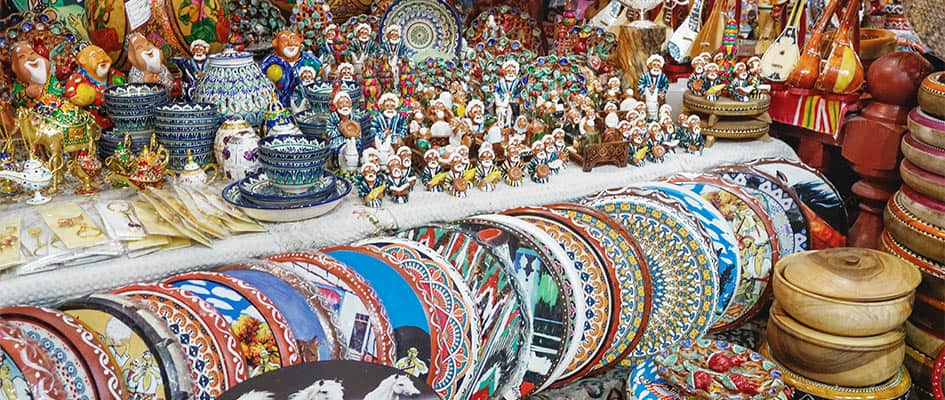
Immerse yourself in the lively markets of Xinjiang, where you can discover local treasures like handmade crafts, fragrant spices, colorful textiles, and more authentic goods at bazaars like Kashgar's famous Sunday Bazaar
Go skiing in Xinjiang

Xinjiang is a fantastic destination for skiing and winter sports enthusiasts. The region offers a variety of ski resorts with beautiful landscapes and excellent snow conditions. Altay area is known for its long and snowy winters, making it a popular destination for winter sports enthusiasts. For beginners, there are several ski resorts near Urumqi.
Local Cuisine in Xinjiang
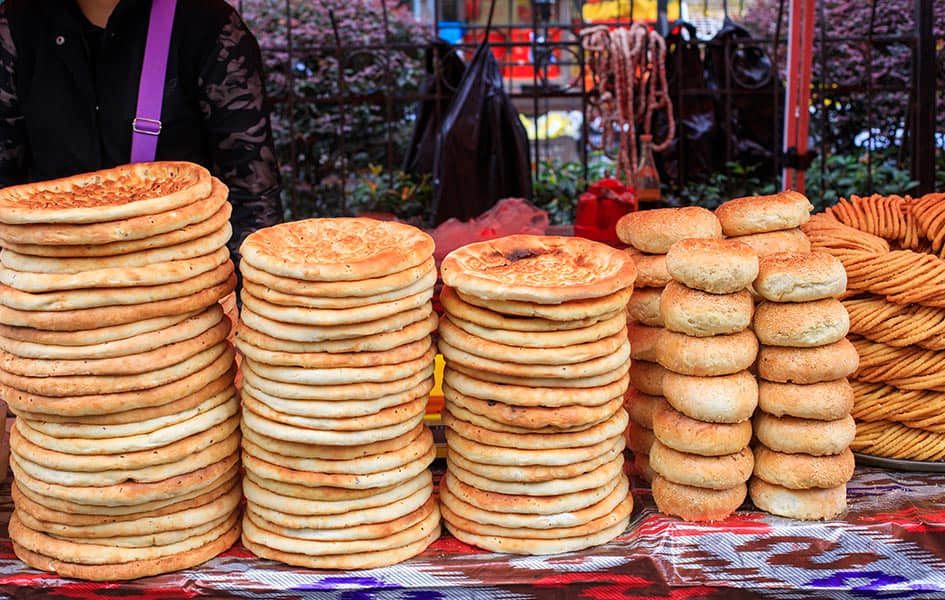
Don't miss the opportunity to try Uyghur cuisine, which is a fusion of Middle Eastern, Central Asian, and Chinese flavors. Try signature dishes such as hand-pulled noodles (laghman), lamb kebabs(Yangrou Chuan), pilaf (polo), and nang bread.
This is a popular Uyghur dish featuring hand-pulled noodles cooked with stir-fried vegetables, meat (usually lamb), and a savory sauce. It is both hearty and delicious.
Yangrou Chuan (Lamb kebabs)
Xinjiang is famous for its grilled lamb skewers, seasoned with various spices like cumin and chili powder. They are a favorite street food and can be found throughout the region.
Da Pan Ji (Big Plate Chicken)
This is a hearty dish made with chicken, potatoes, bell peppers, onions, and noodles cooked with aromatic spices. It is called “big plate chicken” because it is traditionally served in a large plate to share. It is typically served with bread or noodles.
Polo (Pilaf)
Xinjiang’s version of pilaf is a fragrant rice dish cooked with meat (often lamb or chicken), carrots, onions, and a blend of spices. It is a staple in Xinjiang cuisine and often served during special occasions.
Samsa (Baked Meat Pastry)
Samsa is a savory pastry stuffed with a mixture of ground meat, onions, and spices. It is then baked until golden brown and is a popular snack in Xinjiang.
Nang is a traditional Xinjiang bread that comes in various shapes and sizes. It can be plain or stuffed with ingredients like lamb, onions, or spices. Nang is a staple food in Xinjiang and is often enjoyed with tea or served alongside other dishes.
- Xinjiang Tours
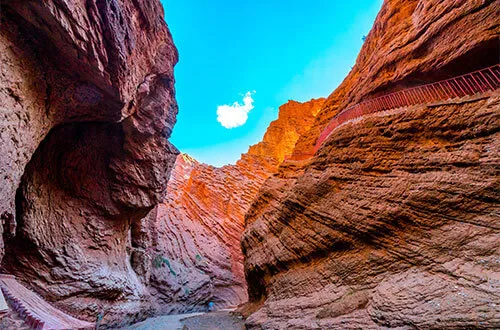

- North Korea
- South China Sea
- Environment
- Asia Fact Check Lab
- Jobs and internships
US lawmakers urge Blinken to ban travel to China’s Xinjiang

UPDATED at 3:59 P.M. ET on 03-08-2024
Two members of the U.S. Congress have sent a letter urging Secretary of State Anthony Blinken to ban American citizens from traveling China’s far-western region of Xinjiang so as not to “perpetuate and conceal atrocity crimes” that China is committing against Uyghurs and other Turkic minorities living there.
“American citizens and permanent residents, companies, and other entities should be warned about the risk of enabling atrocity crimes if they participate in tourism to the XUAR,” Rep. Chris Smith and Sen. Jeff Merkley, co-chairs of the U.S. Congressional-Executive Commission on China, or CECC, wrote in the letter.
They said the State Department’s travel advisory for the Xinjiang Uyghur Autonomous Region, or XUAR, should be raised to Level 4 – do not travel.
They also wrote letters to three U.S. travel agencies asking them to stop offering trips to the region.
The CECC is an independent American government agency that monitors human rights in China.
Chinese authorities tightly control who enters Xinjiang, where harsh repression of Uyghurs and other Muslims in recent years has amounted to genocide and crimes against humanity, according to the United States, the United Nations, the parliaments of other Western countries and human rights groups.
Uyghur rights groups have denounced Chinese-government approved travel to Xinjiang as “genocide tourism,” saying that they help China conceal its persecution of the 11-million strong Uyghur people.

While the State Department does not issue a separate travel advisory for Xinjiang, its advisory for China is at Level 3 – reconsider travel to the country due to the arbitrary enforcement of local laws, including in relation to exit bans, and the risk of wrongful detentions.
The letter warned that individuals with a Turkic or Muslim background who travel to the XUAR face the risk of wrongful detention, enforced disappearance, exit bans and other serious human rights abuses.
In response to the letter, a State Department spokesperson told RFA on Friday that the department does not publicly comment on specific Congressional correspondence, though the U.S. condemns the ongoing genocide and crimes against humanity against Uyghurs and members of other ethnic and religious minority groups in Xinjiang.
The spokesperson went on to say that the department considers many factors to determine travel advisory levels, but that its analyses are undertaken without regard to bilateral political or economic considerations.
Travel agencies asked to stop tours
The Uyghur Human Rights Project, or UHRP, based in Washington, said in a January report that at least 18 European travel companies offer tours to sites in Xinjiang connected to the repression religious beliefs, the destruction of Uyghur cultural heritage, surveillance, imprisonment, torture, sexual assault and deaths in custody.
Smith and Merkley said Chinese authorities are investing heavily in promoting tourism in the Xinjiang while continuing to subject Uyghur and other Turkic residents there to unjust detention, forced labor and religious repression.
In separate letters, Smith and Merkley asked U.S. travel companies to stop offering tours that include visits to Xinjiang. They include Wild Frontiers Adventure Travel Ltd. of Sparks, Nevada; Geographic Expeditions, Inc. of San Francisco, California; and Abercrombie & Kent USA LLC of Downers Grove, Illinois.
All three companies were named in an August 2023 UHRP report .
“Make no mistake: under the current circumstances, tourism in the XUAR serves as a conduit for Chinese authorities’ repression of Turkic and Muslim peoples and facilitates the destruction and appropriation of their heritage and identity,” the letters said.
“It is our strong belief that well-intentioned tourists should not be put in the position of condoning or supporting atrocities – or be used as propaganda pawns – allowing the Chinese government to cover up its genocide and crimes against humanity,” they said.
The two CECC leaders also noted that conducting tours in places where genocide is occurring is antithetical to Wild Frontiers’ own commitment to responsible tourism.
The company issued a statement in August 2023, saying it was “conducting a full investigation” of tours in the region.
Smith and Merkley asked company founder and chief executive officer Jonny Bealby to provide information about the status of the investigation and how it was being conducted, saying they were compiling information for future reports and a congressional hearing where they may request his testimony.
Potemkin tours
UHRP senior researcher Henryk Szadziewski, who lived in China for five years, including a three-year period in Uyghur-populated regions, said the letters represent an “important ask” from the three travel companies.
“First of all, there’s obviously the issue of profiteering from these tours,” he said. “So, while people in the Uyghur region are facing what many very reputable bodies call potential crimes against humanity, these tour companies are taking tourists through that region.”
Second, the companies’ marketing portrays Uyghurs as “a folkloric people, very pre-modern – that if you, take one of these tours, you'll go back to a magical time on the Silk Road, when it really is very much a Chinese government narrative of Uyghurs,” said Szadziewski, who wrote the UHRP reports.
“The Chinese government narrative of Uyghurs is as folkloric means that they are in need of some kind of development.”
CECC staff director Piero Tozzi called the trips “Potemkin tours” where tour operators take travelers to places the Chinese government wants them to see, but not the “ ugly side” of Xinjiang, such as concentration camps where Uyghurs are being detained.
“We think that this is unacceptable, that essentially they are profiting off of genocide, and they are subsidizing it, they're contributing to it by going to the Xinjiang Uyghur Autonomous Region.”
Additional reporting by Kurban Niyaz for RFA Uyghur. Edited by Malcolm Foster.
The story was updated to include comments from Henryk Szadziewski, Piero Tozzi and a U.S. Department spokesperson.
- Uyghur woman re-sentenced for teaching youth the Quran
- INTERVIEW: Rabbi Shmuly Yanklowitz takes up the cause of Uyghurs
- In Italy, lawyers file Uyghur forced labor complaints about tomato paste
- China is now fining Uyghur prisoners’ families
- Colleagues of VOA Uyghur journalist jailed for their links to him

- Rebels arrested in connection to attempted attack on Myanmar chief
- Myanmar’s junta takes desperate measures to stem capital flight
- Vietnam's South China Sea island building sets record in 2024: report
- Junta troops destroy roads in northern Myanmar as renewed fighting looms
- Allied ethnic forces capture junta-occupied buildings in Myanmar

- English (EN)
- Español (ES)
- Português (BR)
Is Xinjiang Safe? Crime Rates & Safety Report
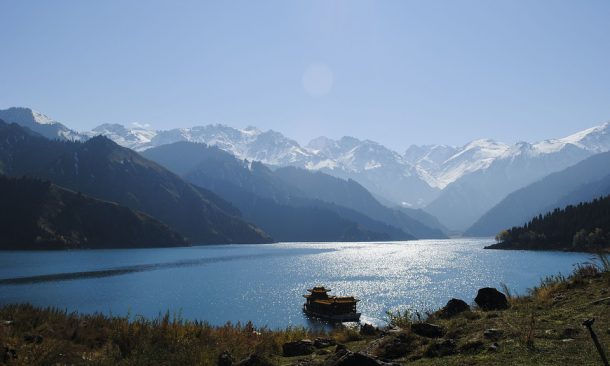
China : Safety by City
Xinjiang is located in the North West of China, in the Mongolian Uplands.
It is on the traditional Silk Road.
The region has historically been populated by the Uighurs, a people more closely related to those in Central Asia than to the Han; however, in recent decades, the Chinese government has given money to attract Han to move to the region.
The Uyghur people are renowned for their honesty, kindness, and open-mindedness towards outlanders.
Most of the tourists in this area are attracted by the opportunity to visit the Silk Road itself. And Golden Travel Route – The Taklimakan in Tarim Basin, South Xinjiang, is the world’s second-largest desert, which used to be dubbed “Death Sea.”
- Warnings & Dangers in Xinjiang
OVERALL RISK: LOW
Xinjiang is a safe enough travel region. There is a low crime rate, and you can travel freely at any time of the day or night. Of course, staying alert and taking the usual precautions is also worth it. Beware of pickpockets in the bazaars.
TRANSPORT & TAXIS RISK: MEDIUM
Public transport is not reliable enough. It may not be very convenient for movement and not go on schedule. Taxis are preferred for travel. Be sure to discuss the price of your trip before you board a taxi.
PICKPOCKETS RISK: MEDIUM
Pickpockets operate in street bazaars and crowded places. Traditionally, they work in groups, and often one will distract you, while the other will empty your pockets or steal a bag/backpack. Be especially vigilant in bazaars.
NATURAL DISASTERS RISK: MEDIUM
Xinjiang region is exposed to an array of natural hazards, including droughts, earthquakes, floods, heatwaves, landslides, and typhoons. Before traveling to this region, it is recommended that you study the situation for natural disasters and take appropriate measures.
MUGGING RISK: LOW
Armed severe robberies are not common here. This is instead an exception to the general statistics. However, it is worth taking appropriate security measures, neither getting drunk nor getting involved in drunken fights. If an incident has occurred with you, immediately contact the police.
TERRORISM RISK: MEDIUM
There have been no terrorist attacks in Xinjiang since 2017, mainly because of the Chinese governments' harsh responses against it such as mass surveillance, increased arrests, and a system of "re-education camps", estimated to hold a million Uyghurs and members of other Muslim minority ethnic groups.
SCAMS RISK: LOW
Fraud is not common in Xinjiang. However, isolated cases may occur when locals try to deceive tourists by overestimating the price of goods or travel by taxi. Also, be sure to purchase services (such as excursions) at licensed locations.
WOMEN TRAVELERS RISK: LOW
There will be no problem for women traveling alone in Xinjiang. It is safe enough, and you are unlikely to show unwanted attention. Wear modest clothing, especially near religious sites. Follow standard precautions to avoid problems.
- So... How Safe Is Xinjiang Really?
Xinjiang is considered a very safe region.
There is almost no crime, and it is safe to find in the whole region both in the daytime and at night.
Perhaps the greatest danger in Xinjiang can only be pickpockets.
The area is home to a vibrant bazaar culture where everyone and everything is traded.
The crowds here are large and create the right conditions for pickpockets, which often work as a team and can be very useful in what they do.
Be very careful with your values when you are away from home.
As a foreign traveler, you are the primary goal.
There is also a slight risk of receiving fake change bills.
It sometimes happens in shops or local restaurants.
Try to choose only the right places in the central parts of cities.
In general, Xinjiang is safe to travel if you take the usual precautions.
Keep track of your things, although it is unlikely that someone will rob you.
However, bad people are everywhere.
It is customary to bargain at the bazaars, and you can safely do it.
The price of goods is usually very high initially.
The best tool at your disposal is a simple smile – it has a disarming effect with almost everybody you meet.
- How Does Xinjiang Compare?
- Useful Information
Visitors to the mainland of the People's Republic of China must obtain a visa from one of the Chinese diplomatic missions unless they come from one of the visa-exempt countries. A valid passport is a must.
Rénmínbì or yuán is the official currency in Tibet. The distinction between renminbi and yuan is that the renminbi is the name of the currency and yuan refers to its primary unit. One yuan is subdivided into 10 jiao.
The best season for tourism in Xinjiang is autumn and more specifically from August to September. During these two months, the weather is cool but comfortable and attracting many tourists from within China and abroad.
Ürümqi Diwopu International Airport is an airport serving Ürümqi, the capital of the Xinjiang Uygur Autonomous Region in northwestern China. It is located in Diwopu township of Xinshi district, 16 km northwest of downtown Ürümqi. A hub for China Southern Airlines and as a focus city for Hainan Airlines, the airport handled 23,027,788 passengers in 2018, making it the 19th busiest airport in China by passenger traffic.
Travel Insurance
The travel insurance policy is a must when visiting a foreign country. Make sure you got it before starting your journey, the customs officer may ask for it.
Xinjiang Weather Averages (Temperatures)
- Average High/Low Temperature
China - Safety by City
- Where to Next?
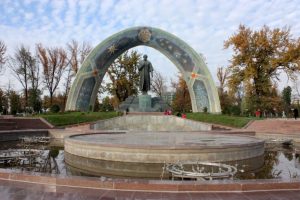
3 Reviews on Xinjiang
just a reminder that xinjiang is a region not a city plus the only “discrimination” I experienced is 2 hours at the customs every time I am going back from other countries
A safe region with many interesting spots
A special place, with very friendly inhabitants (mostly Uighurs) that will make you feel at home quickly. A very safe region, with some pickpockets mostly in crowded areas. Make sure to do a little bargaining in bazaars which everyone expects you to do especially since the prices are high at first.
not safe if you are uyghur
Share Your Experience Cancel reply
Your Review
Title of your review
Article Contents
- Xinjiang : Safety by City
- Overall Risk
- Transport & Taxis Risk
- Pickpockets Risk
- Natural Disasters Risk
- Mugging Risk
- Terrorism Risk
- Women Travelers Risk
- Weather Averages (Temperatures)
- User Reviews
- Share Your Experience
Popular Destinations

Safety Index
Recent reviews & comments.
- Jeremy Clarke on Milford
- Claude Mckenzie on Milford
- Arnold Brian on Milford
- Charles Carson on New Bedford
- Jared Norton on New Bedford
Popular US States
- Pennsylvania
Top 10 Things to Do in Xinjiang
Grasslands, lakes, deserts, valleys, and snow-capped mountains are scattered over the vast area of Xinjiang.
Xinjiang not only has the beautiful scenery, but also has rich ethnic culture. Xinjiang is the only province with 55 of the official 56 ethnic groups in China.
As an important transition zone on the Silk Road , Xinjiang is a good place to find some well-preserved ruins of the Silk Road era.
Here are the top 10 things to do in Xinjiang to seek out its charm.
Content Preview
1. meet the most beautiful side of xinjiang in kanas, 2. recall the scenes in the film kite runner in kashgar old city, 3. take a visit to heavenly lake, 4. appreciate apricot flowers in ili's xinghua valley, 5. go skiing in winter, 6. explore jiaohe ruins in turpan — the ancient ruins on the silk road, 7. explore kashgar livestock market — full of xinjiang features, 8. enjoy the cool nalati grasslands, 9. pay a visit to karakuli lake, 10. enjoy xinjiang food at erdaoqiao bazaar.
With a crystal lake whose water changes with the seasons, magnificent glaciers, vast grasslands, deep primeval forests, and wooden houses that local people live in, Kanas shows picture-postcard-perfect views, especially in autumn and winter.
When it is time to pick cotton in September and October, you can experience this local cash generator (Xinjiang is now China's No. 1 cotton base).
If you are intereted in a trip to Kanas, contact us to create a trip. Recommended tour: 8-Day North Xinjiang Tour with Kanas
Because of the war in Afghanistan, Kite Runner was shot in Kashgar where the style of architecture is very similar to Kabul's.
You can see beautiful Islamic and Uyghur architecture, and observe local life there: children playing on the streets, small shops selling food and souvenirs, and craftsmen making bronzeware.
Walking from the old city to Handicrafts Street, you can touch the semi-finished handicrafts and test the timbre of exotic musical instruments.
Recommended tour: 12-Day South Xinjiang Adventure Tour
Heavenly Lake (Tianchi) is a half-moon shaped lake on the north side of Bogda Peak in the Heavenly Mountains (Tianshan). Its water is clear as emerald, as if it were a jewel inlaid there. The surrounding mountains are covered with tall and green spruce and pine trees, shading the slopes from the sun.
You can take a boat trip to see the magical colors reflected on the surface of the lake and feel its beauty when silhouetted against the blue sky.
You can also hike around the lake or up into the valleys and breathe in the fresh air.
Recommended tour: 7-Day Xinjiang Highlights Tour
Xinghua Valley has China's largest pristine wild almond forest growing since the Middle Ages, covering an area of 20 square kilometers (8 square miles).
Every April , the vast green valley is littered with countless charming apricot flowers. The pink and white apricot flowers mixed with the huge green carpet and the winding and rolling slopes make the whole picture more layered and elegant.
In winter, besides enjoying the beautiful snow scenery, skiing is also a highlight of winter in Xinjiang. Lying against magnificent mountains such as the Heavenly Mountains and the Altai Mountains, Xinjiang has many great ski resorts.
One of its three biggest ski resorts is Silk Road International Ski Resort, which is near Urumqi. It was the venue for the 13th National Winter Games in 2016 and is certified by the International Snow Federation to hold international events. The most challenging ski trail in China, Xuanzang Avenue, is in this ski resort.
The unique feature of this ski resort is that the slopes are hidden in the forest. You can not only experience the speed and passion of skiing, but also enjoy the snow scenery on the northern slopes of the Heavenly Mountains .
Contact us to create a Xinjiang winter tour.
Jiaohe is the oldest place name in Turpan. The Jiaohe Ruins are the world's largest, oldest, and best-preserved city of raw-earth buildings. It is also the most complete ancient city preserved for more than 2,000 years in China. This ancient walled city was dug out from Turpan's yellow desert siltstone.
It was built in the 2nd century BC. From the 9th century to the 14th century, due to successive wars, it gradually declined and was abandoned.
From the ruins, you can learn about the city's unbelievable construction methods as you appreciate the stark beauty of the ruined city.
Recommended tour: 11-Day Along the Great Silk Road
The Livestock Market in Kashgar is one of the biggest features of Xinjiang. Cattle, sheep, camels, and other livestock are the main things traded there. Every Sunday, people take their livestock there for trade and shearing.
These livestock are not sold by weight there. When finding a suitable sheep, the buyer will observe its teeth to see how old it is, touch it, and hold it, and finally negotiate the price with the owner. If both parties are satisfied, they will shake hands to make a deal.
Nalati Grassland in Ili was once rated as one of the six most beautiful grasslands in China by China National Geographic.
It is bounded to the southeast by the Nalati Mountains as a barrier, and to the northwest by the Gongnaisi River. There are many mountain springs and streams crisscrossing each other. River valleys, mountains, deep gorges and forests form a natural summer resort.
From June to September, all kinds of wildflowers bloom on the grassland with herds of cattle and sheep.
Karakuli Lake is located at the foot of Muztagh Ata Peak, 'the Father of Icebergs'. Karakuli means 'Black Sea'. Set off by icebergs and snow-capped peaks, Karakuli's water is dark blue, and in rainy weather, black as a pool of ink.
On a calm day, the lake beautifully reflected the white peaks, green grasslands, and lakeside herds. It is great place to take photos.
When coming to Xinjiang, don't miss the chance to try Xinjiang food. Xinjiang is famous for its fruits and mutton dishes because of its long hours of sunshine and good pastures.
Erdaoqiao Market with its strong Islamic style is a good place to see all kinds of special Xinjiang foods and handicrafts. There is a food street bringing together more than 50 kinds of special food in Xinjiang: Xinjiang yogurt, grilled fish, lamb kebabs…
Tour Xinjiang with Us
If you are interested in visiting Xinjiang, please see our Xinjiang tours below for inspiration. All our tours can be customized.
- Along the Great Silk Road — Our 11-day Xi'an, Zhangye, Dunhuang, Turpan, Urumqi, and Kashgar tour is the most selected Silk Road itinerary.
- 7-Day Xinjiang Silk Road Highlights Tour — This journey takes you from Urumqi to Turpan then Kashgar for the cream of Xinjiang scenery and culture.
- 8-Day North Xinjiang Tour with Kanas
- More Silk Road tours
Or contact us to create a trip according to your group size, time, budget, interests, and other requirements.
- 2-Week Private China Tour: Beijing–Xi'an–Lhasa-Shanghai
- 12-Day China Silk Road Tour from Xi'an to Kashgar
- 11-Day China Classic Tour
- 14-Day China Natural Wonders Discovery
- 15 Best Places to Visit in China (2024)
- Best (& Worst) Times to Visit China, Travel Tips (2024/2025)
- How to Plan a 10-Day Itinerary in China (Best 5 Options)
- 8 Days in China: Top 15 Tours and Itineraries (2024/2025)
- China Weather in January 2024: Enjoy Less-Crowded Traveling
- China Weather in February 2024: Places to Go, Costs, and Crowds
- China Weather in March 2024: Destinations, Crowds, and Costs
- China Weather in April 2024: Where to Go (Smart Pre-Season Pick)
- China Weather in May 2024: Where to Go, Crowds, and Costs
- China Weather in June 2024: How to Benefit from the Rainy Season
- China Weather in July 2024: How to Avoid Heat and Crowds
- China Weather in August 2024: Weather Tips & Where to Go
- China Weather in September 2024: Weather Tips & Where to Go
- China Weather in October 2024: Where to Go, Crowds, and Costs
- China Weather in November 2024: Places to Go & Crowds
- China Weather in December 2024: Places to Go and Crowds
Get Inspired with Some Popular Itineraries
More travel ideas and inspiration, sign up to our newsletter.
Be the first to receive exciting updates, exclusive promotions, and valuable travel tips from our team of experts.
Why China Highlights
Where can we take you today.
- Southeast Asia
- Japan, South Korea
- India, Nepal, Bhutan, and Sri lanka
- Central Asia
- Middle East
- African Safari
- Travel Agents
- Loyalty & Referral Program
- Privacy Policy
Address: Building 6, Chuangyi Business Park, 70 Qilidian Road, Guilin, Guangxi, 541004, China
- Skip to primary navigation
- Skip to main content
- Skip to primary sidebar
Travel China Cheaper
Travel China the smart way! Expert tips and travel advice for China tourists and expats.
PLANNING A TRIP TO CHINA? Start Here
Which Parts of China Require a China Travel Permit in 2024?
January 26, 2024 By Josh Summers
Are there places in China that require a permit to travel? It’s a legitimate question because there are, in fact, a few places in China where foreign travelers aren’t allowed to visit and a few that require special China travel permits. Let me explain.
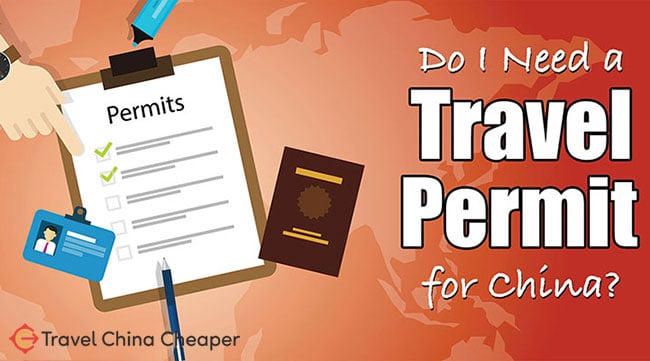
The ultimate fear of most any international traveler is that they’ll spend all their time planning and yet when they arrive to their destination they are denied entry.
Thankfully, obtaining a Chinese visa will grant you free access to 85% of the country, but naturally it’s that remaining 15% that might cause you concern.
- Are there places in China that are just flat off-limits?
- Which places require a China travel permit?
- How does a traveler go about getting an official travel permit for any of these areas of China?
Hopefully I can answer all of these questions for you below. You can use the navigation links here to jump down to a specific section, or continue scrolling to read more:
- Which places in China are “off limits”?
- Which regions in China require a permit to visit?
- How to get a permit for restricted regions in China
This is an example of just one helpful chapter in my book Travel to China | Everything You Need to Know Before You Go . Grab a copy and find out why it has become a best-selling travel guide on Amazon!
Which Places in China are “Off-Limits”
There are a few areas around China that are considered “off-limits” for foreign travelers. While that may sound strange at first, you have to understand that the same can be said for many countries around the world.
These off-limits places include:
- Military Bases: You may be thinking “well, of course” here, but you need to consider the fact that you don’t know where China’s military bases are . I’ve known travelers who went hiking in the mountains only to find themselves being approached by military guards asking their business for being there. If you’re straying off the beaten path in China (for example, if you’re camping in China ), you’ll want to pay careful attention to this one.
- International Border Regions : It makes sense to say that China’s border with North Korea is “off-limits,” but you may not realize there are many international borders along the western region of Xinjiang (Kazakhstan, Tajikistan, Kyrgyzstan, Pakistan & others), Tibet (India & Nepal) and even Yunnan (Myanmar, Laos and Vietnam). These borders are often heavily guarded and closed to anybody who doesn’t already have a visa to the next country.
- Politically Sensitive Areas: China is a very sensitive country that doesn’t want its warts to be seen by the outside world. That’s why they closed off access to a famous Tibetan Monastery in Qinghai following Tibetan unrest as well as many small Uyghur villages in Xinjiang following Uyghur unrest . Again, it’s hard to know what’s closed or open here, but you should be aware and flexible when entering a politically sensitive area.
These “off-limits” areas make up only a small portion of China and, frankly, are not part of any major tourist route.
More than likely you won’t have to worry about this, but it’s good to know about.
Which Regions of China Require a Permit to Travel?
The biggest restricted portion of China (almost 13%) goes to areas which require a travel permit for foreign travelers.
This China travel permit must be stamped by a local government and are carried either on your person or with your tour group leader. You can be sure that the permits will be checked at the checkpoint.
There are three primary places where a permit is required to travel in China:

- Tibet Autonomous Region : Most people are aware that you can’t just waltz into Tibet whenever you want. A travel permit is required to enter Tibet and at this time is can only be issued through a travel group (more on this below). There is no independent travel in Tibet.
- Parts of Xinjiang : Although the enforcement of this continues to change from year to year, historically travelers have needed a China travel permit to travel the Karakoram Highway (the road from Kashgar to Pakistan) or to visit many of the ancient desert ruins in southern Xinjiang.
- International Border Regions: Although technically not a “travel permit,” in order to approach any international border, you will be required to show proof of an ongoing visa to that country. The only exceptions here are borders where they issue a visa on arrival, such as the Kyrgyzstan border for most US citizens or UK citizens.
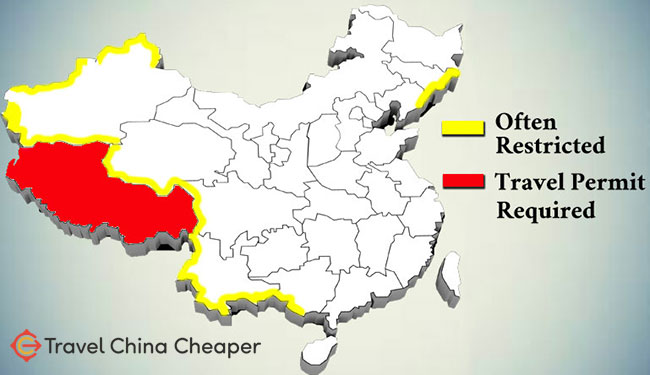
How to Get a China Travel Permit for Restricted Areas
Of course, if the place you want to travel (Tibet, parts of Xinjiang, sensitive border regions) require a special China travel permit, what are your options?
How do you obtain a China travel permit?
Here’s a quick breakdown of the various permits and how to get them.

How to Get a Tibet Travel Permit
As a foreign passport holder, you cannot board a train or plane bound for Tibet without a Tibet Travel Permit. And you cannot obtain a Tibet Travel Permit without first going through a tour group.
Sadly, there is no such thing as “solo travel” when entering Tibet…technically.
You’ll need to apply for this permit through a reputable China travel agency , the vast majority of whom will require you to purchase one of their travel packages to do so.
The whole application process takes a couple weeks (submission, approval and delivery to your China hotel), so budget plenty of time.
How to Get a Xinjiang Travel Permit
Whereas the process to apply for a Tibet Travel Permit is clear and written out, the Xinjiang permit is much more confusing.

One reason is that the “restricted areas” of Xinjiang seem to constantly change.
Some travelers have been turned away at police checkpoints while traveling in Xinjiang, completely unaware that they needed a permit. There are two things you can do here:
- You can go through a Xinjiang travel agency such as Old Road Tours , but they will require you to purchase a multi-day tour from them.
- You can purchase the FarWestChina Xinjiang travel guide , which gives you access to a travel forum with hundreds of other Xinjiang travelers who can tell you what is/isn’t open. In most cases, a permit is issued by a travel agency within Xinjiang.
As for the international borders, the primary documentation you’ll need is an ongoing visa to the country you’re approaching. A particular China travel permit isn’t necessary in this case.
The Truth About China Travel Permits
For most China travelers, getting an extra permit won’t be necessary.
It’s not unless you have a desire to visit Tibet, get far off the beaten path or get near an international border that you need to think about applying for an additional permit.
If you find that a China travel permit is necessary, begin your search for a reliable travel agency that can help you submit your application. They’ll need a copy of your passport in addition to your China visa – and remember that most agencies will require you to purchase one of their tour packages.
It sucks, but you gotta pay the piper, you know?
Pro Travel Tip for China
If you get to an area that requires a permit and you weren’t prepared, plead ignorance. Often times the officers in charge will allow you to purchase one on the spot for a more expensive fee, but do not expect them to do this. Plan ahead and just ask people in the area where you’re traveling if there are any travel restrictions.
While a China travel permit is nothing more than a stamped piece of paper, you will be required to show copies at almost every checkpoint.
You must have them!
And while you’re getting this prepared, make sure you check out many of my other pro traveler tips for China .
Further Reading & Resources

Traveling or Moving to China Soon?
Download "44 Tips You MUST Know Before Traveling to China". These simple but often overlooked tips could make or break your trip !
Download the Tips Here
About Josh Summers
Josh is the founder of TravelChinaCheaper.com who has been living in China with his family since 2006. Over that period of time he has traveled by plane, train, car, motorcycle and even camel to explore almost every corner of the country.
Are you planning to travel or move to China soon?
Don't miss out on these 44 money-saving tips!
© 2024 Go West Ventures LLC | Best-Selling China Travel Guide | Contact | Affiliate Disclaimer | Privacy Policy
Young Pioneer Tours

Is it safe to travel in Xinjiang?
Xinjiang is one of our favourite parts of China. Part Middle Kingdom, part Central Asia, when you’re in a city like Kashgar you feel as though you’re closer to Tehran or Damascus even if you don’t realise that you actually are!
You may also notice if you go there that the whole Autonomous Region feels like a police state, with constant police checks.
And Xinjiang has, of course, had more than its fair share of chaos in recent decades, with riots, terrorist attacks on civilians and on police stations.
But, with our knowledge of local life, Uyghur people and the Chinese state, we think it is totally safe to travel there, providing the normal tourist precautions are in place. Like all places you are new to, you shouldn’t walk around busy market areas flashing mobile phones or money around. And like all Muslim regions, you should try to be relatively conservative in behaviour and appearance.
You will find then that the local population are also friendly, inquisitive and just the kind of people YPT like to meet on tour. We always walk down the streets of the old town in the hope of walking past a Uygur wedding that you invariably get invited in for!
Do I need a special visa or permit for Xinjiang?
Simple answer, no. The Xinjiang Autonomous Region is not like Tibet , where foreigners need a permit to enter. We are free to visit and move around as we please.
Within reason. The big cities like Urumqi, of course, are no problem, but once you get into the smaller towns in the border areas and south of the Taklamakan Desert, you may find the police become more interested in your movements or even tell you to leave. Officially many of the towns can’t house foreigners overnight because the hotels don’t have the official permission to do so, but oasis town-hopping in the daytime shouldn’t be a problem.
Ultimately, if a police officer tells you, you have to leave or you are not allowed entry to a place, you don’t have much choice, but a bit of Chinese always helps!
How do I get to Xinjiang?
If you’re coming from inner China, then there are of course trains and flights to Urumqi. Don’t underestimate the size of Xinjiang though, the train from Urumqi to Kashgar is itself 24 hours long!
Otherwise, you can cross into Xinjiang from border points in Kazakhstan (there’s a train between Almaty and Urumqi) and Kyrgyzstan (by bus or car), as well as Pakistan from the Karakoram Highway and Tajikistan.
Check out our guide to travel in Xinjiang or see the itinerary for our Xinjiang, China Far West tour!
About post author.

Alistair Riddell
Spending most of his time in Cuba, Alistair leads both our Central and South American tours. He particularly enjoys the lesser-seen side of Cuba where regular tourists don’t venture, such as relics of Cuba’s Soviet relations and also exploring the ‘new’ Cuba – seeking out new restaurants, bars and other private businesses.
See author's posts
- Suspendisse tincidunt nunc nec
Tripadvisor
Latest news.

Thailand extends its visa policies from June 2024

YPT group attends epic Rammstein concert in Belgrade on May 24th 2024

Ecuador Travel Update – May 2024

An American in South Korea Heads North (Part 1)
- Terms & Conditions
- Payment Policy
- North Korea Tours – 2017 Tours
- Tour Extensions
- Independent Tours
- North Korea FAQ
- Our Terms and Conditions
- Our Payment Policy Terms
©YoungPioneerTours.com 2024. All rights reserved.
Xinjiang: An integral part of Chinese civilization

"In fact, the story of Xinjiang fully demonstrates that Chinese civilization has always remained vibrant through its inclusiveness," Pan said.
Because of the ancient Silk Road, jointly opened up by ancestors of the Western Regions and the Central Plains, numerous trading cities have been built including Kashgar, Pan added.
"Over several thousand years, people from all directions and ethnic groups migrated, settled, traded, intermarried and formed a coexistence pattern in Xinjiang. Ultimately, Xinjiang and the Central Plains belonged to the same political community, which was the inevitable result of the development of economic, social and cultural communities," Pan said.
Zhang Zhizhen seeded at Wimbledon despite Halle loss
Rainfall continues in south china amid receding water levels, china launches astronomical satellite developed with france, water project halted to protect nesting swallows, president's home visit leaves deep impression, art empowers rural revitalization in shaanxi village.
- China Daily PDF
- China Daily E-paper

- 86-19138970032 (GMT+8 18:00~09:00)

- Beijing Xian Tours
- Shanghai Beijing Tours
- Hong Kong Guilin Tours
- Hangzhou Suzhou Tours
- Kunming Lijiang Tours
- Shanghai Yangtze Cruise Tours
- Chengdu Tibet Tours
- More Short Stay Tours
- China Tours in January
- China Tours in February
- China Tours in March
- China Tours in April
- China Tours in May
- China Tours in June
- China Tours in July
- China Tours in August
- China Tours in September
- China Tours in October
- China Tours in November
- China Tours in December

- High Speed Trains
- China Yangtze Cruise Tour
- Photography
- Desert Adventure
- Ethnic Villages
- Biking Tours
- Kung Fu Tours
- Heritage Sites Exploration
- China Spring Tours
- China Summer Tours
- China Autumn Tours
- China Winter Tours
Notice! 2024 available cruise routes include 4~5 days Chongqing-Yichang(most classic) and 11~12 days Chongqing-Yichang-Shanghai(limited).

- Best-value Yangtze Cruises
- Top Family-friendly Cruise Ships
- Top 3 Luxury Yangtze River Cruises
- Yangtze River Highlights
- Yangtze River Cruise Routes
- Upstream or Downstream?
- Dining & Drinking
- Accommodations
- On-board Activities
- Yangtze Cruise Booking Steps

- Inner Mongolia

- Fanjingshan
- How to Plan Your First China Tour
- How to Plan Beijing Tour
- How to Plan Xian Tour
- How to Plan Shanghai Tour
- How to Plan Guilin Tour
- How to Plan Sichuan Tour
- How to Plan Family Tour
- 2024 China Travel Ideas
- Best Time to Visit China
- What to Pack for Your China Journey
- Make Payment in China
- Updated China Travel News
- Ultimate Chinese Visa Guide
- Chinese Visa Types
- Chinese Visa Requirements
- Do I Need a Visa for China
- Chinese Visa Application
- Chinese Visa Exemptions
- 144-hour Visa Free
- Shenzhen Visa on Arrival
- Hainan 30-day Visa Free
- Embassies & Consulates
- Invitation Letter
- Useful Visa FAQs & Tips
- Entry Regulations
- Baggage Allowance
- Customs Declaration
- Exit Regulation
- How to Book Train Tickets
- How to Collect Train Tickets
- How to Cancel & Alter Train Tickets
- How to Read Train Tickets
- China High Speed Train Types
- Seats Class & How to Choose
- Friendly Facilities on the Train
- The Train Station Departure Process
- Available Food and Drinks on the Train
- Western Toilets on the Train
- Luggage Racks & Baggage Allowance
- Beijing Train Stations
- Shanghai Train Stations
- Guilin Train Stations
- Xian Train Stations
- Chengdu Train Stations
- Hong Kong West Kowloon Railway Station
- Beijing - Xian
- Beijing - Shanghai
- Guangzhou - Shanghai
- Shenzhen - Shanghai
- Chengdu - Xian
- Shanghai - Hangzhou
- Shanghai - Xian
- Chengdu - Chongqing
- Kunming - Lijiang
- Beijing Capital International
- Beijing Daxing International
- Shanghai Pudong International
- Shanghai Hongqiao International
- Guangzhou Baiyun International
- Hangzhou Xiaoshan International
- Chengdu Tianfu International
- Chengdu Shuangliu International
- Xian Xianyang International
- Shanghai - Beijing
- Hong Kong - Shanghai
- Guangzhou - Beijing
- Chengdu - Lhasa
- Shanghai - Guilin
- Shanghai - Sanya
- Travel in Spring Season
- Travel in Summer Season
- Travel in Autumn Season
- Travel in Winter Season
- Weather in January
- Weather in February
- Weather in March
- Weather in April
- Weather in May
- Weather in June
- Weather in July
- Weather in August
- Weather in September
- Weather in October
- Weather in November
- Weather in December
- Top 10 China Destinations
- Top 15 Things to Do
- China World Heritage Sites
- Top 10 Best Natural Beauties
- Top 10 Museums in China
- Top 10 Old Towns & Villages
- Five Great Mountains in China
- Top 10 Monasteries & Temples
- Top 10 Ski Resorts
- Top 10 Beautiful Lakes in China
- 7 Best Beaches in Sanya
- Top 6 Beautiful Waterfalls
- Panda Volunteering
- Having fun on Ice and Snow Festival
- About Us Who We Are Our Team Why Travel with Us Feedback & Reviews Travel Stories Travelers' Gallery Payment Guide Customer Support Contact Us
- Tour Experiences
Destinations
- Travel Guide
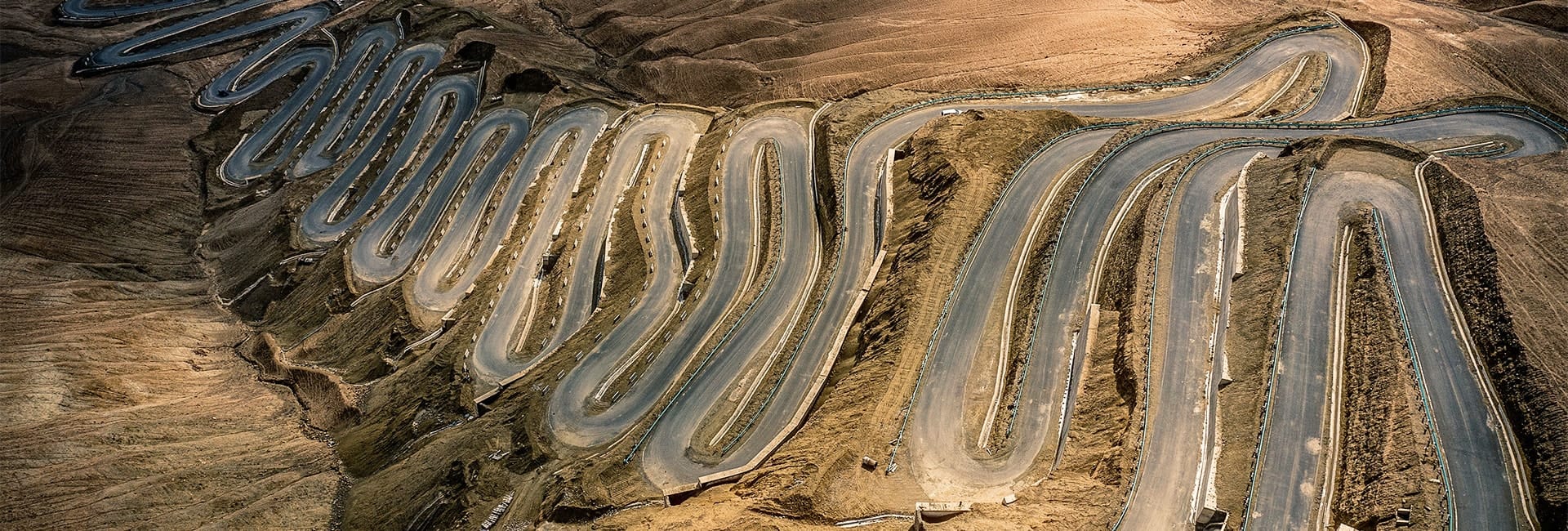
How To Plan A Trip To Xinjiang: Xinjiang Trip Planner 2024/2025
It is impossible to travel to Xinjiang but not be awestricken by its long-lasting cultural fragrance of the ancient Silk road, scenic beauty of diverse landforms, as well as the colorful life of the ethnic minority groups. Owning an unmanageable wealth of attractions, Xinjiang offers explorers a once-in-a-lifetime journey. You can follow the ancient traders' footsteps and explore the prosperous trading towns (such as Kashgar, Turpan, Hami, Kuche, Aksu, etc.) along the Silk Road in Xinjiang, and immerse yourself in the by far most extraordinary landscapes like alpine lakes in emerald green or blue, rolling grasslands dotted with nomadic herds, magnificent grand canyons with distinct landforms, glaciers-encrusted mountain areas, etc. Besides, Xinjiang is the perfect place to probe into China's diversity in that you are able to see the lifestyle of lots of ethnic groups, including Uyghur, Han, Kazak, Hui, Mongolian, Tatar, Russian, etc.
Xinjiang's riveting beauty demands immediate action. In fact, traveling to Xinjiang is not as easy as other cities, because of its large area. This Xinjiang Trip Planner helps you focus on what to do and see, where to stay, when to go and more practical information you need to know and travel to Xinjiang in an efficient way. Just browse our top Xinjiang tours or contact us to customize your own Xinjiang trip.
Where to Go in Xinjiang - Kashgar, Turpan, Kanas…
As the largest province in China, Xinjiang covers an area of 16% of China's total land area. Generally, Xinjiang can be divided into Northern Xinjiang and Southern Xinjiang by the Tianshan Mountains. The top tourist destinations in Southern Xinjiang include Kashgar, Korla, Kuqa, Hotan, Aksu, etc., while the recommended places to visit in Northern Xinjiang include Urumqi, Turpan, Altay (Kanas), Ili (Yining), Karamy, Bortala, etc.
◆ Kashgar - Essence of Xinjiang: It is said that a Xinjiang tour is not completed without a visit to Kashgar. Kashgar once was a major market city along the Silk Road and both the northern and the southern silk routes crossed here. Kashgar Old City with a history of over 2,000 years is the best place to experience local life and customs. In Id Kah Mosque and Abakh Hoja Tomb, you can feel the strong religious atmosphere and listen to the old story of legendary Xiang Fei and her family. Don't miss Tashkurgan (Taxkorgan) where the old tradition of China's only Caucasian ethnic group is preserved. On your way to Tashkurgn from Kashgar City, you will view stunning Karakul Lake, White Sand Lake, Muztagh Ata, grasslands, valleys, etc. Learn more>
◆ Turpan - Important Outpost on the Silk Road: Turpan used to be one of the political, economic and cultural centers of Northwestern China and many cultural heritage sites can be admired here. The Karez System, still used today, is a brilliant irrigation project which makes Turpan an oasis in the desert. Jiaohe Ancient City is a precious ruin telling the history of the disappeared kingdom. The precious murals in Bezeklik Caves and Mazaar Village hidden in Tuyuk Valley also deserve your time. If you are interested in wild nature, just go to Kumtag Desert, which is quite close to Turpan City. Learn more>
◆ Kanas - God's Private Garden: Kanas with turquoise lake, zigzag rivers and bays, dense forests and pristine Tuva villages is praised as the Switzerland of the Oriental and God's Garden. There are different ways to appreciate the beauty of Kanas, including climbing to Guanyu Pavilion for a panoramic vista, taking a boat on the lake, hiking along the three beautiful bays, etc. If you want to capture the best colors of Kanas, just go in September and early-October when Kanas are dotted with colorful birch trees. Learn more>
◆ Urumqi - Tourist Distribution Center: Equipped with convenient airlines and several railways, Urumqi is the major transfer hub in Xinjiang. Most travelers start their Xinjiang tours from Urumqi. In addition to its pivotal role in transportation, it also has something to delight visitors. Nanshan Pasture is a popular summer resort to breathe fresh air and enjoy natural scenery. Xinjiang Regional Museum offers a glimpse of the history and culture of Xinjiang. Xinjiang International Grand Bazaar is a popular site to view Xinjiang-style handicrafts and feel ethnic market culture. Besides, it is available to take a half day's side trip to Heavenly Lake of Tianshan Mountain (Tianchi).
◆ Hotan - Another Historical Legacy of the Silk Road: Hotan (Heitan) is another place to explore the mystery of the ancient Silk Road, and many technologies, religions and philosophies were exchanged here. Hotan Museum with treasured collections is the best place to learn the history and culture of Hotan and the Silk Road. It is also available to visit some family workshops to see how Hotan carpets are made. Traveling along the Hotan-Altar Desert will be an awesome experience. Learn more>
In addition to these key locations, there are still many other places to visit in Xinjiang, including Takamakan Desert - the largest desert in China, Ili - a summer resort with numerous grasslands and flowering fields, Sayram Lake - the largest alpine lake in Xinjiang, Karamy - a mysterious site with unique landform, Kucha - one cultural center in Southern Xinjiang, Hami - the microcosm of Xinjiang, etc.
Keep Reading: Kashgar Tour Packages | Turpan Tour Packages | Urumqi Tour Packages | Kanas Tour Packages
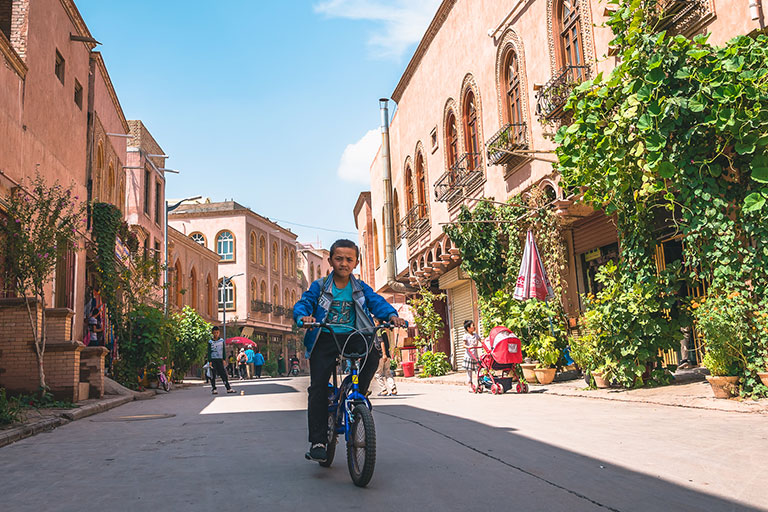
Kashgar Old City © 文刀四火 / mafengwo
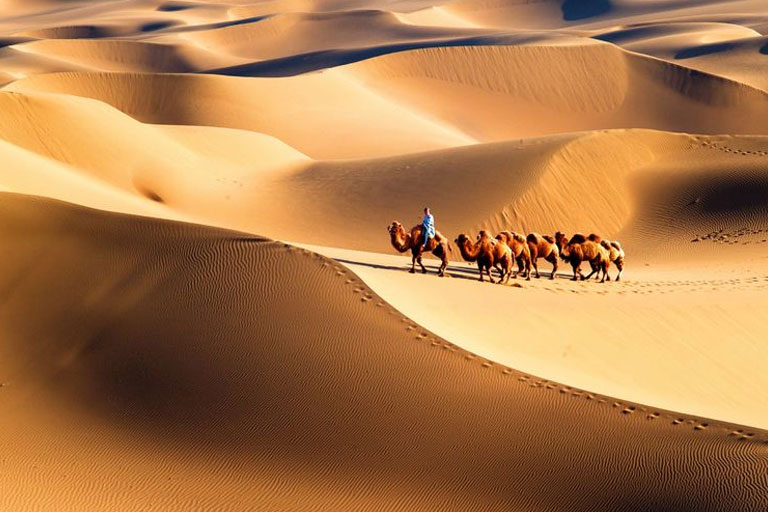
Kumtag Desert © 老乐 / meipian
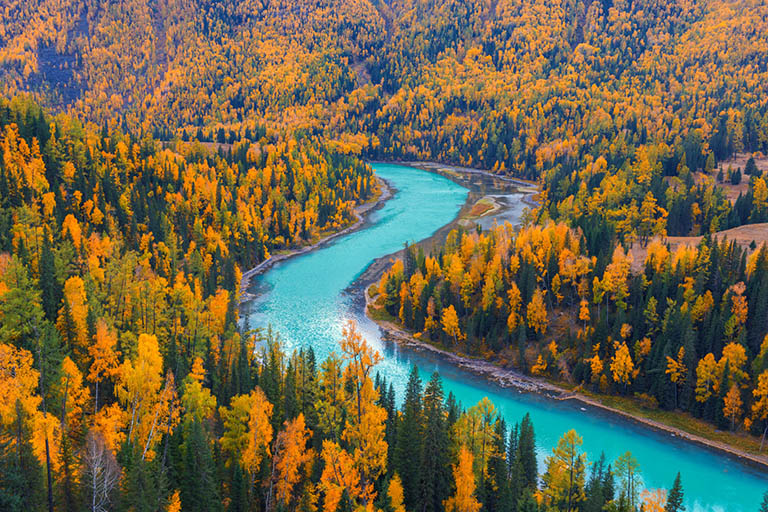
Autumn Scenery of Kanas Lake © GOOM果果 / mafengwo
What to Do in Xinjiang - Photography, Hiking, Skiing, Biking…
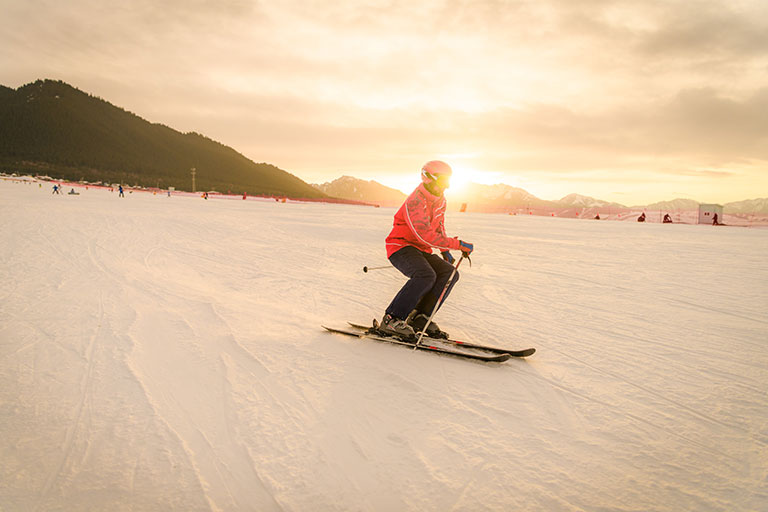
Silk Road International Ski Resort ©少年环游记 / kuaibao
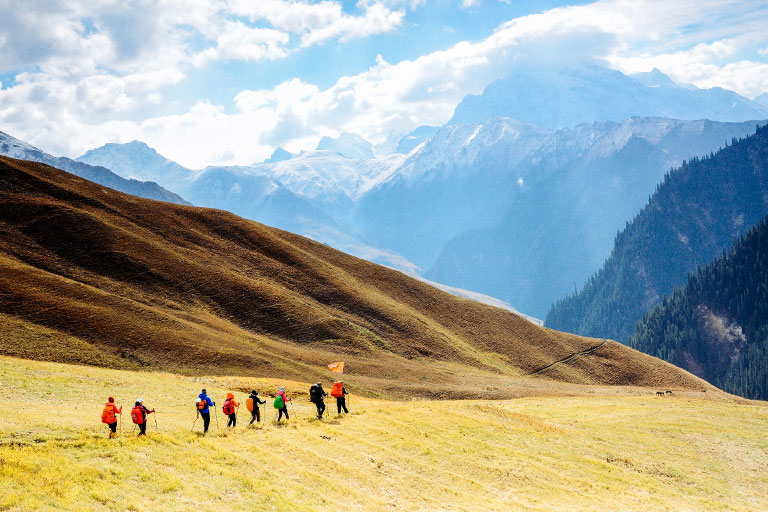
Hiking on Wusun Ancient Road ©穆羽Grace / mafengwo
The great Xinjiang experience is about so many things: sightseeing, photography, hiking, biking, camping, etc. No matter if you are shutterbug, hiking fan, cyclist, or other outdoor activities enthusiast, Xinjiang definitely meets your expectations.
Photography: Whether you are a professional photographer or not, it is just a piece of cake to get some nice photography works in Xinjiang. The most preferred sites are Kanas studded with multi-colored birch trees in autumn, Kucha Grand Canyon covered with reddish brown rock in various shapes, Karamy Ghost City (Wuerhe Ghost City)- China's most beautiful Yardang landform geopark with numerous earth formations, Dushanzi Grand Canyon - a deep canyon with far-reaching views, Karajun Grassland - a less obvious but no less impressive grassland with amazing Human Grassland, etc.
Hiking: For anyone who wants to stretch your legs, Xinjiang doesn't disappoint you. Kanas is an ideal hiking destination for travelers in different physical conditions. You can enjoy a comfortable hike around Hemu Village first, and then a full day's hike in Kanas Lake Scenic area. Turpan Grapes Valley also offers a nice hiking route if you are interested in involving some historical sites in your itinerary. You can also hike on Wusun Ancient Route, which is the throat connecting the north and south of Tianshan Mountain. Moreover, it is also available to hike around Karajun Grassland and enjoy the incredible grassland scenery on the way.
Skiing: Xinjiang is a wonderful place for winter fun as well. If you are fond of skiing, there are many great ski resorts for you. Silk Road International Ski Resort located in Urumqi is the largest ski resort in northwestern China and different trails are equipped to meet different skiers' needs. General Ski Resort in Altay is China's only alpine ski resort connected to the city. Koktokay International Ski Resort located in Koktokay Scenic Area offers both a skiing experience and a fascinating snowscape. Besides, Naraty International Ski Resort (in Ili), Baiyun International Ski Resort (in Urumqi), Xuelianshan Golf and Ski, Weisite Happy Town Ski Resorts, etc. are also available.
Biking: Xinjiang is not a famous destination for biking, but the biking experience around Sayram Lake is enough. Especially in summer when the nearby grasslands are covered with wild flowers, you will enjoy a never-tiring trip. If you are confident in your strength, biking from Burqin to Kanas Lake is a nice choice. Or spend 1 to 2 days biking from Karamy Ghost City to Karamy City and indulge yourself in the unbelievable desert trails.
How Long to Stay in Xinjiang and How to Create An Itinerary
As numerous attractions are scattered across 1,660,000 square kilometers, even one month is not enough to get an in-depth discovery of Xinjiang. However, it is possible to organize a smart itinerary to make full of your time.
For first timers, we suggest you spend 6 ~ 8 days enjoying Xinjiang highlights by visiting the most classic destinations - Urumqi, Turpan and Kashgar, which blend cultural features with natural landscapes. Usually, it takes 2 days to explore Urumqi City highlights (Nanshan Pasture, Xinjiang Grand Bazaar and Heavenly Lake of Tianchi), 2 ~ 3 days for Turpan essences (Karez System, Jiaohe Ancient City, Turpan Museum, Beziklik Caves and Kumtag Desert), and 3 ~ 4 days Kashgar highlights (Id Kah Mosque, Kashgar Old Town, Kashgar Bazaar, Ancient Tea House and Karakul Lake and Tashkurgan Fort).
☛ 6 Days Urumqi Turpan Kashgar Efficient Tour
☛ 8 Days Xinjiang Classic Tour(Urumqi - Turpan - Kashgar)
Of course, other destinations are also worthy of you exploration. If you have more days to stay in Xinjiang, or you get an opportunity to stay in some specific destinations for a few days, it is advised to enjoy the sublime scenery of Kanas Lake and Hemu Village in 1 ~ 2 days, visit the vast grasslands and flowering fields of Ili in 2 ~ 3 days, feel scenic splendor of Sayram Lake in 1 day, take an adventure through the desert highway in Taklamakan Desert in 1 day, admire the historical charm of Kucha in 1 ~ 2 days, experience the Silk Road glories of Hotan in 1 ~ 2 days, feast on the unique landforms in Karamy in 1 ~ 2 days, etc.
☛ 13 Days Xinjiang Silk Tour
☛ 10 Days Stunning Ili Apricot Blossom and Naraty Grassland Tour
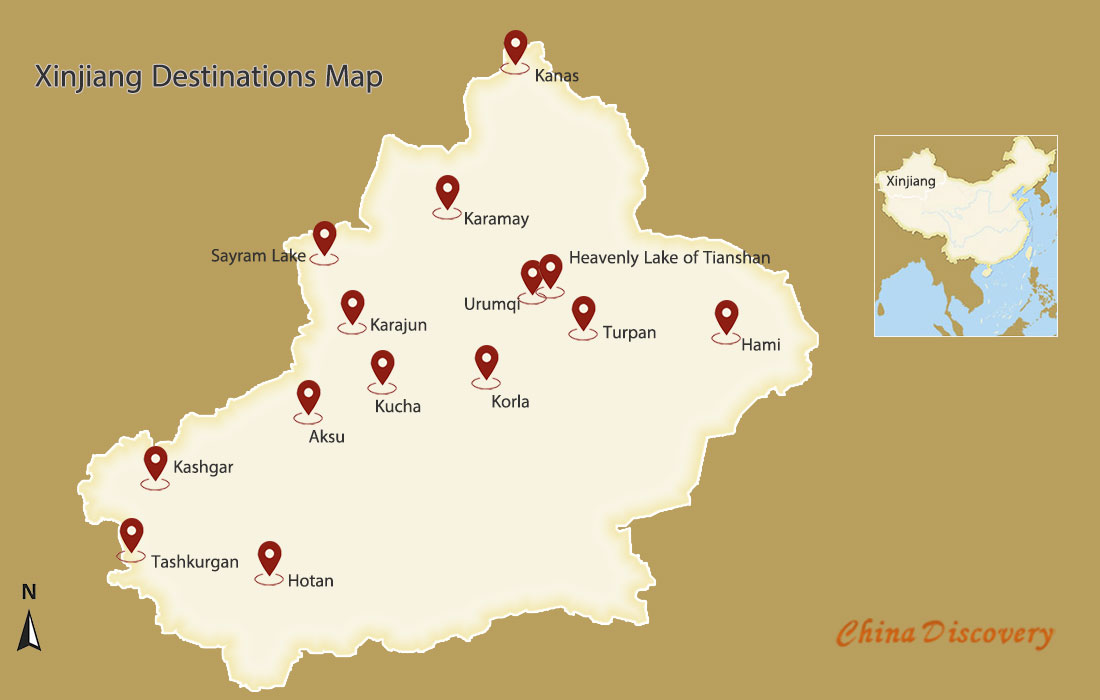
Xinjiang Destinations Map
How to Organize Special Themed Tours - Silk Road, Landscape, Winter…
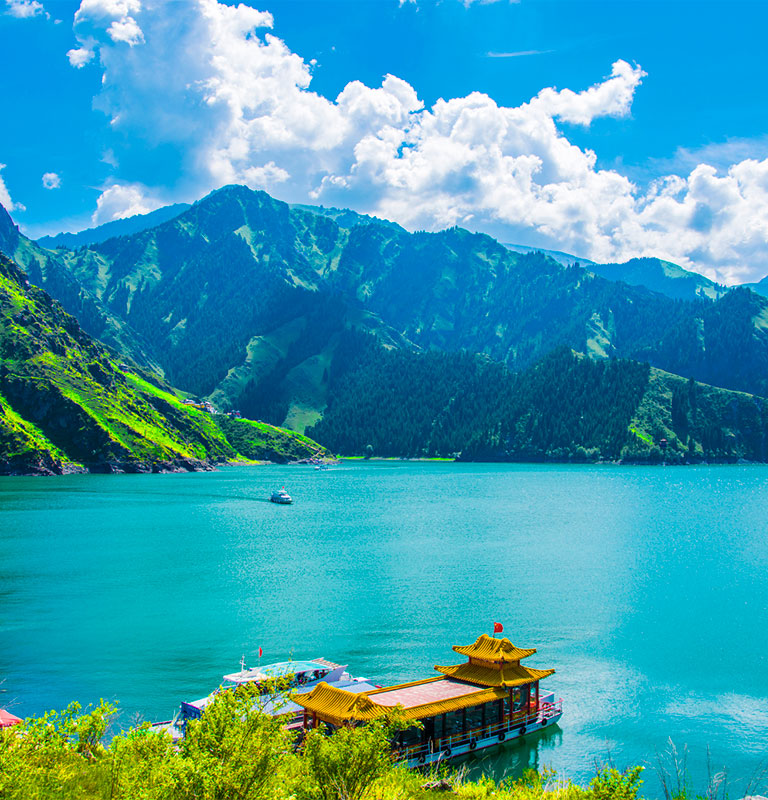
Heavenly Lake of Tianshan © 陈巍伟 / mafengwo
Some travelers want to enjoy a classic tour with different experiences packed in one tour, while some travelers have strong interests in a special tour with a specific theme. Usually, this kind of tour takes a longer time.
Landscape Tour: It takes about 10 days to view the best landscape of Xinjiang, including primitive grasslands, alpine lakes, peaceful villages and geographical wonders. Recommended attractions are Kanas Lake, Wuerhe Ghost City, Sayram Lake, Karajun Grassland and Dushanzi Grand Canyon.
☛ 11 Days Xinjiang Landscape Tour
Silk Road Tour: As everyone knows, Xinjiang is the top place to trace the Silk Road mystery. The Silk Road broke into three routes in Xinjiang and there are many places to explore the glorious past. You are advised to spend about 12 days visiting can't-be-missed Silk Road destinations, including Turpan, Korla, Kucha, Hotan, Kashgar and Tashkurgan.
Adventure Tour: Want to feel the adrenaline rush? Just take an adventure through the desert highway in Taklamakan Desert, which is also favored by culture and nature lovers. It is rather popular to have a 9 ~ 10 days tour with Taklamakan Desert adventure and Silk Road exploration.
☛ 9 Days Taklamakan Desert Ancient Silk Road Tour
Winter Tour: Winter is the best time to join snow activities and indulge in snow scenery. Kanas is a wonderful winter destination and a Kanas winter tour involving sightseeing and skiing experience takes at least 4 ~ 5 days.
In addition, China Discovery has well-designed different travel styles for hiking, foodies, culture lovers, students and family as well. Contact us for your own Xinjiang experience.
How to Extend Your Xinjiang Tour - Gansu, Qinghai, Tibet…
The beauty of Xinjiang is beyond your imagination, but traveling to Xinjiang only is not enough. If your time permits, extending your Xinjiang tour to its alluring neighbors and other top destinations in China is strongly recommended. The most popular choice is traveling along the frightens of the Silk Road in China, such as Xian, Lanzhou, Xining, Zhangye, Dunhuang, Jiayuguan, etc. For excitement seekers, traveling Xinjiang with Tibet is the ultimate experience of China's unworldly scenery.
Gansu - Golden Part of The Silk Road: Xinjiang is always traveled with Gansu to fully discover the splendor of the Silk Road. It offers several world-class cultural heritage sites, including Mogao Grottoes, Maijishan Grottoes, Jiayugaun Great Wall, Binglingsi Grottoes, etc., as well as countless natural draws. A classic Gansu tour takes 6 ~ 8 days, including 2 ~ 3 days in Dunhuang, 2 ~ 3 days in Zhangye, 1 ~ 2 days in Jiayuguan and 1 ~ 3 days in Lanzhou. Check Gansu Tours>
Qinghai - High Plateau with Unique Culture: Qinghai is also a big province, but travelers usually visit its key locations - Qinghai Lake, Chaka Salt Lake and Xining which take about 4 days. It is also available to visit some other not obvious but no less impressive sites, such as Kanbula National Forest, Tongren, Amne Machin in 1 ~ 3 more days. Check Qinghai Tours>
Tibet - The Roof of The World: Located in the Qinghai-Tibet Plateau, Tibet features unbelievable high plateau scenery of turquoise lakes, snow peaks and glaciers… as well as a holy Buddhist land with lots of temples and palaces. For the first timers, 4 ~ 8 days are suitable to have a classic tour. The top destinations must be Lhasa, Shigatse, Everest, Namtso and Ngari. Check Tibet Tours>
Not enough? Many big surprises await, like UNESCO-recognized heritage sites in Beijing (3 ~ 4 days), thousand-year old miracles in Xian (2 ~ 3 days) skyscrapers and lively night view of Shanghai (2 ~ 3 days), stunning karst landscape in Guilin (3 ~ 4 days), cute Giant Pandas in Chengdu (1 ~ 2 days), strange rocks and peaks in Huangshan (3 ~ 4 days), Avatar World in Zhangjaijie (3~4 days), etc.
☛ 10 Days Classic Silk Road Tour (Xian/Dunhuang/Turpan/Kashgar)
☛ 11 Days In-depth Wild Silk Road Adventure Tour (Lanzhou/Zhangye/Jiayuguan/Dunhuang/Turpan/Urumqi/Kashgar)
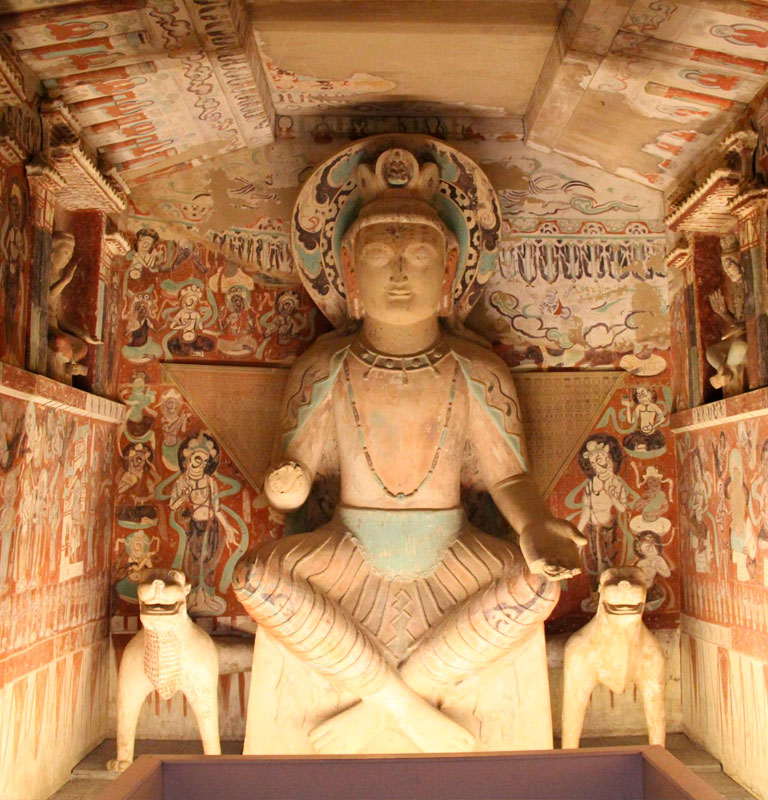
Mogao Grottoes ©ctrip
Xinjiang Weather and Best Time to Visit Seasonal Landscape in Xinjiang ©travelxj As a landlocked land located in the middle Asia and far away from oceans, Xinjiang belongs to the typical Temperate Continental Climate. Xinjiang is obviously characterized by an arid climate, low rainfall and evaporation. The monthly average precipitation is about 150 mm and the monthly average sunshine hour is 200 ~ 300 hours. The temperature difference between day and night is usually 10 ~ 15°C. The highest average temperature is above 33°C in July and the lowest average temperature is below -20°C. The best time to visit Xinjiang is May ~ October, but visiting different seasons allows you to see different sceneries. Spring (March ~ May): Generally, the temperature rises in March, but it is still cold in Xinjiang. Strong winds and dust storms may casually attack Xinjiang. In April and May, the icy lakes begin to melt, the grass begins to turn green and the flowers begin to bloom. Late spring is the best time to enjoy a vivifying scene. Summer (June to August): Summer is the peak season to visit Xinjiang. Except for Turpan and some deserts, many places in Xinjiang are rather cool in summer. It is the best time to visit grasslands, mountains and some lakes for the greens and flowers. Besides, don't miss the opportunity to enjoy the various fruits. Autumn (September ~ October): Xinjiang must be one of the top destinations in China for autumn colors. In Kanas, birch trees covered with colorful leaves make the lake more enthralling in September. October is the best time to enjoy the populus euphratica forests. If you want a peaceful environment, you'd better avoid visiting Xinjiang in China's golden week (first week of October). Winter (November ~ next February): The low temperature of winter frightens many travelers away and it is a good time to enjoy a less-crowded Xinjiang. If you are interested in skiing, just spend 1 week touring Altay. Keep Reading: Urumqi Weather | Turpan Weather | Kashgar Weather | Kanas Weather | Xinjiang Weather 7 How to Get to Xinjiang and Internal Transportation
Get to Urumqi: Urumqi Diwopu International Airport receives flights from Beijing (4h), Shanghai (5h), Xian (4h), Chengdu (4h), Chongqing (4h), Changsha (4.5h), Xining (2.5h), Dalian (4h), Guangzhou (4.5h), Lanzhou (2.5h), Yinchuan (3h), etc., and Urumqi receives high speed trains from Xian (13.5h), Lanzhou(10.5h), Xining (9.5h), Zhangye (7.5h), Jiayuguan (6h), Dunhuang (4h), etc. There are some normal trains available but not recommended because of the long duration.
Get to Kashgar: Kashgar International can be reached by flight as well, and the connected cities include Lanzhou (4 h), Beijing (4.5 h), Chengdu (4.5 h), Xian (5 h), Nanjing (5 h), Shanghai (8.5 h), etc. At present, no high speed train is accessible and the normal train trips to Kashgar are rather long as well.
Xinjiang Inner Transportation: There are provincial airlines and railways connecting different cities in Xinjiang. For travelers who want to go to Northern Xinjiang and Southern Xinjiang together, taking a flight is efficient. It is necessary to use the private transfer service with which you can easily transfer between the attractions which are scattered far away from each other.
Keep Reading: Get to/around Urumqi | Get to/around Turpan | Get to/around Kashgar | Get to/around Kanas | Xinjiang Transportation Guide
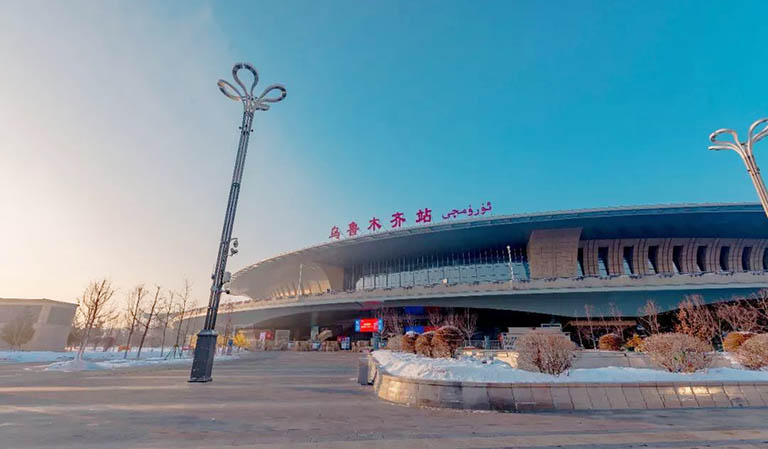
Urumqi Railway Station
Where to Accommodate and Recommended Hotels
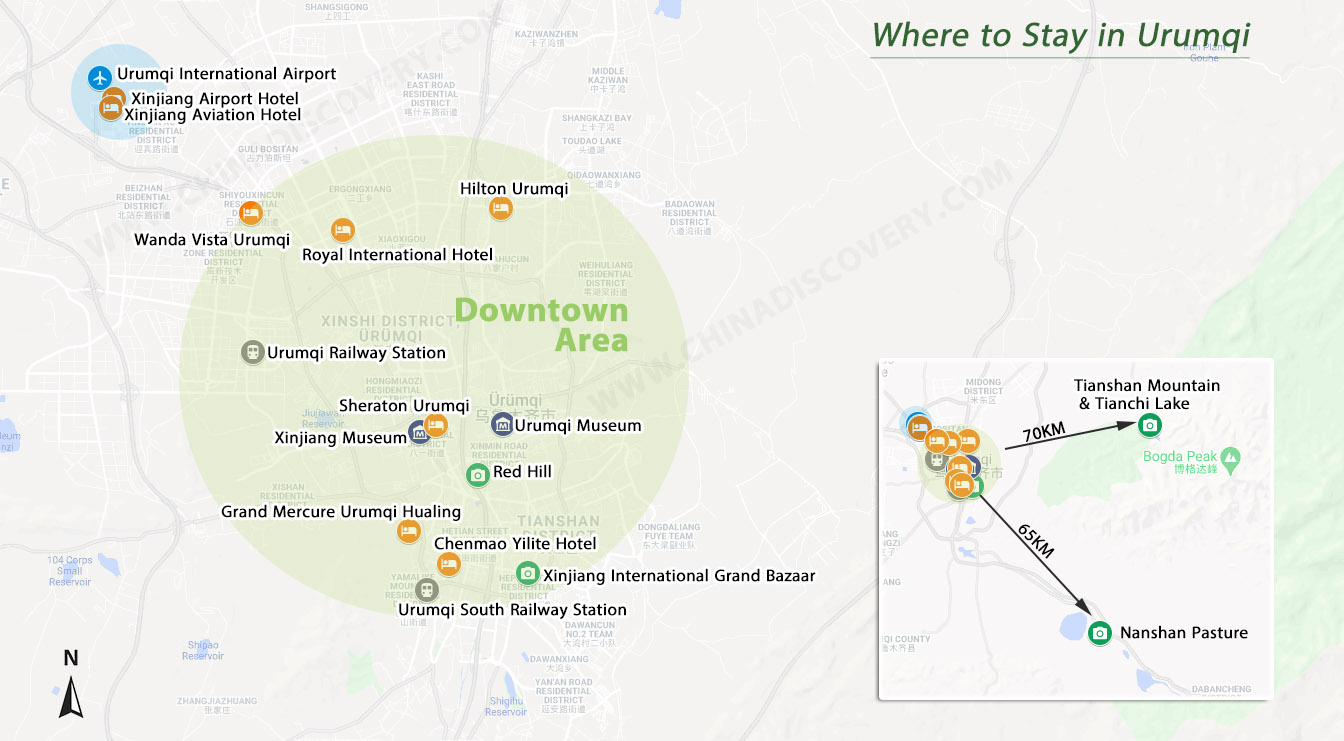
Map of Major Accommodation Areas in Urumqi
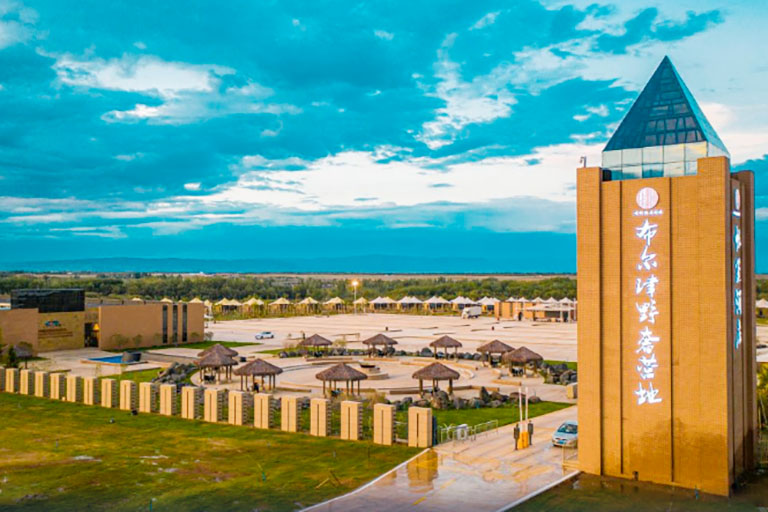
Burqin Kanas Baihualin Luxury Camping Site
Many cities in Xinjiang don't have plenty of luxury hotels, compared with the developed areas such as Beijing, Shanghai, Guangzhou, etc. However, it is easy to find comfortable accommodation in most cities. In Urumqi and Kashgar, you can find more kinds of hotels. However, the hotels in some remote areas may be in rather basic conditions.
Urumqi Accommodation: The major accommodation sites in Urumqi are the downtown area and the Urumqi Airport area. Accommodating in the downtown area, you can easily get to public transportation means, good restaurants and markets. If you need to take an early flight, accommodation around the airport is recommended.
Kashgar Accommodation: Kashgar Old City, equipped with different hotels, top scenic spots and many restaurants, is the main accommodating area for travelers. The choices in Kasghar are much less than in Urumqi, but you can easily find various hotels ranging from 5-star luxury ones to comfortable homestay as well. For travelers in Tashkurgan, there are also comfortable 3-star hotels available.
Turpan Accommodation: Turpan has several 5-star and 4-star hotels as well and most of them are located in the downtown area where there are many restaurants, shopping malls, snack streets around.
Kanas Accommodation: If you want to get quick access to Kanas Scenic Area, you can stay in Jadengyu near Kanas Ticket Office. Hemu Village also offers many homestays with a great environment. If you want to extend your tour to Koktokay, you can stay in Koktokay town near the geopark or Fuyun County.
Keep Reading: Urumqi Accommodation | Turpan Accommodation | Kashgar Accommodation | Kanas Accommodation
What to Eat in Xinjiang - A Bite of Xinjiang
Xinjiang cuisine is dominated by halal cuisine, but it also has the features of the cuisine of northwestern China. The main materials used in Xinjiang food are mutton, beef, camel, chicken, carrots, onions, peppers, eggplant, various dairy foods and fruits and they are made with fried, grilled, shabu-shabu, braised, sauced, grilled, and steamed ways. If you are a carnivore or a fruit lover, Xinjiang is a paradise for you.
Top Xinjiang Dishes: 1) Xinjiang-Style Braised Chicken - the top dish served on a big plate. It is an entire chicken cut up and cooked with potatoes, onions and other vegetables. 2) Uyghur Polo (Pilaf) - the quintessential food of the East. It is a tasty concoction mix of rice, carrots and lamb meat cooked in oil, quite popular among both travelers and locals. 3) Lamb Kebabs - lamb meat on a stick. There are meat and pieces alternating on the stick, usually seasoned with salt, ginger, scallions and pepper. 4) Lagman - featured pulled noodles. Also called Hui BanMian, Laghman is covered in a mix of meat and vegetables. 5) Naan - Uyghur Bread. It is a delicious type of flatbread baked in a special clay. Naan is great to carry on your long trip because of the dryness and no need for heat.
Top Xinjiang Fruits: Xinjiang is the land of melons and fruits. Many fruits of Xinjiang are famous all over China, even the whole world, including seedless grapes in Turpan, red apples in Aksu, sweet melons in Hami, bergamot pears in Korla and crisp jujubes in Hotan. Besides, it is possible to enjoy the best mulberries, figs, apricots, pomegranates, etc. There are many dried fruits which are easy to preserve and available to take home.
In numerous bazaars in Xinjiang, you can easily find some food and fruits to satisfy your appetite.
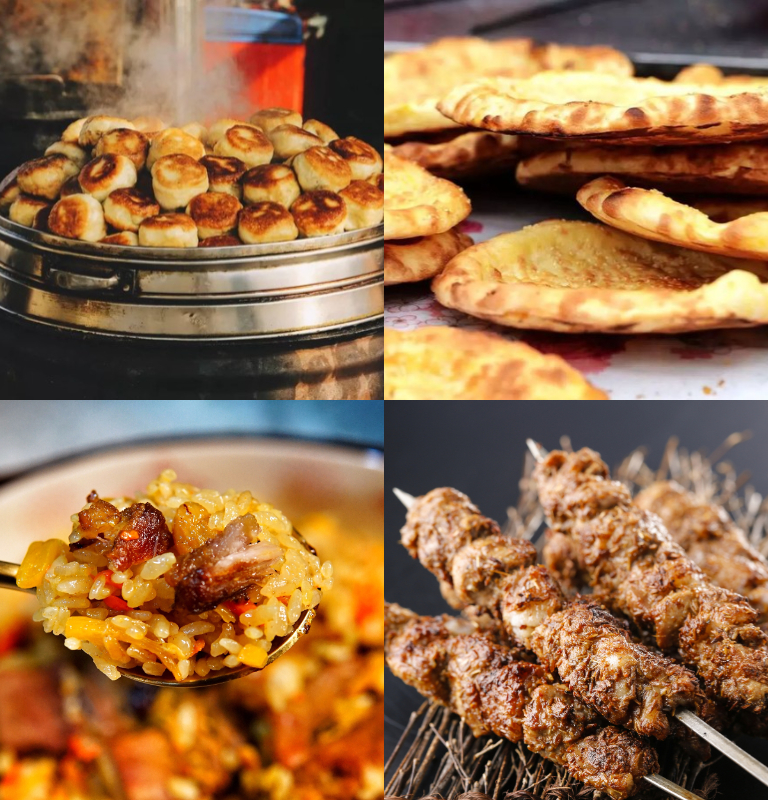
Popular Xinjiang Dishes
Other Xinjiang Travel Tips - Frequently-asked Questions
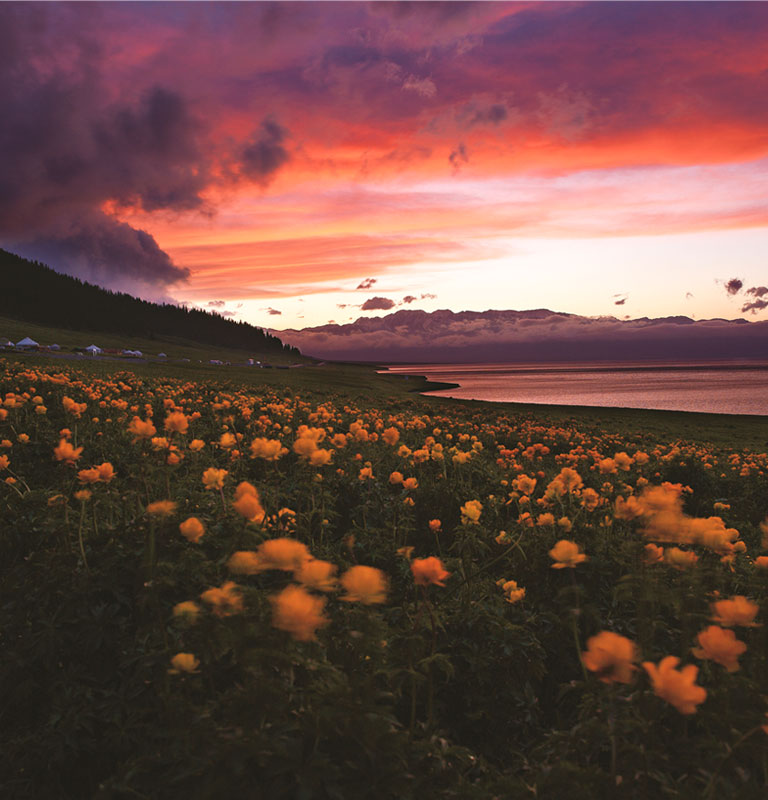
Sayram Lake Sunset (around 21:30 in May) ©slmhjq
◆ What documents do I need for a Xinjiang trip?
Except for passports and Chinese visa, there is no other special document needed for most destinations in Xinjiang. If you want to visit some border areas like Tashkurgan, you need a Border Pass - our travel guide will get everything ready for you.
◆ Can I cross the border and take an overland trip to Xinjiang directly?
Yes. Xinjiang in the westernmost China borders with several countries, and you can cross some borders and visit Xinjiang directly. Many travelers enjoyed an overland trip to Kashgar from Pakistan, Tajikstan and Kyrgyzstan. But the public transfer from the ports to Kashgar is inconvenient and you need to travel with a professional travel agency like China Discovery.
◆ Is it easy to get high altitude sickness during a Xinjiang trip?
In fact, few travelers get high altitude sickness in Xinjiang. But if you visit some high-altitude attractions (like Karakul Lake, Kanas, Karajun…) and it's your first time to the high plateau, you need to avoid strong activities and drink more water. Taking a full physical examination to make sure you are able to travel to the high plateau is also suggested.
◆ What do I need to pack for a Xinjiang trip?
The air is rather dry in Xinjiang, so you need to bring moisturizer and lipstick. Sunblock is also helpful to protect you from the strong sunlight and an extra coat is needed at night.
◆ Is there any difference between Xinjiang Time and Beijing Time?
Xinjiang and other provinces in China all use Beijing time (GMT+8). Because it is located in the westernmost part of China, the sunrise or sunset time in Xinjiang is about 2 hours behind in Beijing. The itinerary is usually organized between 10:00 ~ 20:00.
Keep Reading: Xinjiang Travel Tips & FAQs
Top Xinjiang Tour Packages for 2024/2025
China Discovery is a leading travel agency specialized in offering high-quality private tour packages to all travelers who have desires to have an authentic Xinjiang discovery. No matter how many days you plan to stay in Xinjiang, China Discovery always has a suitable tour for you. All tours can be tailor-made to fit you best according to your own interests, requirements, traveling time, etc. Below are the Most Popular Xinjiang Tour Packages 2024/2025. If you have no idea where to start, please feel free to contact our travel experts for help.
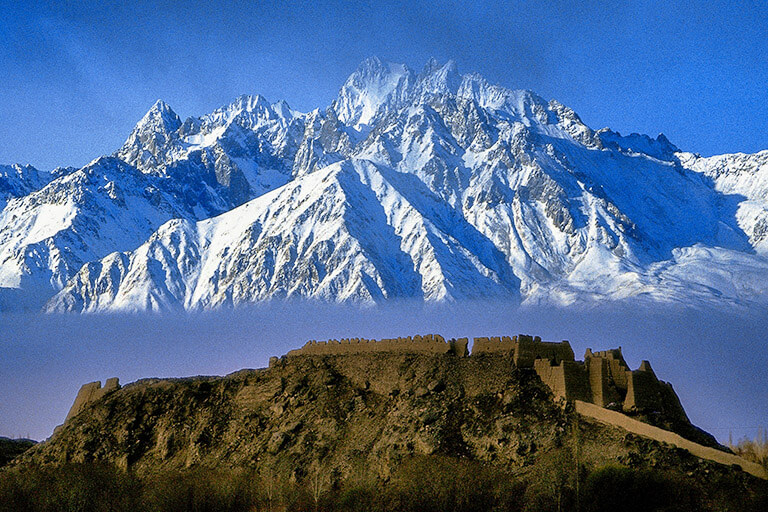
This is the most classic and enjoyable Xinjiang tour on which you will visit the Golden Triangle - Urumqi, Kashgar and Turpan to get the best Silk Road exploration and Xinjiang's best culture and nature.
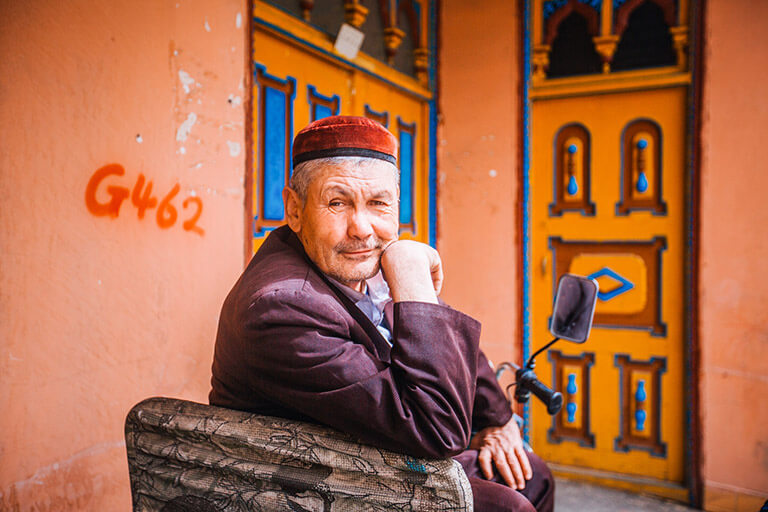
Follow both the southern and northern sections of Silk Road in Xinjiang, and be rewarded with splendid natural landscapes of mysterious Taklimakan Desert, azure Heavenly Lake and Karakul Lake, overwhelming Pamirs Plateau, etc. It is an in-depth Xinjiang vacation that covers vast highlighting area of Xinjiang, a memorable trip you won’t regret.
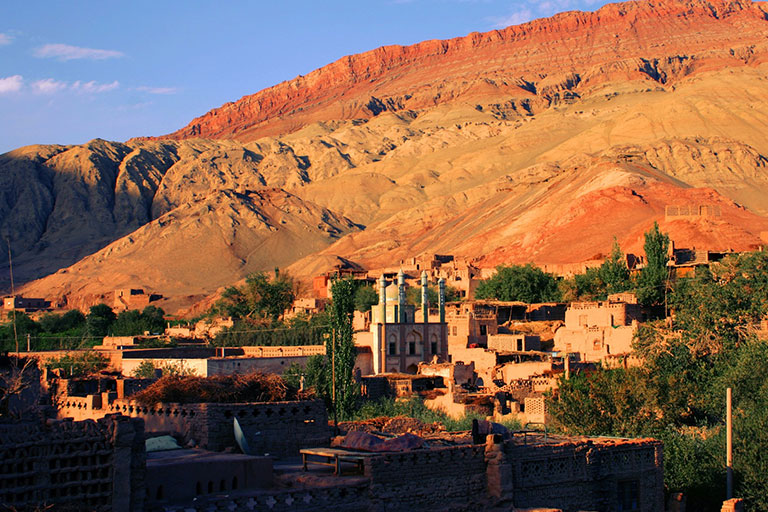
This is a time-and-money efficient tour on which you will start your tour from Urumqi and end in Kashgar with a well-arranged itinerary. You will have all the classic experiences in your pocket, and at the same time enjoy vacation-standard tour services. It is available all year around.
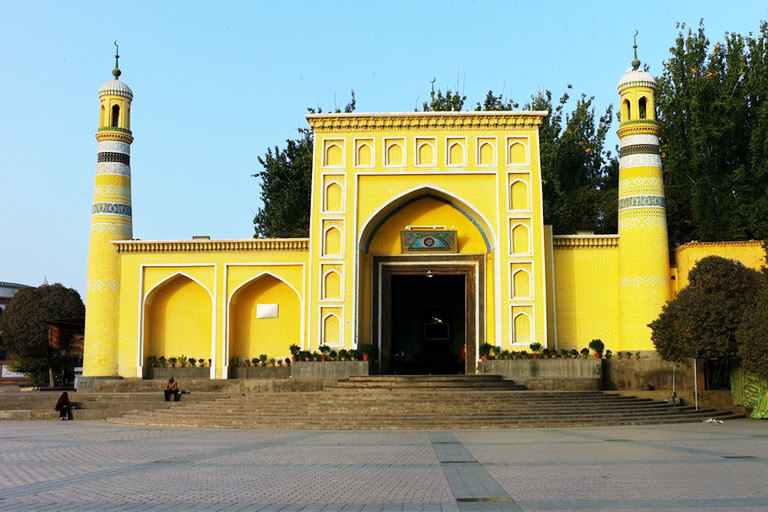
Urumqi and Kashgar are the two Must-go destinations for all the first-timers. They are the very essence of Xinjiang, no matter you are seeking for Silk Road history, authentic local culture, or marvelous scenery.
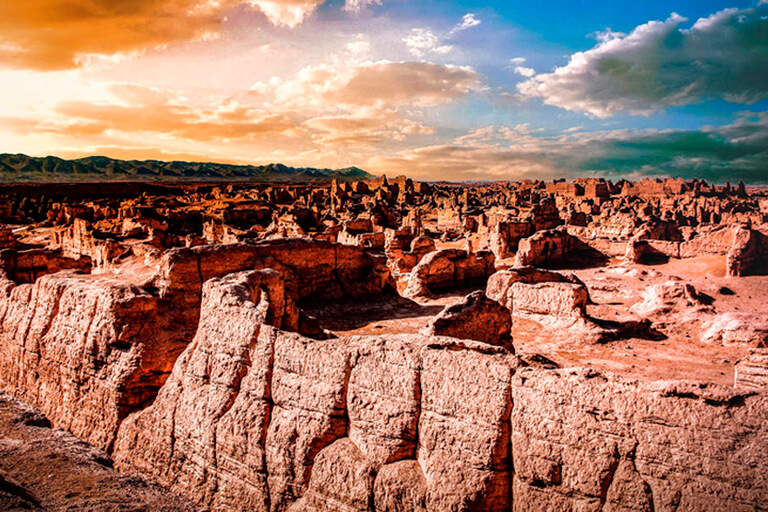
This is a unique Xinjiang tour, covering many featured experiences in Urumqi and Turpan which are two of the most recommended destinations in Xinjiang. Rather than exploring the most famous historical and cultural sites related to Silk Road and Xinjiang history, you will also be taken to try something different, something that is out of your expectation.
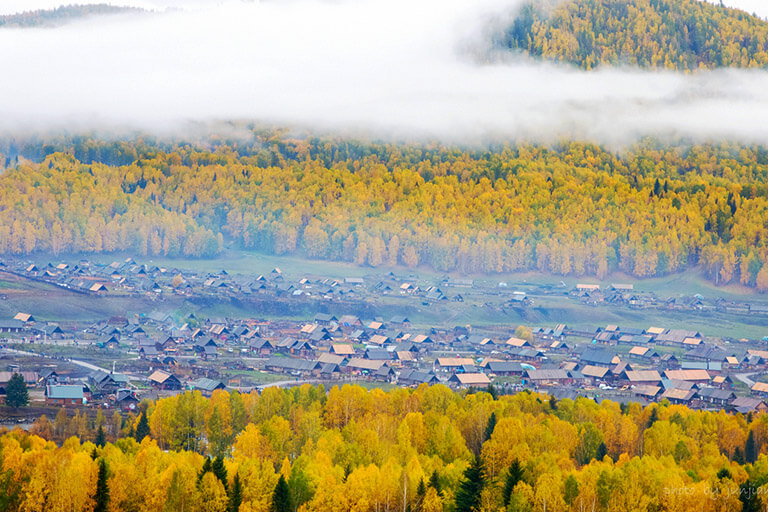
You will not only explore Kanas fully, but also get rewarded by many other natural wonders, such as jaw-dropping canyons, colorful Yardang landform, wild animal reserve, etc. Drive in and out by two different routes so that all your time and efforts won’t be wasted.
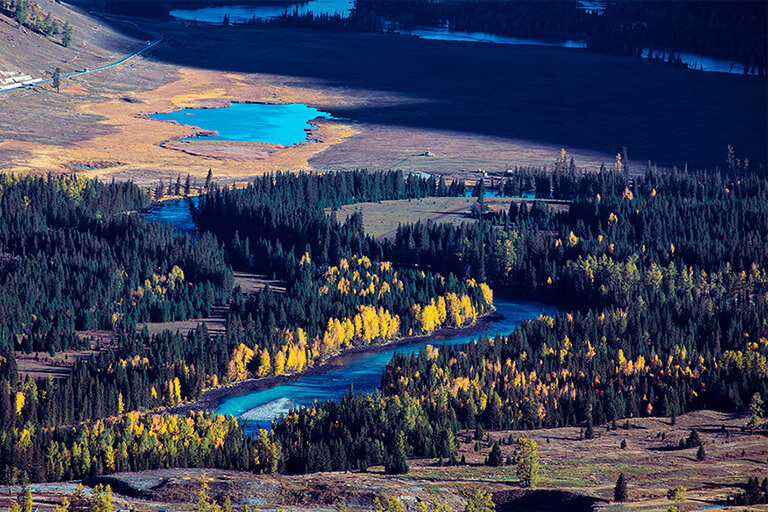
This tour takes you to explore the most beauitufl places in Xinjiang - Sayram Lake, Karajun Grassland, Kanas Lake, Hemu Village, Wu'erhe Ghost City, etc. in an affordable way.
Start planning your tailor-made holiday to China by contacting one of our specialists. Once inquired, you’ll get a response within 0.5~23.5 hours.

Have a question? Get answers from our travel experts or guests
- Your Question:
- Your Email:
- Affordable and valuable price
- 100% tailor-made packages
- Highly rated customers reviews
- Efficient customer support
China Tours
- Top 10 China Tours
- Classic China Tours
- China Tours from Beijing
- China Tours from Shanghai
- China Tours from Hong Kong
- China Tours from Chengdu
- Short China Trips
- Customize China Tour
- China Panda Tours
- Family Tour with Kids
- High-Speed Train Tour
- Silk Road Travel
- Yangtze River Cruise
- Hiking & Trekking Tours
- Photography Tours
- China Minority Travel
- Beijing Shanghai Tours
- Shanghai Yangtze Tours
- Chengdu Jiuzhaigou Tours
- Chengdu Lhasa Tours
- Suzhou Hangzhou Tours
- Guilin & Yangshuo
- Zhangjiajie
“Very good experience”
“WONDERFUL 25 DAYS IN CHINA - PRIVATE TOUR”
“Awesome China tour from northeast to southwest”
Any questions, please email us at: [email protected] or call us at: 86-19138970032 (Monday-Friday 9 a.m. to 6 p.m. GMT+8)
- Terms & Condition
- Privacy Policy
- Customer Support
Copyright © 2011-2024. All rights reserved.
Cookie policy
We use cookies to give you the best experience on our website. Continue using our website means you agree with our cookie policy. For more info, please read here .

Illustration: Chen Xia/GT

The international forum "The History and Future of Xinjiang, China" is being held in the renowned ancient Silk ...
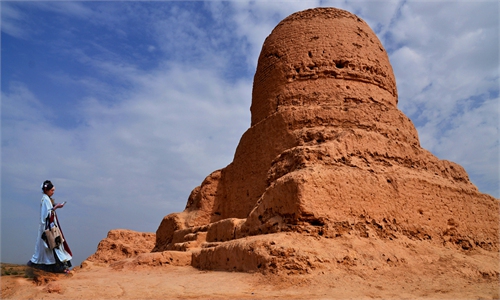
Experts and scholars from China and abroad kicked off visits to cultural relic sites in Xinjiang for further ...

Campaigners Urge UN Rights Chief to Act on China Xinjiang Abuse Report

Ethnic Uyghur demonstrators take part in a protest against the visit of Chinese Foreign Minister Wang Yi to the Turkish capital, near the Chinese consulate in Istanbul, Turkey July 26, 2023. REUTERS/Dilara Senkaya/ File Photo
By Emma Farge
GENEVA (Reuters) - Campaign groups called on the United Nations human rights chief to take more action over what they said were documented abuses against Uyghurs and other Muslims in China's Xinjiang region.
The groups, including the World Uyghur Congress and Amnesty International said UN High Commissioner for Human Rights Volker Turk had not followed up on a 2022 report by his predecessor that found China may have committed crimes against humanity.
After taking office in October 2022, Turk, a former lawyer, said he stood by the report and wanted to engage China over the findings.
"As the High Commissioner has made clear, he stands behind the UN Human Rights report on Xinjiang issued in 2022, and we are engaging with the government of China on a range of human rights issues, including in follow-up to the report," Liz Throssell, U.N. Human Rights Office spokesperson, said on Friday.
The August 2022 report, produced under the leadership of the last commissioner, Michelle Bachelet, said the extent of arbitrary and discriminatory detention of Uyghurs and other Muslims in Xinjiang may be an international crime.
China has repeatedly denied accusations of abuses in its northwest Xinjiang region. China defended its record and dismissed the campaign groups' statement given at a meeting in the Geneva headquarters of the U.N. Human Rights Council.
Just before Turk took office, mostly non-Western members of the Rights Council voted down a motion brought by the U.S., Britain and other mostly Western powers to hold a debate about the report - a result that was seen as a diplomatic victory for Beijing.
"To date there has been no action, no meaningful action," Zumretay Arkin, a spokesperson for the World Uyghur Congress, told a meeting on Thursday. "We are here to remind everyone ... that impunity cannot be the solution."
The campaign groups, also including Human Rights Watch and the International Service for Human Rights, translated the 2022 report into five languages, published them and called for Turk to give an update on how his office and China had responded to the report's recommendations.
China's attache at its mission in Geneva, Zhu Kexing, told the session: "In order to discredit China and hinder China's development, a small number of NGOs and Western countries do not hesitate to act as liars and rumour-makers to serve their anti-China separatist plots."
Several countries, including the United States and Australia, also voiced concerns about the lack of follow-up on the 2022 report but stopped short of giving specific recommendations on how Turk's office should react.
(Reporting by Emma Farge; Editing by Andrew Heavens and Barbara Lewis)
Copyright 2024 Thomson Reuters .
Photos You Should See - June 2024

Join the Conversation
Tags: United Nations , Switzerland , United States , Europe , Australia
America 2024

Healthiest Communities
Your trusted source for in-depth analysis on the issues impacting your community’s well-being delivered right to your inbox.
Sign in to manage your newsletters »
Sign up to receive the latest updates from U.S News & World Report and our trusted partners and sponsors. By clicking submit, you are agreeing to our Terms and Conditions & Privacy Policy .
You May Also Like
The 10 worst presidents.
U.S. News Staff Feb. 23, 2024

The Best Cartoons on Donald Trump
June 21, 2024, at 11:59 a.m.

Joe Biden Behind The Scenes
June 7, 2024

SCOTUS Upholds Gun Ban for Abusers
Laura Mannweiler June 21, 2024

A New Look at Women in the Draft
Aneeta Mathur-Ashton June 21, 2024

TikTok Comes to the DNC
Olivier Knox June 21, 2024

SCOTUS Update: Abortion, Guns and Trump

Leading Indicators and Home Sales Dip
Tim Smart June 21, 2024

Is SCOTUS On a Path to Irrelevance?
Lauren Camera June 20, 2024

Photos: Alberto Lashes Mexico and Texas
June 20, 2024
Jackie Chan’s ‘A Legend,’ ‘Paddington in Peru’ Among Bona Film’s China Release Slate Highlights – Shanghai
By Patrick Frater
Patrick Frater
Asia Bureau Chief
- Zhang Xinyang’s ‘Cold Water’ is Hot Pick at Shanghai Film Project Market 1 day ago
- Jackie Chan’s ‘A Legend,’ ‘Paddington in Peru’ Among Bona Film’s China Release Slate Highlights – Shanghai 2 days ago
- Malaysian Filmmakers, Academics Slam Expanded Censorship Rules: ‘Filmmaking Is Now a Dangerous Vocation’ 3 days ago

Related Stories
New bundles point to broadband’s growing power in svod packaging, kate winslet on going big with 'the regime,' those 'stupid' james cameron feud rumors and getting 'beaten up' by body-shamers: 'this s--- went on for years', popular on variety.
At a press event during the Shanghai International Film Festival this week producers said that a highlight of the film is its use of AI technology to recreate a 27-year-old version of Chan. Other elements of the film, including massive horse-back armies and thousands of soldiers in desert locations, were shot on location in Xinjiang without the use of CGI.
The event also revealed Bona as China marketing and distribution partner for StudioCanal and Heyday Films’ family adventure movie “ Paddington in Peru .” In parts of Europe, the film is due a November release. In others. it is due to arrive in cinemas in January 2025.
“A Dream of Red Mansions,” Bona’s reinterpretation of a Chinese classic “The Dream of the Red Chamber” is also set for a July release. Directed by Hu Mei from an adapted screenplay by He Yanjiang, the film started production in 2017, but was interrupted by COVID. Bona said that it is giving the title wide previews in over 50 cities ahead of its July 26 outing.
“Lam risked his life to get shots done for the film. I know this production will exceed the budget, and all I can do is help secure more investment for them, to ensure everything is done perfectly,” said Bona’s founcer, chairman and CEO Yu Dong, according to state media reports. He called it “a superb military action movie paying tribute to China’s navy.”
The firm is also readying TV series including “Battle of Shangganling” by Hong Kong’s Andrew Lau and “Lin Zexu” by Yin Li.
More from Variety
Vinyl version of beyonce’s ‘cowboy carter’ with the five missing tracks is finally on sale, at a higher price, how content spending will grow in the post-peak tv era, dolly parton hails beyoncé’s version of ‘jolene’ as ‘bold,’ says she would duet with her at the grammy awards, tanner adell, singer who got a big cosign from beyoncé, signs with lvrn records: ‘country is my foundation, but i want it to reach outside the walls of nashville’, the state of generative ai in hollywood: a special report, more from our brands, watch the killers cover new order, stone roses at manchester concert, lewis hamilton: the spanish grand prix usually tells you how good your car is, yankees, dodgers lead mlb’s ratings charge on fox and espn, the best loofahs and body scrubbers, according to dermatologists, roseanne’s sandra bernhard, morgan fairchild hash out on-set beef decades later, verify it's you, please log in.

COMMENTS
No independent foreigners in the tourist sites. No hotels for independent foreigners. Other travel limits in the „normal" part of Xinjiang. Forbidden areas in Xinjiang. The area at the border with the Tibetan Autonomous Region. Special natural areas. High mountain peaks. Natural reserves. Aksai Chin.
Xinjiang Travel Guide 2024. Xinjiang, short for Xinjiang Uygur Autonomous Region, is China's largest provincial region (nearly 1/6 of China's total territory) and one of the five autonomous regions for ethnic minorities. Urumqi is the capital of Xinjiang. Xinjiang is located in northwest China and hinterland of Eurasia, completely landlocked.
The short answer is "no," you don't need a special permit for Xinjiang. In fact, there are very few places where a travel permit is required in China. We as foreign tourists are technically allowed to move freely about Xinjiang at our leisure. Technically. The reality on the ground is slightly different.
Josh is the author of Xinjiang | A Traveler's Guide to Far West China, the most highly-reviewed and comprehensive travel guide on China's western region of Xinjiang. He lived, studied and run a business in Xinjiang, China for more than 10 years, earning recognition for his work from CCTV, BBC, Lonely Planet and many others.
Discovering the Best Xinjiang Tourist Attractions. 1 - Heavenly Lake (Tianchi) 2 - The Silk Road. 3 - Uyghur Culture and Cuisine. 4 - Karakoram Highway. Practical Tips to Travel to Xinjiang. Weather and Clothing. Transportation.
Xinjiang Uygur Autonomous Region travel information about location in China, climate, history and attractions in cities like Urumqi, Turpan, Kashgar, Hotan, Korla, Ili and Karamay. ... Generally, Singaporean passport holders can visit China visa-free for at most 15 days. If you want to stay longer, a Chinese visa is necessary.
Just keep in mind that Xinjiang is one of the biggest provinces and the travel distances sometimes long. Below I've included a summary showing the travel-times for various destinations from Urumqi: Kashgar: 20 to 23 hours Turpan: 1.5 hours Yining: 10 hours Hotan: 31 hours Kuqa: 11 hours Beitun: 12 hours Hami: 5 hours.
Half of China's ancient Silk Road is in Xinjiang. Along the Silk Road in Xinjiang, there were many fortified settlements, castles, grotto temples, tombs, and beacon towers. The best-preserved sites are the Gaochang and Jiaohe ruins near Turpan. Recommended tour: 11 Days Along the Great Silk Road. 2.
A woman relaxes in front of a vineyard at dusk. A man transports the region's prized seedless grapes. An Uyghur band perform at one of Xinjiang's many Byzantine-style restaurants. A collection of ...
Asia. China's largest province, Xīnjiāng (新疆) is the homeland of the Muslim Uyghurs and a fast-changing region where ancient and modern clash against each other in surprising ways. High-speed railways cross the Martian landscapes linking cities in hours rather than days, and the regional capital Ürümqi is a forest of high-rise ...
It's becoming incredibly easy to travel to-and throughout-the western reaches of China. And it's only going to get easier, as China recently announced plans for rail connections between ...
Summers can be hot, especially in the desert regions, while winters can be extremely cold, particularly in the mountainous areas. But if you want to go skiing in Xinjiang, winter is the best season. Getting there and travel around in Xinjiang Urumqi Diwopu International Airport. You can reach Xinjiang by air, with Urumqi being the main entry point.
The Uyghur Human Rights Project, or UHRP, based in Washington, said in a January report that at least 18 European travel companies offer tours to sites in Xinjiang connected to the repression ...
Best Times to Visit Xinjiang for Best Weather: May and September. May is the height of spring and September heralds autumn in Xinjiang, offering delightful weather with average daytime temperatures ranging from 24-26°C (75-79°F) in May and 22-27°C (72-81°F) in September.. There is scarce rainfall in these two months, typically fewer than 7 rainy days in May and fewer than 5 rainy ...
In general, Xinjiang is safe to travel if you take the usual precautions. Keep track of your things, although it is unlikely that someone will rob you. However, bad people are everywhere. It is customary to bargain at the bazaars, and you can safely do it. The price of goods is usually very high initially.
Here we have listed Top 12 Xinjiang Destinations to go to, and each of them has its unique flavor. Just feel free to pick your favorite destinations and customize a Xinjiang tour according to your own style. Quick Jump to: Top 1: Kashgar. Top 2: Turpan. Top 3: Altay (Kanas) Top 4: Urumqi. Top 5: Hotan.
Content Preview. 1. Meet the Most Beautiful Side of Xinjiang in Kanas. 2. Recall the Scenes in the Film Kite Runner in Kashgar Old City. 3. Take a Visit to Heavenly Lake. 4. Appreciate Apricot Flowers in Ili's Xinghua Valley.
Xinjiang Travel FAQs & Tips 2024. Xinjiang is far in the very west of China, inhabited by many ethnic groups, which is quite different from the plain areas of China in terms of weather, religious tradition, etc., so it is necessary to make a good strategy in advance. Weather & Scenery: When Is The Best Time to Visit Xinjiang
You can go through a Xinjiang travel agency such as Old Road Tours, but they will require you to purchase a multi-day tour from them. You can purchase the FarWestChina Xinjiang travel guide, which gives you access to a travel forum with hundreds of other Xinjiang travelers who can tell you what is/isn't open. In most cases, a permit is issued ...
Simple answer, no. The Xinjiang Autonomous Region is not like Tibet, where foreigners need a permit to enter. We are free to visit and move around as we please. Within reason. The big cities like Urumqi, of course, are no problem, but once you get into the smaller towns in the border areas and south of the Taklamakan Desert, you may find the ...
Yes, you're allowed. Go to any travel agent and ask for packages. You don't have to join a tour group, but I think there is some special paper work to do for visits to XJ and Tibet. Reply. Electrical_Swing8166. •. Tibet yes. You need a Tibet Travel Permit and to be on an approved tour. Xinjiang no.
There's no special permits required for Xinjiang. If your "student resident permit" is a Chinese one you can visit Xinjiang. Be prepared for the extra security checks. 18. Reply. RaymonKK. • 5 days ago. You're good to go, but make sure your hotel accepts foreigners. 12.
Learning more about the history of Xinjiang can let the world see that the development of the region has been deeply influenced by diverse cultures and religions historically. More important, it ...
How To Plan A Trip To Xinjiang: Xinjiang Trip Planner 2024/2025. It is impossible to travel to Xinjiang but not be awestricken by its long-lasting cultural fragrance of the ancient Silk road, scenic beauty of diverse landforms, as well as the colorful life of the ethnic minority groups. Owning an unmanageable wealth of attractions, Xinjiang offers explorers a once-in-a-lifetime journey.
Walking through the Ancient City of Kashi, visitors can see a variety of shops and stalls everywhere, including various traditional Uygur pottery, food, handicrafts and even musical instruments ...
Reuters. Ethnic Uyghur demonstrators take part in a protest against the visit of Chinese Foreign Minister Wang Yi to the Turkish capital, near the Chinese consulate in Istanbul, Turkey July 26, 2023.
Jackie Chan's 'A Legend' and import title 'Paddington in Peru' are among the highlights of Bona Film Group's China releasing slate.